11 Best Academic Writing Tools For Researchers

For many people, the academic writing process can be a daunting and exhausting experience. Papers and reports can take hours or days to complete and require intense dedication to perfect. However, there are tools that can make the process much easier for those who need them most.
If you find yourself struggling with long-form writing projects, these tools will help you work smarter instead of harder.
This article is organized into roughly 3 stages of writing:
| 💡Use to get unstuck – ask it to brainstorm or write an outline for you ✍️ Use or to check and edit your paper 📖 Use to rephrase or summarize your research 🤓 Check your essay readability with 📁 Use or to organize your manuscript for your masterpiece |
Table of Contents

I. Best Writing Software for Researchers
#1. jasper (formerly jarvis) – game-changing ai writing bot.
This tool is relatively new. And, I have become a heavy user. I can see how this tool will be VERY useful for knowledge work like professors and researchers. It takes a bit of a learning curve to master the tool. But, it’s absolutely worth it.
Update: Jasper is giving a one-off 10,000 words for free for five days to our readers. Check it out before it expires.
#2. ProWritingAid – Your paper enhancer before submission
The rephrasing tool allows me to improve any sentence in just a few clicks. The AI-powered grammar checker catches even the trickiest mistakes, ensuring my ideas shine without any easy-to-miss errors.
Overall, ProWritingAid is a powerful tool that can help you produce quality writing quickly and efficiently.
#3. Trinka – Designed for Academic and Technical writing
We have been testing Trinka recently and fell in love with it. Trinka is founded by Enago, an established academic service provider. So, they are well-versed in the needs of academic papers or technical writing.
We are also delighted to see its Publication Readiness feature included in the free plan. If you have issues with publishing your paper, chances are something is wrong with your manuscript. This Publication Readiness Checker may just be that difference maker.
#4. Hemingway Editor – free and powerful
It highlights problems with your writing based on the idea that dense, complex sentences are hard to understand. The program takes these long, winding sentences and breaks them into chunks with periods in between.
II. Best Re-Writing Software
#1. quillbot – best paid option for the professional .
One of the primary strengths of this tool is that it uses machine learning to understand, reword, restructure, and improve on the paraphrases it makes. Besides paraphrasing and cutting your writing time, QuillBot offers a built-in thesaurus function to help you find the perfect word every time and change individual words.
#2. WordTune – The most convenient option
We tested Wordtune and find the Quillbot to be a more powerful tool with more functions mentioned above. Who knows, Wordtune may change after seeing user feedback like ours one day.
#3. Spinbot – Best free option for starters
Iii. 3 best writing organization tools, #1. scrivener – best for academic researchers.
Scrivener is great for researchers who need to handle a large volume of research. Academic writing is more complicated than a grad school writing assignment. This tool costs a little bit of money. But, many top researchers use it for their research papers.
#2. Authorea – Best for Alternative Publication and Exposure
One of the best features is that Authorea officials allow you to publish your work on their website, free of charge. You can also get a DOI from them so it’s easier for people to cite your original research paper.
#3. Reedsy – Best for Aspiring Best-Selling Authors
Reedsy’s eBook Editor has all the features of an advanced word processor, meaning you can write your eBook with the same high-powered tools that are used by best-selling authors.
#4. LaTeX – Great tool but difficult for non-coder
Download the LaTeX program here , and don’t forget to check out our guide on how to use it here .
#5. DraftIn – Minimalistic and free for laser-focus writing
I work with other people all the time, using Google Docs. But, sometimes there are issues with version control. This tool solves that problem by holding the version updated by the user in the user’s environment. So, you should review it first before accepting it.
Final Thoughts
The best academic writing tools don’t have to be expensive or complicated.
Why should I use LaTeX?
One big caveat is that the learning curve is quite steep. So, be sure to check out our tutorial here .
What are the best tips for academic writing?
What are the tools for effective writing.
Brainstorming is often part of drafting a paper in rhetoric, but in these earliest stages, it is also about figuring out one’s attitude toward the subject at hand. Who am I writing this essay for? Who am I disagreeing with? What are they saying about my topic that I need to refute – all this has implications when deciding where to look next or what hypothesis to pursue.
10 thoughts on “11 Best Academic Writing Tools For Researchers”
Does quiltbot,save the changed text on its server, and then creata the problem of plagerisim.
Here is what it says about its plagiarism checker: “QuillBot stores your content in order to run the plagiarism report, so you can access your reports in the future. Our third-party vendor, CopyLeaks, does not store your content. QuillBot will never share your content with any third parties outside of CopyLeaks.”
Please provide information on resources for systematic review and meta-analysis; for conducting literature review
No it does not
i am a research scholar.i request you to kindly let me share information on rewrite cum plagiarism check, removal tool for best performance. Thank you all
Thank you, Dear Writer. It’s very much helpful.
These are very important for research students. Thank you very much for this piece of information. Great work Joannah.
Thank you for the kind words!
Thanks for sharing this well-researched article.
Nice article, might I suggest Writefull also, they have a number of tools designed for academic/technical writing…
Leave a Comment Cancel reply
✨ Enrol by 3 July to get access to our Summer Writing Accelerator at no additional cost! 💰 ✨

19 Academic Writing Tools (that are completely free!)

A selection of tools for academic writing – from collaborating, time-tracking and project management to finding the perfect phrase or translation. We are continuously updating this list (latest update: April 2023).
I often get asked about my favourite academic writing tools. That’s why I compiled this scientific tools list for you with 19 great tools to support your academic writing. You can use all these scientific research tools for free and some of them have paid versions with additional features.
Just one word of caution: Exploring new academic writing tools can be a time-suck and distract you from getting your actual writing done. If you are one of those people who spend hours signing up for new software for academic writing and getting it set up, only to abandon the tool a few days or weeks later – then be careful reading this scientific tools list, and don’t get overenthusiastic. 😉
By the way, I don’t have any affiliation with any of the academic writing tools listed below, and none of these are affiliated links.
Here, we go, 19 tools for academic writing and scientific research I recommend in no particular order:
ACADEMIC Writing tools
1. writefull.
This proof-reading tool for scientific texts is powered by AI and big data. You can integrate the Writefull app into Word or Overleaf for free. A reader of the blog brought my attention to this tool (thank you so much!) and I’ve only recently started using it, so I can’t give you a full-blown review just yet but so far the results are promising. Writefull is owned by Digital Science, a company that has released several Open Science apps, such as figshare, Overleaf and Altmetric.
2. Phrasebank
Created by Dr John Morley from “The University Language Center” of Manchester University, the Phrasebank is a database of common phrases used in papers, dissertations and grant proposals – a real goldmine!
The phrases are organised both by the common sections in a paper such as the Introduction, Methods, Results or Discussion section. For example, in the tab for the Introduction section, one can find entries for “establishing the importance of the topic for the world or society” or “identifying a knowledge gap in the field of study”. If you click on the latter, you can find among others the following suggested phrases: “It is still unclear whether…”, “However, the behaviour of X has not yet been investigated” and “Causal factors leading to X remain speculative”.
You can also look for phrases by choosing a general language function. Some of the choices are “being cautious”, “describing trends”, “signalling transition”.
The Phrasebank is very useful to get inspiration for new wording but I do not endorse all entries. Sometimes you find language that is a bit clunky or overly complicated so do use your own judgement when you browse this academic writing tool. PS: You can also download the Academic Phrasebank as PDF or Kindle file.
3. Thesaurus.com
If you’re looking for synonyms, thesaurus.com is the best online thesaurus I’ve found so far. It divides the synonyms based on different meanings of the word and indicates the relevance of the synonym by using three shades of orange.
Just one word of caution: Don’t fall into the trap of using too many synonyms in your academic writing. Being precise is so much more important than varying the words you are using in your writing. In particular for field-specific terminology, I advise against using synonyms .
This is a hot tip for researchers who need to transcribe interviews (hello, social scientists!), who like to record research ideas or those who like to write by dictating text into their phone. Otter is an AI-based transcription tool that works for English language recordings. The quality of the transcriptions is comparable to other transcription services using AI, meaning they are often not accurate and can give nonsensical, even comical results — especially when the recorded voice has a strong or unusual accent. Still, the automated and quick transcriptions (real time transcriptions are available too!) can be a good starting point and are a huge time saver. What’s cool about Otter compared to its competitors is that they give you 300 minutes of transcriptions per month for free!
There are many online dictionaries but Linguee is my favourite for academic writing. It suggests a translation on the basis of previous translations published on the internet. Therefore, this dictionary is especially great if you’re looking to not only translate a word but a certain turn of phrase or idiom. Linguee translates to and from English in over 20 languages. An essential academic writing tool for all non-native English speakers!
ACADEMIC WRITING TOOLS FOR Collaboration AND CO-WRITING
6. authorea.
The magazine “ TechCrunch ” describes Authorea as “a Google Docs for scientists”. On the academic writing platform, you can write, edit, and insert citations, figures and data. And it’s great for collaborative writing: Co-authors can access the same text at the same time, track the changes they made, insert comments and even live-chat during writing sessions. Documents can be imported from LaTeX and Word and exported as LaTeX, Word and PDF documents. You can also submit your article as a bioRxiv preprint straight from the Authorea platform. This software for academic writing is free for up to ten documents with limited sharing options.
7. Overleaf
Overleaf is to LaTeX users, what Authorea (see tool #6) is to Word users: an online editor that allows you to access and collaborate on your writing projects from anywhere. You can, for example, invite others to comment on your work. Overleaf offers some other neat collaborative writing features, such as a track-changes function, but – unfortunately – only on the paid plan. LaTeX may seem a bit intimidating at first but you actually get the hang of it quite fast (and feel like a coder 😎). Also, in my experience, you save a lot of time formatting your text (and feel smug about it when you talk to Word users 😁).
Slack is a chat tool that you can use in your lab or with your collaborators. Used in the right way, it allows you to save time by cutting down on emails and create a group atmosphere even if the members are not working in the same location. You can easily add files to the chats and create different channels for subgroups or certain topics. There also exist virtual communities on Slack you can join, such as the New PI Slack community for Assistant professors around the world.
Loom is a great scientific research tool when you want to share a quick video with a colleague, student or collaborator. This could be a recorded presentation or lecture, your comments on the paper of a co-author, or a tutorial on using a piece of software. You can record your screen, camera and microphone. The neat thing is that after you’re done recording, Loom auto-generates a link you can share.
Academic writing tools for Productivity and project management
Toggl is a time-tracking app that you can install on your phone and computer. There’s only one way of knowing how long certain writing tasks typically take you, and that is by tracking the time they took you to complete . Time-tracking has another great advantage: You can identify time-sucks in your day. And these may be less obvious than you think.
I like to use Toggl for time-tracking because it’s quick to use and integrates with various other scientific research tools I am using. You just need to click the big red power button to start or stop a recording and assign tracked times to different projects. This scientific research tool has paid plans but for most people the free basic plan will be sufficient.
Are you easily tempted to check your phone when you really should be writing? This app called Forest may be just right for you then. Once installed on your phone, you can start planting a virtual tree whenever you want to focus. It grows from a little plant to a full-grown tree. When you pick up your phone and leave the app, the tree dies. This way, you can build your forest representing the time you have spent on focused work (or quality time with your family and friends…). I’m not using Forest myself, but I’ve heard that it works really as an academic writing tool well for some people. Give it a go!
12. Focusmate
As Forest (see tool #11), Focusmate is an app to help you stay focused. Instead of gamification, the concept of Focusmate is based on social accountability. Here is how it works: You schedule a 50-minute virtual co-writing session with another Focusmate member, turn on your webcam when your session starts, greet your temporary co-worker and then get to work silently.
Even though being filmed while working is a little strange in the beginning, co-writing sessions work really well for a lot of researchers. This is why we offer co-writing sessions as part of our academic writing program, the Researchers’ Writing Academy, as well.
13. Cold Turkey
If Forest (tool #11) or Focusmate (#12) don’t get you to focus on your writing, you may need to go Cold Turkey . This software for academic writing blocks any other application and turns your computer into a typewriter. You can choose whether you want Cold Turkey to prevent you from digital distractions for a certain amount of time or until you’ve hit a certain word count. With the paid version, you can even access integrated productivity soundtracks and text formatting.

Not an app exactly, but free as well: Click the orange button below to have me walk you through my step-by-step system to write clear & concise papers for your target journals in a timely manner . This free academic writing training is perfect for you if you’re reading this blog post because you are procrastinating on writing your paper.
Trello is an excellent project management tool for your academic writing, which you can use for managing each of your writing projects, for creating a publication pipeline and as a daily and weekly to-do list. Trello is a great introduction into project management because it’s a lot easier to learn and use than most other project management software. For each project called a “Board”, you can create different “lists”, which are vertical collection of “cards”, which you can move between lists. You can add due dates, checklist lists, links, files and text to each card. To work collaboratively, you can leave comments on cards and assign them to members on your team. You can also use Trello as a brainstorming tool, using the cards just as you would use post-it notes.
Members of my online course, the Researchers’ Writing Academy , get access to Trello templates I created to easily manage their publication pipeline, the writing process for each of their scientific papers and all of their other daily, weekly and monthly tasks and projects.
15. Todoist
Todoist is an alternative to Trello (see tool #16) or can be used in addition. It’s an online to-do list organiser and project management tool that comes as an app and browser version. You can organise your tasks in projects and schedule them for a certain day. This academic writing tool shows you today’s tasks as well as those for the next seven days. It also tracks your productivity, i.e. how many tasks you have completed.
academic writing Tools for finding and reading the literature
Feedly is a neat RSS feed manager that helps you stay up to date with the scientific literature. Instead of getting email alerts from journals (because who wants to get more emails…) you can view and organise the literature you are interested in by following journals’ RSS feeds. You can not only use this for scientific literature but also subscribe to blogs, for example the one you’re reading right now, by simply putting the URL in the Feedly search: https://annaclemens.com/blog .
Are you a mindmapper? Then you need Xmind , a free mindmapping and brain-storming tool. It’s intuitive, looks good and does exactly what you want a mindmapping tool to do. The free version allows for embedding of hyperlinks, images, attachments, so you can really use it however you like! That’s all I can really say about it as I’m not using mindmapping myself. But I know scientists who swear by it!
18. Audemic
Audio formats have become so popular (I’m a big podcast lover myself!) so it shouldn’t really come as a surprise that there now is an audio tool available for the scientific literature too: Audemic . This tool — completely free to use for individual researchers — creates summaries for you (that go beyond the abstract), lets you skip sections, highlight text and take notes while listening.
There are a few reference managers for your academic writing to choose from, some of which cost money. Zotero is free, open-source and doesn’t lack in functionality. You can easily save references from your browser, organise them in folders and with tags and create bibliographies with the right style. You can also create a citation library with your co-authors or share your library with others.
That’s it: 19 academic writing apps and scientific research tools to support your writing for free! However, the best academic writing software won’t make you more productive if you don’t rely on a streamlined writing process and if you aren’t using your writing sessions effectively. If you want to get your hands on a template to write scientific papers in a systematic fashion, sign up for this 1-hour writing training now. It’s free too!

Share article
© Copyright 2018-2024 by Anna Clemens. All Rights Reserved.
Photography by Alice Dix
8 useful research paper writing tools and resources
Academic writing can be a daunting and time-consuming process, but with the help of the right tools you can make writing your paper much easier.
In this post, we have pulled together 8 tools and resources that will help you work better and smarter when writing a research paper.

Our downloadable comprehensive free guide: Writing your paper
Todoist: A to-do list to organize your work
Evernote: As a research notebook
Grammarly: Cloud based typing assistant
Ref-n-Write: Look up and learn while writing your paper
Hemingway Editor: Refine your work to be bold and clear
Our downloadable article and journal templates
Our 10-point checklist to guide your writing process
Writing your paper: a comprehensive free guide
If you’re ready to start writing your paper, our Writing your paper free guide is a useful tool to help you through your various writing stages.
This resource will guide you through writing your paper from start to finish, including preparation and setting your structure, to writing every section of your paper and preparing it for submission.
Post information
Related posts, insights topics.
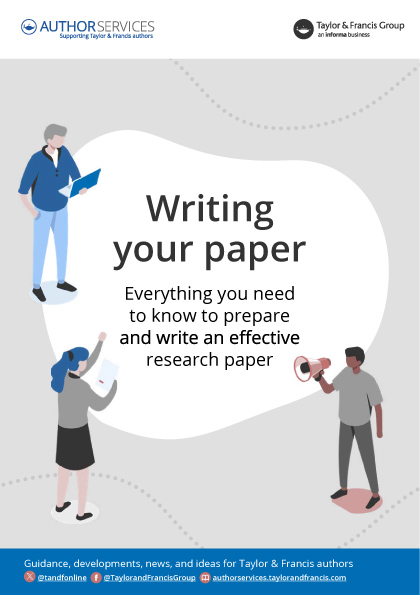
Read the guide to find out all you need to know about:
Article structures and formatting
Choosing keywords and writing for SEO
How to write your research manuscript
Refining your writing
Finalizing the details of your paper
Considering ethics
Download your free guide today for guidance on how to navigate the article writing process.
Todoist is a task management app that can help you stay organized during the writing process.
Writing an academic paper is not just about putting the words on paper. In fact, some researchers might argue the writing is one of the easier parts! Your tasks before you start writing are also critical to your writing success.
If you’ve read our Writing your paper free guide , you’ll know that it’s important to prepare before you start writing. You need to organize your thoughts, materials, and the steps you plan to take to prepare your article for submission . This is where Todoist comes in.
Todoist can be used for planning, scheduling, and building the outline for your personal, work, and academic tasks. Part of its appeal is its simple functionality and portability.
It can be used on your phone, tablet, and computer with great collaboration and integration capabilities. This could be like having your personal assistant with you at all times.
Todoist is free to use, but for higher project limits or additional features like reminders, you can decide if you need an upgraded paid version.
An example of a simple outline:
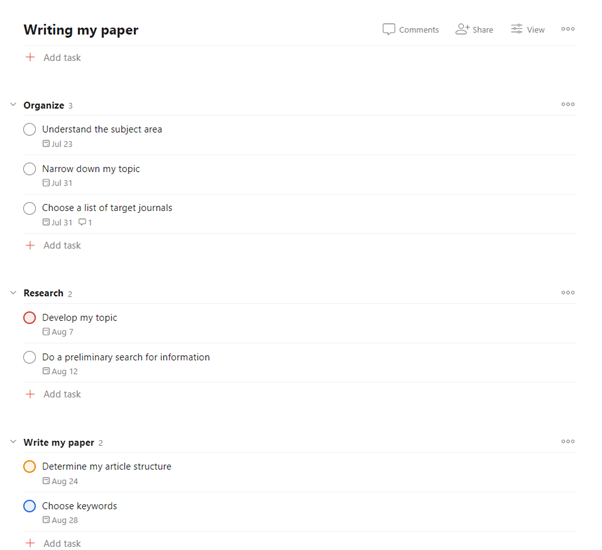
If you’re looking for a productive way to take notes and sort through your research materials, Evernote can be a useful tool to consider.
You can organize your research by creating a notebook structure to keep similar notes together. You can also make your notes more useful by adding texts, images, and documents.
Another useful feature is capturing audio notes with the inbuilt recorder. It’s easy to share and discuss your notes and notebooks, without having to leave the Evernote app.
Keep in mind you can also seamlessly create Todoist tasks from Evernote notes, and vice versa to double your productivity.
The basic version of Evernote is free and lets you create unlimited notes but with a limitation of storage space to 60MB a month. For more storage you will require to upgrade to a paid subscription plan.
Here’s what it might look like to get started:
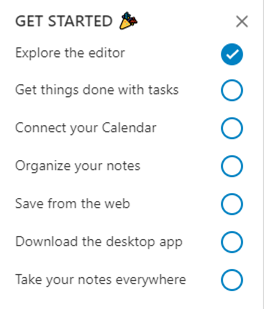
Grammarly is a typing assistant that uses artificial intelligence to identify any errors in spelling, grammar, and punctuation, then suggests an appropriate replacement.
When you install it on your laptop or computer, it will flag any errors in your text and provide you with an alternative, or even prompt you to remove particular phrases.
Keep in mind that your paper might contain technical terms or phrases that Grammarly may not understand, which could be flagged as errors. So, make sure you look over the prompts from Grammarly before accepting changes.
The basic function of Grammarly is free, which helps identify most spelling and grammar errors, but for a more robust check on everything you write, a paid upgraded premium version is available.
Also, you could consider using a professional academic editor , who will make sure your manuscript meets scholarly English standards.
Ref-n-Write
High-quality research deserves proper academic writing. Ref-n-Write is a tool with an impressive library of phrases used in academic writing. Using artificial intelligence technology, the tool provides details on choosing the right academic phrase, cross-referencing previous work, suggesting new ideas, and more.
Non-native English speakers may find this tool helpful to paraphrase their text and improve their English writing skills through practice. To test out the referencing, paraphrasing and phrase bank tools, you can sign up for a free trial.
Don’t allow language be an issue in getting your research published. Please read this guide for more information on how to break language barriers and publish in international journals .
Hemingway Editor
Hemingway Editor is an editing tool that can help you refine your writing, pinpointing areas of your work that will affect readability. Clear writing is important to communicate your research effectively to readers.
This tool also guides you on how to improve the sentences in your document. It highlights sentences that are hard to read, words or phrases with simpler alternatives, passive voices, as well as the number of adverbs present in your work.
Hemingway App has a free version but it also has a paid version with additional features for publishing, formatting and more .
For confidence about the quality of your paper, also consider the extra step of using experts in subject-relevant editing . They will make sure your work is free of grammatical, spelling, and other common language errors.
Article and journal templates
To save you time, our downloadable article and journal templates are a useful resource for formatting your manuscript. Our template will help you format your work correctly for submission, and make sure you have the information the target journal expects to see.
Make sure you download the relevant template and apply it to your research paper, following the instructions provided.
Remember to follow the instructions regarding your specific research article’s format. Here’s a guide on the variety of different types of research articles .
You can also focus on your research and save valuable time by letting experts in academic formatting look after the format of your manuscript.
Writing your paper checklist
This checklist is a useful resource to help you quickly review all you need to write an effective paper.
Whether you are writing a paper for an assignment or to submit to a journal, this list contains important information on what makes a good research paper .
Follow the steps in our 10-point checklist, to help guide how you plan and organize your research to write an impactful paper.

Download the writing your paper free guide
Get a head start in your paper writing with this free guide.
You will have a blueprint to help you produce an impactful research paper.
English Language Editing
Improve your written English with editing from subject-matter experts.
Academic Translation with Editing
Translate your research to reach a wider community.
Article Formatting
Get your reference, citation and layout formatting checked by experts.
Where to next?
If you’ve found these tips helpful make sure you look at:
Writing your paper free guide – download this free guide to help you through your various writing stages.
Our Insights newsletter – the latest news, tips, and resources delivered straight to your inbox.
Share this post on social
Top 21 must-have digital tools for researchers
Last updated
12 May 2023
Reviewed by
Jean Kaluza
Research drives many decisions across various industries, including:
Uncovering customer motivations and behaviors to design better products
Assessing whether a market exists for your product or service
Running clinical studies to develop a medical breakthrough
Conducting effective and shareable research can be a painstaking process. Manual processes are sluggish and archaic, and they can also be inaccurate. That’s where advanced online tools can help.
The right tools can enable businesses to lean into research for better forecasting, planning, and more reliable decisions.
- Why do researchers need research tools?
Research is challenging and time-consuming. Analyzing data , running focus groups , reading research papers , and looking for useful insights take plenty of heavy lifting.
These days, researchers can’t just rely on manual processes. Instead, they’re using advanced tools that:
Speed up the research process
Enable new ways of reaching customers
Improve organization and accuracy
Allow better monitoring throughout the process
Enhance collaboration across key stakeholders
- The most important digital tools for researchers
Some tools can help at every stage, making researching simpler and faster.
They ensure accurate and efficient information collection, management, referencing, and analysis.
Some of the most important digital tools for researchers include:
Research management tools
Research management can be a complex and challenging process. Some tools address the various challenges that arise when referencing and managing papers.
.css-10ptwjf{-webkit-align-items:center;-webkit-box-align:center;-ms-flex-align:center;align-items:center;background:transparent;border:0;color:inherit;cursor:pointer;-webkit-flex-shrink:0;-ms-flex-negative:0;flex-shrink:0;-webkit-text-decoration:underline;text-decoration:underline;}.css-10ptwjf:disabled{opacity:0.6;pointer-events:none;} Zotero
Coined as a personal research assistant, Zotero is a tool that brings efficiency to the research process. Zotero helps researchers collect, organize, annotate, and share research easily.
Zotero integrates with internet browsers, so researchers can easily save an article, publication, or research study on the platform for later.
The tool also has an advanced organizing system to allow users to label, tag, and categorize information for faster insights and a seamless analysis process.
Messy paper stacks––digital or physical––are a thing of the past with Paperpile. This reference management tool integrates with Google Docs, saving users time with citations and paper management.
Referencing, researching, and gaining insights is much cleaner and more productive, as all papers are in the same place. Plus, it’s easier to find a paper when you need it.
Acting as a single source of truth (SSOT), Dovetail houses research from the entire organization in a simple-to-use place. Researchers can use the all-in-one platform to collate and store data from interviews , forms, surveys , focus groups, and more.
Dovetail helps users quickly categorize and analyze data to uncover truly actionable insights . This helps organizations bring customer insights into every decision for better forecasting, planning, and decision-making.
Dovetail integrates with other helpful tools like Slack, Atlassian, Notion, and Zapier for a truly efficient workflow.
Putting together papers and referencing sources can be a huge time consumer. EndNote claims that researchers waste 200,000 hours per year formatting citations.
To address the issue, the tool formats citations automatically––simultaneously creating a bibliography while the user writes.
EndNote is also a cloud-based system that allows remote working, multiple-user interaction and collaboration, and seamless working on different devices.
Information survey tools
Surveys are a common way to gain data from customers. These tools can make the process simpler and more cost-effective.
With ready-made survey templates––to collect NPS data, customer effort scores , five-star surveys, and more––getting going with Delighted is straightforward.
Delighted helps teams collect and analyze survey feedback without needing any technical knowledge. The templates are customizable, so you can align the content with your brand. That way, the survey feels like it’s coming from your company, not a third party.
SurveyMonkey
With millions of customers worldwide, SurveyMonkey is another leader in online surveys. SurveyMonkey offers hundreds of templates that researchers can use to set up and deploy surveys quickly.
Whether your survey is about team performance, hotel feedback, post-event feedback, or an employee exit, SurveyMonkey has a ready-to-use template.
Typeform offers free templates you can quickly embed, which comes with a point of difference: It designs forms and surveys with people in mind, focusing on customer enjoyment.
Typeform employs the ‘one question at a time’ method to keep engagement rates and completions high. It focuses on surveys that feel more like conversations than a list of questions.
Web data analysis tools
Collecting data can take time––especially technical information. Some tools make that process simpler.
For those conducting clinical research, data collection can be incredibly time-consuming. Teamscope provides an online platform to collect and manage data simply and easily.
Researchers and medical professionals often collect clinical data through paper forms or digital means. Those are too easy to lose, tricky to manage, and challenging to collaborate on.
With Teamscope, you can easily collect, store, and electronically analyze data like patient-reported outcomes and surveys.
Heap is a digital insights platform providing context on the entire customer journey . This helps businesses improve customer feedback , conversion rates, and loyalty.
Through Heap, you can seamlessly view and analyze the customer journey across all platforms and touchpoints, whether through the app or website.
Another analytics tool, Smartlook, combines quantitative and qualitative analytics into one platform. This helps organizations understand user behavior and make crucial improvements.
Smartlook is useful for analyzing web pages, purchasing flows, and optimizing conversion rates.
Project management tools
Managing multiple research projects across many teams can be complex and challenging. Project management tools can ease the burden on researchers.
Visual productivity tool Trello helps research teams manage their projects more efficiently. Trello makes product tracking easier with:
A range of workflow options
Unique project board layouts
Advanced descriptions
Integrations
Trello also works as an SSOT to stay on top of projects and collaborate effectively as a team.
To connect research, workflows, and teams, Airtable provides a clean interactive interface.
With Airtable, it’s simple to place research projects in a list view, workstream, or road map to synthesize information and quickly collaborate. The Sync feature makes it easy to link all your research data to one place for faster action.
For product teams, Asana gathers development, copywriting, design, research teams, and product managers in one space.
As a task management platform, Asana offers all the expected features and more, including time-tracking and Jira integration. The platform offers reporting alongside data collection methods , so it’s a favorite for product teams in the tech space.
Grammar checker tools
Grammar tools ensure your research projects are professional and proofed.
No one’s perfect, especially when it comes to spelling, punctuation, and grammar. That’s where Grammarly can help.
Grammarly’s AI-powered platform reviews your content and corrects any mistakes. Through helpful integrations with other platforms––such as Gmail, Google Docs, Twitter, and LinkedIn––it’s simple to spellcheck as you go.
Another helpful grammar tool is Trinka AI. Trinka is specifically for technical and academic styles of writing. It doesn’t just correct mistakes in spelling, punctuation, and grammar; it also offers explanations and additional information when errors show.
Researchers can also use Trinka to enhance their writing and:
Align it with technical and academic styles
Improve areas like syntax and word choice
Discover relevant suggestions based on the content topic
Plagiarism checker tools
Avoiding plagiarism is crucial for the integrity of research. Using checker tools can ensure your work is original.
Plagiarism checker Quetext uses DeepSearch™ technology to quickly sort through online content to search for signs of plagiarism.
With color coding, annotations, and an overall score, it’s easy to identify conflict areas and fix them accordingly.
Duplichecker
Another helpful plagiarism tool is Duplichecker, which scans pieces of content for issues. The service is free for content up to 1000 words, with paid options available after that.
If plagiarism occurs, a percentage identifies how much is duplicate content. However, the interface is relatively basic, offering little additional information.
Journal finder tools
Finding the right journals for your project can be challenging––especially with the plethora of inaccurate or predatory content online. Journal finder tools can solve this issue.
Enago Journal Finder
The Enago Open Access Journal Finder sorts through online journals to verify their legitimacy. Through Engao, you can discover pre-vetted, high-quality journals through a validated journal index.
Enago’s search tool also helps users find relevant journals for their subject matter, speeding up the research process.
JournalFinder
JournalFinder is another journal tool that’s popular with academics and researchers. It makes the process of discovering relevant journals fast by leaning into a machine-learning algorithm.
This is useful for discovering key information and finding the right journals to publish and share your work in.
Social networking for researchers
Collaboration between researchers can improve the accuracy and sharing of information. Promoting research findings can also be essential for public health, safety, and more.
While typical social networks exist, some are specifically designed for academics.
ResearchGate
Networking platform ResearchGate encourages researchers to connect, collaborate, and share within the scientific community. With 20 million researchers on the platform, it's a popular choice.
ResearchGate is founded on an intention to advance research. The platform provides topic pages for easy connection within a field of expertise and access to millions of publications to help users stay up to date.
Academia is another commonly used platform that connects 220 million academics and researchers within their specialties.
The platform aims to accelerate research with discovery tools and grow a researcher’s audience to promote their ideas.
On Academia, users can access 47 million PDFs for free. They cover topics from mechanical engineering to applied economics and child psychology.
- Expedited research with the power of tools
For researchers, finding data and information can be time-consuming and complex to manage. That’s where the power of tools comes in.
Manual processes are slow, outdated, and have a larger potential for inaccuracies.
Leaning into tools can help researchers speed up their processes, conduct efficient research, boost their accuracy, and share their work effectively.
With tools available for project and data management, web data collection, and journal finding, researchers have plenty of assistance at their disposal.
When it comes to connecting with customers, advanced tools boost customer connection while continually bringing their needs and wants into products and services.
What are primary research tools?
Primary research is data and information that you collect firsthand through surveys, customer interviews, or focus groups.
Secondary research is data and information from other sources, such as journals, research bodies, or online content.
Primary researcher tools use methods like surveys and customer interviews. You can use these tools to collect, store, or manage information effectively and uncover more accurate insights.
What is the difference between tools and methods in research?
Research methods relate to how researchers gather information and data.
For example, surveys, focus groups, customer interviews, and A/B testing are research methods that gather information.
On the other hand, tools assist areas of research. Researchers may use tools to more efficiently gather data, store data securely, or uncover insights.
Tools can improve research methods, ensuring efficiency and accuracy while reducing complexity.
Should you be using a customer insights hub?
Do you want to discover previous research faster?
Do you share your research findings with others?
Do you analyze research data?
Start for free today, add your research, and get to key insights faster
Editor’s picks
Last updated: 18 April 2023
Last updated: 27 February 2023
Last updated: 6 February 2023
Last updated: 15 January 2024
Last updated: 6 October 2023
Last updated: 5 February 2023
Last updated: 16 April 2023
Last updated: 7 March 2023
Last updated: 9 March 2023
Last updated: 12 December 2023
Last updated: 11 March 2024
Last updated: 13 May 2024
Latest articles
Related topics, .css-je19u9{-webkit-align-items:flex-end;-webkit-box-align:flex-end;-ms-flex-align:flex-end;align-items:flex-end;display:-webkit-box;display:-webkit-flex;display:-ms-flexbox;display:flex;-webkit-flex-direction:row;-ms-flex-direction:row;flex-direction:row;-webkit-box-flex-wrap:wrap;-webkit-flex-wrap:wrap;-ms-flex-wrap:wrap;flex-wrap:wrap;-webkit-box-pack:center;-ms-flex-pack:center;-webkit-justify-content:center;justify-content:center;row-gap:0;text-align:center;max-width:671px;}@media (max-width: 1079px){.css-je19u9{max-width:400px;}.css-je19u9>span{white-space:pre;}}@media (max-width: 799px){.css-je19u9{max-width:400px;}.css-je19u9>span{white-space:pre;}} decide what to .css-1kiodld{max-height:56px;display:-webkit-box;display:-webkit-flex;display:-ms-flexbox;display:flex;-webkit-align-items:center;-webkit-box-align:center;-ms-flex-align:center;align-items:center;}@media (max-width: 1079px){.css-1kiodld{display:none;}} build next, decide what to build next.

Users report unexpectedly high data usage, especially during streaming sessions.

Users find it hard to navigate from the home page to relevant playlists in the app.

It would be great to have a sleep timer feature, especially for bedtime listening.

I need better filters to find the songs or artists I’m looking for.
Log in or sign up
Get started for free
Training videos | Faqs

Academic Writing Tools and Research Software – A Comprehensive Guide
Overview | Writing Software | Reference Management Software | Research Tools | Grammar Checking Tools
In this blog, we review academic writing tools and software that students, academics, researchers and PhD students can benefit from. We have categorised the tools into four broad areas: writing tools, referencing tools, research tools and grammar checking tools. The motivation behind this blog is to provide readers with a snapshot of popular tools in each category.
1. Writing Tools and Software
Whether you are writing an article, research paper, essay, blog, and dissertation or PhD thesis, it is important to choose an appropriate writing software tool for your work. The choice of writing software comes down to your personal taste. Everyday users are happy to shed a few dollars to purchase a well-known writing tool such as MS Word. Tech savvies welcome open source projects such as OpenOffice and LibreOffice. Whereas, the research community is much more adventurous and has embraced the type-setting system, Latex as their writing medium. Blog writers and journalists use online writing tools such as GoogleDocs and DropBox Paper as they find these tools perfect for collaborating with others. Novel writers use more fancy writing tools such as Scrivener to organize their ideas and create a storyboard to help them write. In this blog, we review some of the common writing tools and software used by writers.
- Microsoft Word
- LibreOffice
- DropBoxPaper
Click here to visit the blog on Writing Tools and Software…
2. Referencing Tools and Reference Management Software
Referencing tools are handy to organize and format references so that you can easily incorporate them in your essays, research papers, dissertations and PhD thesis. There are many terms used for such tools such as referencing software, referencing tool, reference management software, citation software, citation app, paper software, citation manager, research paper management tool, bibliography software, literature review software, literature management software and research paper organizer. These all refer to a piece of software or an online tool that allows you to store and format references. It is very important that you choose a right tool for your research and stick to it. We have reviewed some of the popular referencing tools used in the scientific community below from an academic writing perspective.
Click here to visit the blog on Referencing Tools…
3. Research Tools and Software
If you are conducting research, it is very important that you have appropriate methods and tools to carry out your research. If you are a non-native English speaker, then you need a research tool to help you with your written language. If your research involves data analysis, then you need a good statistical research tool for your work. It is also important that you keep tabs on what other people in your research arena are doing, so you need research tools such as Google Scholar and ResearchGate to collaborate with your peers. You also need a good plagiarism checking software to avoid academic misconduct. Finally, you need a research project management software to stay on top of the deadlines. In this blog, we review some of the useful tools for research that researchers can use to be more productive.
- REF-N-WRITE
- Online Statistical testing tools
- Microsoft Excel
- Google Scholar
- ResearchGate
- Plagiarism Checker
- Project Management Tools
Click here to visit the blog on Research Tools…
4. Grammar Checkers and Sentence Correction Tools
When you are writing your paper or essay, it is very important to ensure that your document does not contain typos, grammatical errors, and bad sentence structure. Your work will be badly judged if English is bad despite the good content. For non-native English speakers, it presents a particular challenge because of the difficulties in mastering English, vocabulary, grammar, and usage. A brief review of grammar checking software, grammar correction apps, online grammar checking sites, punctuation checker, sentence structure and construction checkers are given in this blog.
- MS Word Spelling & Grammar checker
- ProWritingAid
- CorrectEnglish
- StyleWriter
- Ginger Software
- Online Grammar checking sites
Click here to visit the blog on Grammar and Sentence checking Tools…
Similar Posts

Self-Plagiarism – Similarity Checker Tool to Avoid Academic Misconduct
In this blog, we explain the differences between self-plagiarism and plain plagiarism, and demonstrate the benefits of Ref-n-write’s similarity checker tool.

Top Research Tools and Software for Academics and Research Students
In this blog, we review some of the useful tools for research that researchers can use to be more productive.

Top Referencing Tools and Reference Management Software for Academic Writing
In this blog, we have reviewed some of the popular referencing tools used by the scientific community from an academic writing perspective.

Top English Grammar Checkers and Sentence Correction Tools
In this blog, grammar checking software, grammar correction apps and online grammar checking sites are reviewed along with the discussion about various features.

Plagiarism Checker and Plagiarism Detector Tools – A Review of Free and Paid Tools
In this blog, we review the most popular plagiarism checking tools available in the market from the perspective of cost and ease of use.
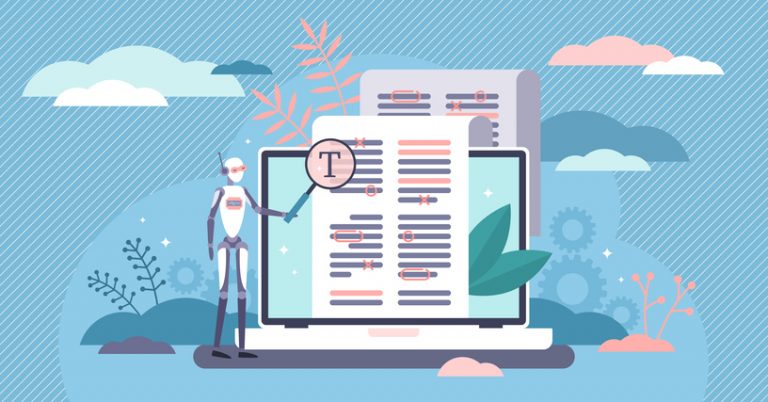
Scholarly Paraphrasing Tool and Essay Rewriter for Rewording Academic Papers
In the blog, we focus on academic and scientific paraphrasing software tools that help students to rewrite their essay into an academically acceptable format.
Very nice, very comprehensive
- Pingback: Algunos recursos para el inicio de curso I | Ferran Escrivà Llorca
Highly educative, and informative beside I appreciate your blogs post.
YOUR ARTICLE IS HIGHLY HELPFUL AND VERY INFORMATIVE
NICE BLOG THANKS FOR HELPING
There is also Refereed.com. It has either reference management or collaborative writing in real-time. And It is free.
Good blog, thanks for to compile my intention of materials.
- Pingback: Research Paper Structure – Main Sections and Parts of a Research Paper
Really informative blog
Leave a Reply Cancel reply
Your email address will not be published. Required fields are marked *
Save my name, email, and website in this browser for the next time I comment.
- 12 Share Facebook
- 4 Share Twitter
- 8 Share LinkedIn
- 10 Share Email
Your personal research assistant
Zotero is a free, easy-to-use tool to help you collect, organize, annotate, cite, and share research.
Available for Mac, Windows, Linux, and iOS
Just need to create a quick bibliography? Try ZoteroBib .
Meet Zotero.
Collect with a click..
Zotero automatically senses research as you browse the web. Need an article from JSTOR or a preprint from arXiv.org? A news story from the New York Times or a book from a library? Zotero has you covered, everywhere.
Organize your way.
Zotero helps you organize your research any way you want. You can sort items into collections and tag them with keywords. Or create saved searches that automatically fill with relevant materials as you work.
Cite in style.
Zotero instantly creates references and bibliographies for any text editor, and directly inside Word, LibreOffice, and Google Docs. With support for over 10,000 citation styles, you can format your work to match any style guide or publication.
Stay in sync.
Zotero can optionally synchronize your data across devices, keeping your files, notes, and bibliographic records seamlessly up to date. If you decide to sync, you can also always access your research from any web browser.
Collaborate freely.
Zotero lets you co-write a paper with a colleague, distribute course materials to students, or build a collaborative bibliography. You can share a Zotero library with as many people you like, at no cost.
Zotero is open source and developed by an independent, nonprofit organization that has no financial interest in your private information. With Zotero, you always stay in control of your own data.
Still not sure which program to use for your research? See why we think you should choose Zotero .
Ready to try Zotero?

The best AI tools for research papers and academic research (Literature review, grants, PDFs and more)
As our collective understanding and application of artificial intelligence (AI) continues to evolve, so too does the realm of academic research. Some people are scared by it while others are openly embracing the change.
Make no mistake, AI is here to stay!
Instead of tirelessly scrolling through hundreds of PDFs, a powerful AI tool comes to your rescue, summarizing key information in your research papers. Instead of manually combing through citations and conducting literature reviews, an AI research assistant proficiently handles these tasks.
These aren’t futuristic dreams, but today’s reality. Welcome to the transformative world of AI-powered research tools!
This blog post will dive deeper into these tools, providing a detailed review of how AI is revolutionizing academic research. We’ll look at the tools that can make your literature review process less tedious, your search for relevant papers more precise, and your overall research process more efficient and fruitful.
I know that I wish these were around during my time in academia. It can be quite confronting when trying to work out what ones you should and shouldn’t use. A new one seems to be coming out every day!
Here is everything you need to know about AI for academic research and the ones I have personally trialed on my YouTube channel.
My Top AI Tools for Researchers and Academics – Tested and Reviewed!
There are many different tools now available on the market but there are only a handful that are specifically designed with researchers and academics as their primary user.
These are my recommendations that’ll cover almost everything that you’ll want to do:
| Find literature using semantic search. I use this almost every day to answer a question that pops into my head. | |
| An increasingly powerful and useful application, especially effective for conducting literature reviews through its advanced semantic search capabilities. | |
| An AI-powered search engine specifically designed for academic research, providing a range of innovative features that make it extremely valuable for academia, PhD candidates, and anyone interested in in-depth research on various topics. | |
| A tool designed to streamline the process of academic writing and journal submission, offering features that integrate directly with Microsoft Word as well as an online web document option. | |
| A tools that allow users to easily understand complex language in peer reviewed papers. The free tier is enough for nearly everyone. | |
| A versatile and powerful tool that acts like a personal data scientist, ideal for any research field. It simplifies data analysis and visualization, making complex tasks approachable and quick through its user-friendly interface. |
Want to find out all of the tools that you could use?
Here they are, below:
AI literature search and mapping – best AI tools for a literature review – elicit and more
Harnessing AI tools for literature reviews and mapping brings a new level of efficiency and precision to academic research. No longer do you have to spend hours looking in obscure research databases to find what you need!
AI-powered tools like Semantic Scholar and elicit.org use sophisticated search engines to quickly identify relevant papers.
They can mine key information from countless PDFs, drastically reducing research time. You can even search with semantic questions, rather than having to deal with key words etc.
With AI as your research assistant, you can navigate the vast sea of scientific research with ease, uncovering citations and focusing on academic writing. It’s a revolutionary way to take on literature reviews.
- Elicit – https://elicit.org
- Litmaps – https://www.litmaps.com
- Research rabbit – https://www.researchrabbit.ai/
- Connected Papers – https://www.connectedpapers.com/
- Supersymmetry.ai: https://www.supersymmetry.ai
- Semantic Scholar: https://www.semanticscholar.org
- Laser AI – https://laser.ai/
- Inciteful – https://inciteful.xyz/
- Scite – https://scite.ai/
- System – https://www.system.com
If you like AI tools you may want to check out this article:
- How to get ChatGPT to write an essay [The prompts you need]
AI-powered research tools and AI for academic research
AI research tools, like Concensus, offer immense benefits in scientific research. Here are the general AI-powered tools for academic research.
These AI-powered tools can efficiently summarize PDFs, extract key information, and perform AI-powered searches, and much more. Some are even working towards adding your own data base of files to ask questions from.
Tools like scite even analyze citations in depth, while AI models like ChatGPT elicit new perspectives.
The result? The research process, previously a grueling endeavor, becomes significantly streamlined, offering you time for deeper exploration and understanding. Say goodbye to traditional struggles, and hello to your new AI research assistant!
- Consensus – https://consensus.app/
- Iris AI – https://iris.ai/
- Research Buddy – https://researchbuddy.app/
- Mirror Think – https://mirrorthink.ai
AI for reading peer-reviewed papers easily
Using AI tools like Explain paper and Humata can significantly enhance your engagement with peer-reviewed papers. I always used to skip over the details of the papers because I had reached saturation point with the information coming in.
These AI-powered research tools provide succinct summaries, saving you from sifting through extensive PDFs – no more boring nights trying to figure out which papers are the most important ones for you to read!
They not only facilitate efficient literature reviews by presenting key information, but also find overlooked insights.
With AI, deciphering complex citations and accelerating research has never been easier.
- Aetherbrain – https://aetherbrain.ai
- Explain Paper – https://www.explainpaper.com
- Chat PDF – https://www.chatpdf.com
- Humata – https://www.humata.ai/
- Lateral AI – https://www.lateral.io/
- Paper Brain – https://www.paperbrain.study/
- Scholarcy – https://www.scholarcy.com/
- SciSpace Copilot – https://typeset.io/
- Unriddle – https://www.unriddle.ai/
- Sharly.ai – https://www.sharly.ai/
- Open Read – https://www.openread.academy
AI for scientific writing and research papers
In the ever-evolving realm of academic research, AI tools are increasingly taking center stage.
Enter Paper Wizard, Jenny.AI, and Wisio – these groundbreaking platforms are set to revolutionize the way we approach scientific writing.
Together, these AI tools are pioneering a new era of efficient, streamlined scientific writing.
- Jenny.AI – https://jenni.ai/ (20% off with code ANDY20)
- Yomu – https://www.yomu.ai
- Wisio – https://www.wisio.app
AI academic editing tools
In the realm of scientific writing and editing, artificial intelligence (AI) tools are making a world of difference, offering precision and efficiency like never before. Consider tools such as Paper Pal, Writefull, and Trinka.
Together, these tools usher in a new era of scientific writing, where AI is your dedicated partner in the quest for impeccable composition.
- PaperPal – https://paperpal.com/
- Writefull – https://www.writefull.com/
- Trinka – https://www.trinka.ai/
AI tools for grant writing
In the challenging realm of science grant writing, two innovative AI tools are making waves: Granted AI and Grantable.
These platforms are game-changers, leveraging the power of artificial intelligence to streamline and enhance the grant application process.
Granted AI, an intelligent tool, uses AI algorithms to simplify the process of finding, applying, and managing grants. Meanwhile, Grantable offers a platform that automates and organizes grant application processes, making it easier than ever to secure funding.
Together, these tools are transforming the way we approach grant writing, using the power of AI to turn a complex, often arduous task into a more manageable, efficient, and successful endeavor.
- Granted AI – https://grantedai.com/
- Grantable – https://grantable.co/
Best free AI research tools
There are many different tools online that are emerging for researchers to be able to streamline their research processes. There’s no need for convience to come at a massive cost and break the bank.
The best free ones at time of writing are:
- Elicit – https://elicit.org
- Connected Papers – https://www.connectedpapers.com/
- Litmaps – https://www.litmaps.com ( 10% off Pro subscription using the code “STAPLETON” )
- Consensus – https://consensus.app/
Wrapping up
The integration of artificial intelligence in the world of academic research is nothing short of revolutionary.
With the array of AI tools we’ve explored today – from research and mapping, literature review, peer-reviewed papers reading, scientific writing, to academic editing and grant writing – the landscape of research is significantly transformed.
The advantages that AI-powered research tools bring to the table – efficiency, precision, time saving, and a more streamlined process – cannot be overstated.
These AI research tools aren’t just about convenience; they are transforming the way we conduct and comprehend research.
They liberate researchers from the clutches of tedium and overwhelm, allowing for more space for deep exploration, innovative thinking, and in-depth comprehension.
Whether you’re an experienced academic researcher or a student just starting out, these tools provide indispensable aid in your research journey.
And with a suite of free AI tools also available, there is no reason to not explore and embrace this AI revolution in academic research.
We are on the precipice of a new era of academic research, one where AI and human ingenuity work in tandem for richer, more profound scientific exploration. The future of research is here, and it is smart, efficient, and AI-powered.
Before we get too excited however, let us remember that AI tools are meant to be our assistants, not our masters. As we engage with these advanced technologies, let’s not lose sight of the human intellect, intuition, and imagination that form the heart of all meaningful research. Happy researching!
Thank you to Ivan Aguilar – Ph.D. Student at SFU (Simon Fraser University), for starting this list for me!

Dr Andrew Stapleton has a Masters and PhD in Chemistry from the UK and Australia. He has many years of research experience and has worked as a Postdoctoral Fellow and Associate at a number of Universities. Although having secured funding for his own research, he left academia to help others with his YouTube channel all about the inner workings of academia and how to make it work for you.
Thank you for visiting Academia Insider.
We are here to help you navigate Academia as painlessly as possible. We are supported by our readers and by visiting you are helping us earn a small amount through ads and affiliate revenue - Thank you!

2024 © Academia Insider

- Skip to main content
- Skip to primary sidebar
- Skip to footer
- QuestionPro

- Solutions Industries Gaming Automotive Sports and events Education Government Travel & Hospitality Financial Services Healthcare Cannabis Technology Use Case NPS+ Communities Audience Contactless surveys Mobile LivePolls Member Experience GDPR Positive People Science 360 Feedback Surveys
- Resources Blog eBooks Survey Templates Case Studies Training Help center
Home Surveys Academic Research
Academic Research Tools: What they are + Top 5 Best
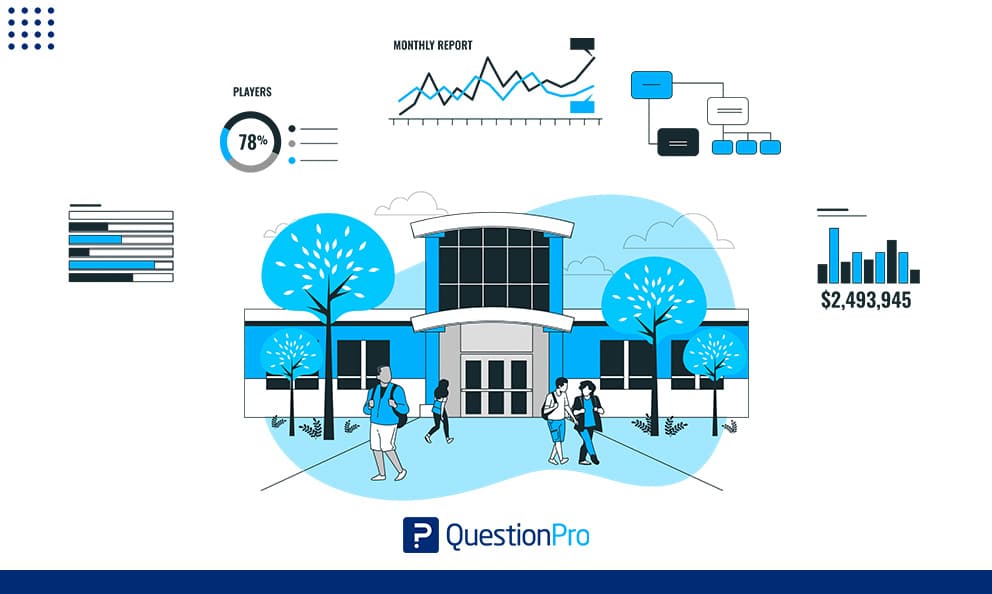
Academic research is a rigorous activity that requires a lot of dedication and diligence to provide great-quality results. Technology has improved how we access information by making access to information faster and more effective, so we carry out research more efficiently.
When conducting research, you must have the best methods and tools to facilitate the process. Every researcher needs a typing assistant to review spelling, grammar, and punctuation mistakes. If your research involves data analysis, you need a statistical research tool. You’ll probably need a virtual library for consulting if it involves psychology or sociology.
What are academic research tools?
An academic research tool is a software or platform that helps researchers organize, analyze, and manage the various components of their research projects. Some examples of academic research tools include reference management software, data visualization software, and survey design tools. These tools are designed to support the various stages of the research process, from literature review and data collection to data analysis and publication.
Reference management software, such as Mendeley or Endnote, allows researchers to organize and manage their bibliographic references and citations. This can be particularly helpful for large literature reviews, as it allows researchers to easily search and access their reference library and format citations and bibliographies in various styles. Additionally, many reference management tools offer features like annotation and collaboration, so researchers can share their reference libraries with colleagues and work on them together.
Data visualization software, like Tableau or R, can help researchers to explore and understand their data. These tools allow researchers to create interactive visualizations from their data, such as charts, graphs, and maps. This can be very useful for identifying patterns and trends that might not be immediately apparent from looking at raw data. These tools also provide a way to communicate the findings from their research clearly and effectively, as visualizations can be more easily understood than raw data.
Data collection software is another important tool that can support the research process. This software can be used to design and administer surveys, collect and store data, and manage participant information. Top data collection software such as QuestionPro offers a variety of question types, such as multiple choice, rating scales, and open-ended questions. They can be used to conduct surveys online or in person. This software also provides features like skip logic, data validation, and data export, which can help to ensure data quality and facilitate analysis. Some data collection software also integrates with data visualization or statistical software, making it easy to analyze and visualize once data is collected.
Top 5 Academic Research Tools
There are endless tools for academic research that can help you in any stage of the research process, from educational search engine software and project management tools to grammar editors and reference managers. Adopting these technologies can improve the quality of academic research, regardless of the field or topic.
From the multiple options in the market, we made a list of the best five academic research tools you can use to level up your academic research:
EndNote gives you the tools you need for searching, organizing, and sharing your research. It allows you to easily create bibliographies while writing your following paper with features like Cite While You Write. Maximize your time with features like finding full text for your references and automatically updating records.
Whether you’re on your desktop, online, or iPad, EndNote’s syncing capabilities let you access all of your references, attachments, and groups from anywhere.
Bit AI is an excellent tool for collaborating on research with your team. It’s essentially like a Google Docs but specifically made for research. You can upload and share different file formats, including PDFs, videos, white papers, etc., and then edit them together with your team.
Typeset is a great tool when it comes to writing your own research papers. You can upload all your references for simple citations and check your work for spelling errors and plagiarism. Typeset also offers features to collaborate with your teammates and get the work done together.
2. Google Scholar
Google Scholar is a classic tool that only some people know about. It’s essentially a version of the traditional Google search but focused on scientific and academic papers, journals, books, and other publications. Instead of using Google, you can use Google Scholar to eliminate the risk of citing non-credible sources.
1. QuestionPro
Most academic research, regardless of field or topic, requires data analysis so the information can have a solid foundation. Online surveys are critical to examine population samples so hypotheses can be proved or disregarded. While methods and techniques may vary, QuestionPro survey software is an excellent academic research tool for conducting online surveys.
QuestionPro’s robust suite of research tools provides you with all you need to derive research results. If someone needs a simple survey tool or a collaborative research solution, this software offers solutions in an intuitive way. The platform is simple to use intuitively, but our certification process can assist you in creating powerful surveys that minimize the risks of information bias. If needed, in the platform, you can also perform Audience Surveys . Audience gives you access to millions of possible respondents so that your segmentation sample for academic research becomes 360°.
QuestionPro also provides easy-to-setup analytical research tools to build dashboards and visualizations for all your research results. Presenting the data collected comprehensively is a crucial factor in research, making it easier for anyone to consult and cite the information.
It’s crucial to decide on the tools for data collection because research is carried out in different ways and for various purposes. Data collection aims to capture quality evidence that allows analysis to formulate convincing and credible answers to the posed questions.
With QuestionPro Education Research Solutions, you gain access to the top survey software in the market. Conduct powerful surveys with a complete set of data analytics tools to gather valuable insights. Join our community of more than 5000+ universities and colleges across the globe that already use our platform to make research of impact.
MORE LIKE THIS

QuestionPro Thrive: A Space to Visualize & Share the Future of Technology
Jun 18, 2024

Relationship NPS Fails to Understand Customer Experiences — Tuesday CX
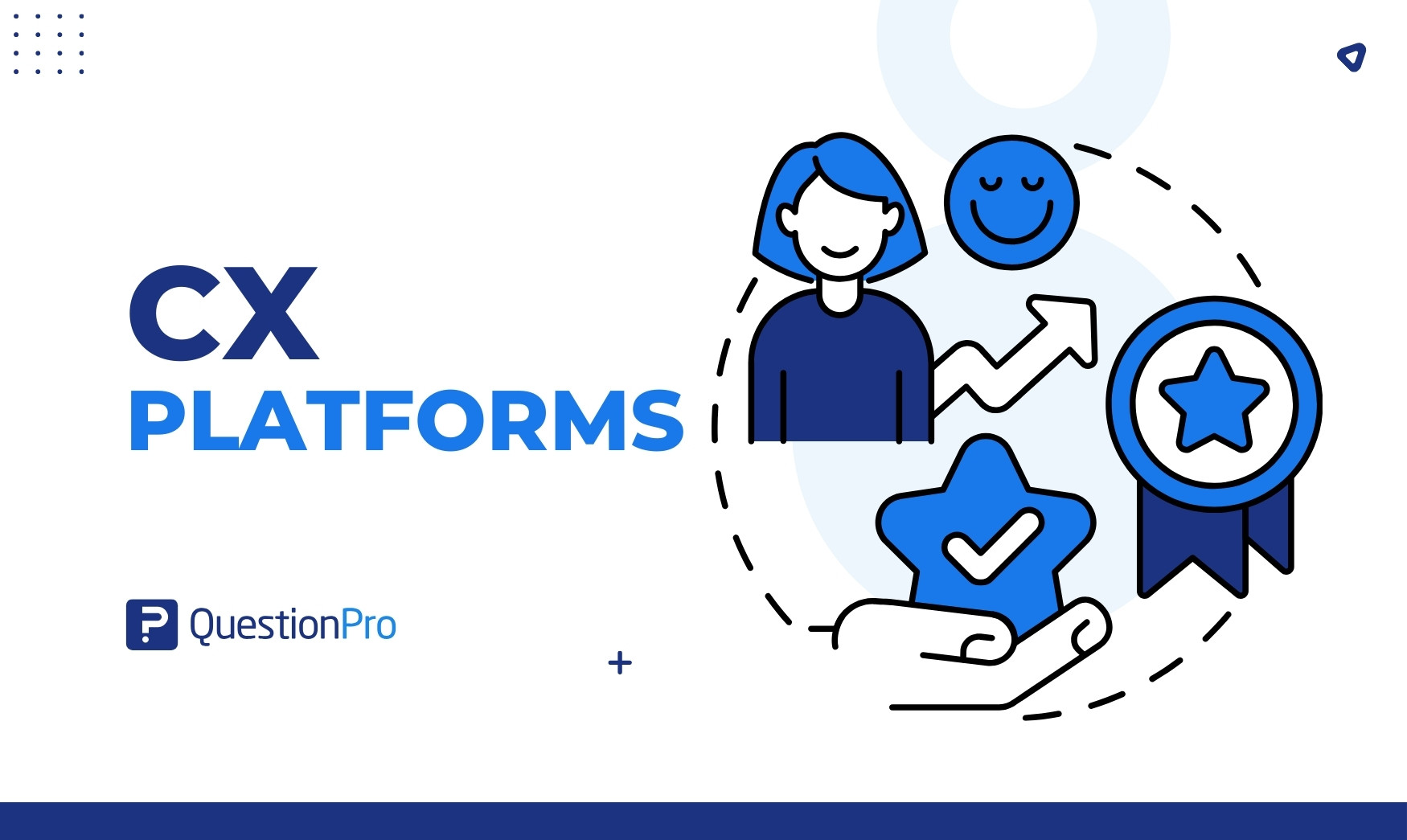
CX Platform: Top 13 CX Platforms to Drive Customer Success
Jun 17, 2024
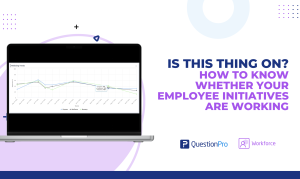
How to Know Whether Your Employee Initiatives are Working
Other categories.
- Academic Research
- Artificial Intelligence
- Assessments
- Brand Awareness
- Case Studies
- Communities
- Consumer Insights
- Customer effort score
- Customer Engagement
- Customer Experience
- Customer Loyalty
- Customer Research
- Customer Satisfaction
- Employee Benefits
- Employee Engagement
- Employee Retention
- Friday Five
- General Data Protection Regulation
- Insights Hub
- Life@QuestionPro
- Market Research
- Mobile diaries
- Mobile Surveys
- New Features
- Online Communities
- Question Types
- Questionnaire
- QuestionPro Products
- Release Notes
- Research Tools and Apps
- Revenue at Risk
- Survey Templates
- Training Tips
- Tuesday CX Thoughts (TCXT)
- Uncategorized
- Video Learning Series
- What’s Coming Up
- Workforce Intelligence
When you choose to publish with PLOS, your research makes an impact. Make your work accessible to all, without restrictions, and accelerate scientific discovery with options like preprints and published peer review that make your work more Open.
- PLOS Biology
- PLOS Climate
- PLOS Complex Systems
- PLOS Computational Biology
- PLOS Digital Health
- PLOS Genetics
- PLOS Global Public Health
- PLOS Medicine
- PLOS Mental Health
- PLOS Neglected Tropical Diseases
- PLOS Pathogens
- PLOS Sustainability and Transformation
- PLOS Collections
Welcome to the PLOS Writing Center
Your source for scientific writing & publishing essentials.
A collection of free, practical guides and hands-on resources for authors looking to improve their scientific publishing skillset.
ARTICLE-WRITING ESSENTIALS
Your title is the first thing anyone who reads your article is going to see, and for many it will be where they stop reading. Learn how to write a title that helps readers find your article, draws your audience in and sets the stage for your research!
The abstract is your chance to let your readers know what they can expect from your article. Learn how to write a clear, and concise abstract that will keep your audience reading.
A clear methods section impacts editorial evaluation and readers’ understanding, and is also the backbone of transparency and replicability. Learn what to include in your methods section, and how much detail is appropriate.
In many fields, a statistical analysis forms the heart of both the methods and results sections of a manuscript. Learn how to report statistical analyses, and what other context is important for publication success and future reproducibility.
The discussion section contains the results and outcomes of a study. An effective discussion informs readers what can be learned from your experiment and provides context for the results.
Ensuring your manuscript is well-written makes it easier for editors, reviewers and readers to understand your work. Avoiding language errors can help accelerate review and minimize delays in the publication of your research.
The PLOS Writing Toolbox
Delivered to your inbox every two weeks, the Writing Toolbox features practical advice and tools you can use to prepare a research manuscript for submission success and build your scientific writing skillset.
Discover how to navigate the peer review and publishing process, beyond writing your article.
The path to publication can be unsettling when you’re unsure what’s happening with your paper. Learn about staple journal workflows to see the detailed steps required for ensuring a rigorous and ethical publication.
Reputable journals screen for ethics at submission—and inability to pass ethics checks is one of the most common reasons for rejection. Unfortunately, once a study has begun, it’s often too late to secure the requisite ethical reviews and clearances. Learn how to prepare for publication success by ensuring your study meets all ethical requirements before work begins.
From preregistration, to preprints, to publication—learn how and when to share your study.
How you store your data matters. Even after you publish your article, your data needs to be accessible and useable for the long term so that other researchers can continue building on your work. Good data management practices make your data discoverable and easy to use, promote a strong foundation for reproducibility and increase your likelihood of citations.
You’ve just spent months completing your study, writing up the results and submitting to your top-choice journal. Now the feedback is in and it’s time to revise. Set out a clear plan for your response to keep yourself on-track and ensure edits don’t fall through the cracks.
There’s a lot to consider when deciding where to submit your work. Learn how to choose a journal that will help your study reach its audience, while reflecting your values as a researcher.
Are you actively preparing a submission for a PLOS journal? Select the relevant journal below for more detailed guidelines.
How to Write an Article
Share the lessons of the Writing Center in a live, interactive training.
Access tried-and-tested training modules, complete with slides and talking points, workshop activities, and more.
Your Writing Assistant for Research
Unlock Your Research Potential with Jenni AI
Are you an academic researcher seeking assistance in your quest to create remarkable research and scientific papers? Jenni AI is here to empower you, not by doing the work for you, but by enhancing your research process and efficiency. Explore how Jenni AI can elevate your academic writing experience and accelerate your journey toward academic excellence.

Loved by over 1 million academics

Academia's Trusted Companion
Join our academic community and elevate your research journey alongside fellow scholars with Jenni AI.

Effortlessly Ignite Your Research Ideas
Unlock your potential with these standout features
Boost Productivity
Save time and effort with AI assistance, allowing you to focus on critical aspects of your research. Craft well-structured, scholarly papers with ease, backed by AI-driven recommendations and real-time feedback.
Get started

Overcome Writer's Block
Get inspiration and generate ideas to break through the barriers of writer's block. Jenni AI generates research prompts tailored to your subject, sparking your creativity and guiding your research.
Unlock Your Full Writing Potential
Jenni AI is designed to boost your academic writing capabilities, not as a shortcut, but as a tool to help you overcome writer's block and enhance your research papers' quality.

Ensure Accuracy
Properly format citations and references, ensuring your work meets academic standards. Jenni AI offers accurate and hassle-free citation assistance, including APA, MLA, and Chicago styles.
Our Commitment: Academic Honesty
Jenni AI is committed to upholding academic integrity. Our tool is designed to assist, not replace, your effort in research and writing. We strongly discourage any unethical use. We're dedicated to helping you excel in a responsible and ethical manner.
How it Works
Sign up for free.
To get started, sign up for a free account on Jenni AI's platform.
Prompt Generation
Input your research topic, and Jenni AI generates comprehensive prompts to kickstart your paper.
Research Assistance
Find credible sources, articles, and relevant data with ease through our powerful AI-driven research assistant.
Writing Support
Draft and refine your paper with real-time suggestions for structure, content, and clarity.
Citation & References
Let Jenni AI handle your citations and references in multiple styles, saving you valuable time.
What Our Users Say
Discover how Jenni AI has made a difference in the lives of academics just like you

· Aug 26
I thought AI writing was useless. Then I found Jenni AI, the AI-powered assistant for academic writing. It turned out to be much more advanced than I ever could have imagined. Jenni AI = ChatGPT x 10.

Charlie Cuddy
@sonofgorkhali
· 23 Aug
Love this use of AI to assist with, not replace, writing! Keep crushing it @Davidjpark96 💪

Waqar Younas, PhD
@waqaryofficial
· 6 Apr
4/9 Jenni AI's Outline Builder is a game-changer for organizing your thoughts and structuring your content. Create detailed outlines effortlessly, ensuring your writing is clear and coherent. #OutlineBuilder #WritingTools #JenniAI

I started with Jenni-who & Jenni-what. But now I can't write without Jenni. I love Jenni AI and am amazed to see how far Jenni has come. Kudos to http://Jenni.AI team.

· 28 Jul
Jenni is perfect for writing research docs, SOPs, study projects presentations 👌🏽

Stéphane Prud'homme
http://jenni.ai is awesome and super useful! thanks to @Davidjpark96 and @whoisjenniai fyi @Phd_jeu @DoctoralStories @WriteThatPhD
Frequently asked questions
How much does jenni ai cost, how can jenni ai assist me in writing complex academic papers, can jenni ai handle different types of academic papers, such as essays, research papers, and dissertationss jenni ai maintain the originality of my work, how does artificial intelligence enhance my academic writing with jenni ai.
Can Jenni AI help me structure and write a comprehensive literature review?
Will using Jenni AI improve my overall writing skills?
Can Jenni AI assist with crafting a thesis statement?
What sets Jenni AI apart as an AI-powered writing tool?
Can I trust Jenni AI to help me maintain academic integrity in my work?
Choosing the Right Academic Writing Companion
Get ready to make an informed decision and uncover the key reasons why Jenni AI is your ultimate tool for academic excellence.
Feature Featire
COMPETITORS
Enhanced Writing Style
Jenni AI excels in refining your writing style and enhancing sentence structure to meet academic standards with precision.
Competitors may offer basic grammar checking but often fall short in fine-tuning the nuances of writing style.
Academic Writing Process
Jenni AI streamlines the academic writing process, offering real-time assistance in content generation and thorough proofreading.
Competitors may not provide the same level of support, leaving users to navigate the intricacies of academic writing on their own.
Scientific Writing
Jenni AI is tailored for scientific writing, ensuring the clarity and precision needed in research articles and reports.
Competitors may offer generic writing tools that lack the specialized features required for scientific writing.
Original Content and Academic Integrity
Jenni AI's AI algorithms focus on producing original content while preventing plagiarism, ensuring academic integrity.
Competitors may not provide robust plagiarism checks, potentially compromising academic integrity.
Valuable Tool for Technical Writing
Jenni AI extends its versatility to technical writing, aiding in the creation of clear and concise technical documents.
Some competitors may not be as well-suited for technical writing projects.
User-Friendly Interface
Jenni AI offers an intuitive and user-friendly interface, making it easy for both novice and experienced writers to utilize its features effectively.
Some competitors may have steeper learning curves or complex interfaces, which can be time-consuming and frustrating for users.
Seamless Citation Management
Jenni AI simplifies the citation management process, offering suggestions and templates for various citation styles.
Competitors may not provide the same level of support for correct and consistent citations.
Ready to Revolutionize Your Research Writing?
Sign up for a free Jenni AI account today. Unlock your research potential and experience the difference for yourself. Your journey to academic excellence starts here.

Top 13 Tools for Researchers in 2024!
Gone are the days of going to the library, studying numerous books, taking notes on paper, and doing research. Thanks to technology, we no longer have to do this tedious routine to do research. However, research is still a meticulous, painstaking process.
This is why we decided to uncover some of the best software tools for researchers that are going to help you conduct and maintain your research with ease. Read on…
List of Top 13 Best Tools for Researchers for better results:
Research today is dynamic. We often use the internet to browse websites, watch videos, study analytics, and conduct our research by exploring different types of digital content, making technology a major stakeholder in making our research success .
While the internet has made it easy for us to access worldly information with the click of a button (or mouse!), it has created a whole new set of problems.
Sorting through a seemingly infinite number of websites, verifying content, and curating only the best stuff can take a lot of time and effort. This is why we have brought you 13 essential research tools every researcher should use while working on the internet.
1. Bit.ai

Online research means going through numerous websites, articles, blogs, images, videos, infographics, and more to find what you are looking for.
For our dynamic, interactive, and media-rich research, we need a tool that incorporates all facets of modern-day research under one roof. Simple text editors of the past just won’t cut it anymore! This is where Bit comes in.
Bit allows researchers and teams to collaborate, share, track, and manage all knowledge and research in one place.
It’s the perfect research tool to share multi-dimensional research with your peers and not just plain, boring text and slides.
Add articles, PDFs, videos, white papers, ebooks, audio samples- basically anything you can think of – and share it with your peers easily!
Other notable features of Bit include:
- An easy-to-use, minimal editor that supports Markdown.
- Collaborative, real-time editing, and communication with peers.
- Add any type of digital content (images, videos, etc) to your Bit document.
- A content library to save all your media files for quick access.
- Smart search, allows anyone to search and find any files, images, documents, links, etc quickly.
All-in-all, Bit is a must-have writing tool for researchers and authors!

Key Features of Bit:
- Workspaces to store different research content easily
- Content library to store media assets
- Real-time collaboration with fellow researchers
- Free with limited functionality
- Paid plans start from Pro ($8/month), Business ($15/month), Enterprise (contact sales)
Read more: How Bit.ai Can Help You Manage Your Academic Research?
2. elink.io
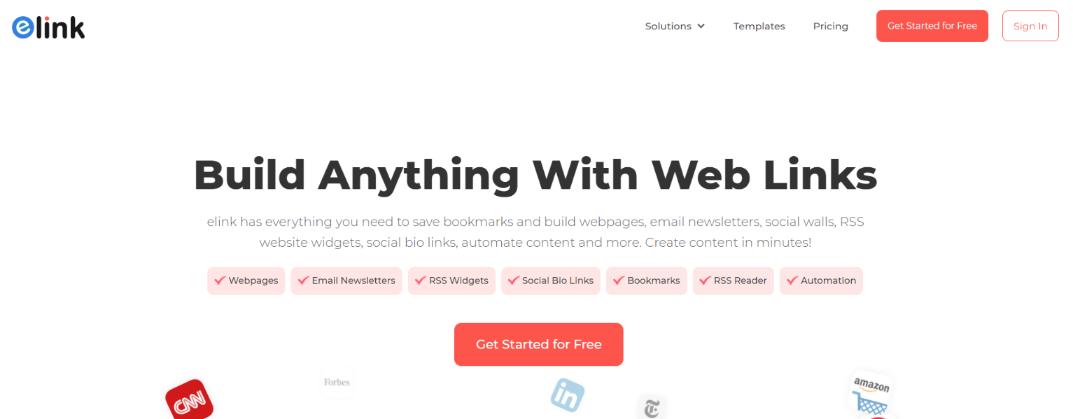
Research often involves going through hundreds of links and articles and compiling them in one safe space for future reference or publishing them for your audience.
This is why many researchers use bookmarking and curation tools like elink to quickly save their links under one roof and share them with their peers.
elink makes it easy for researchers to save content from around the web. They can save article links, videos, cloud files, social media posts, and much more!
Researchers have the option of saving content to their link library or adding them directly to content collections and sharing their research with their peers . To make the bookmarking process a breeze, elink also has a chrome extension .
Simply click on the extension or right-click on any webpage to save the content directly to your elink dashboard.
Researchers can edit the title and description to add their own voices or notes. They can even bundle links together and share their link collection with others as a newsletter or embed the collection on your blog/website!
Key Features of elink:
- Save links quickly using the chrome extension
- Create and share research links as a newsletter or embed it on your website
- Easy user-interface
- Paid plans start at Pro Monthly ($15/month), Pro 1 Year ($12/month), and Pro 2 years ($10/month).
3. GanttPRO

No matter what kind of research you do, you need to organize, plan, and stay focused on all of your activities.
Without a robust planning tool, researchers may fall behind the schedule and lose their progress.
GanttPRO project and task management tool makes it easy for single researchers and groups of any size to plan their tasks on a visually appealing Gantt chart timeline, follow their progress, and all the deadlines.
GanttPRO allows researchers to create a limitless number of tasks, groups of tasks, and subtasks on one timeline.
Besides, it’s a perfect planning tool for assigning tasks to your fellow researchers or creating virtual resources, whoever or whatever they may be. The software is a good choice for collaboration, time tracking, as well as sharing and exporting your schedules.
Key Features of GanttPRO:
- Dozens of ready-made templates.
- Real-time collaboration with fellow researchers.
- Elegant user interface with a short learning curve.
- Free 14-day trial with all features available.
- Paid plans start from Team ($4.5/user/month), Individual ($15/month), Enterprise (contact sales).
4. Grammarly
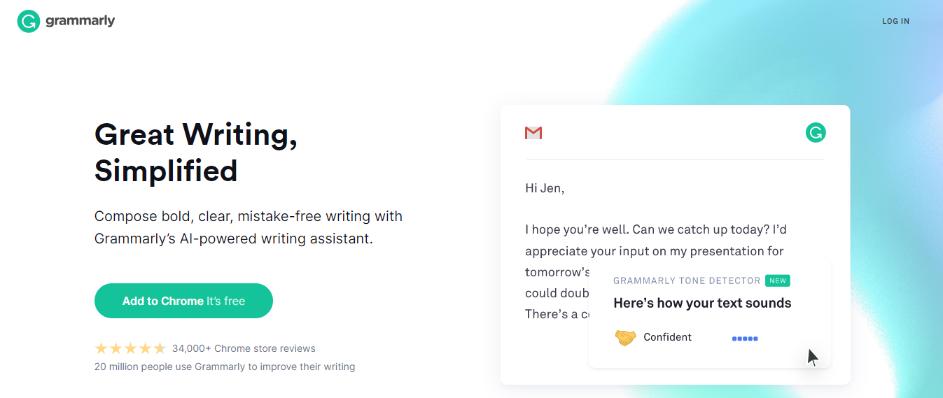
Research work often involves hours of proofreading and spellchecking to make your research professional .
Grammarly, a writing enhancement tool will save you a ton of time and effort doing this dreaded task! Apart from basic spellchecking and corrections, Grammarly includes a grammar checker, a punctuation checker, a vocabulary enhancer, and even a plagiarism checker tool!
This awesome tool scans your research for more than 250 types of grammar mistakes in six distinct writing genres and leaves you with error-free writing. With thorough explanations for all your errors and weekly progress reports .
Grammarly is a must-have tool for researchers. It’s available as a browser extension, a desktop app, a web-based app, and a Microsoft add-in. Many of the Grammarly alternatives are also available in the market that is equally good.
Key Features of Grammarly:
- Works with the majority of online tools like Word, Slack, etc.
- Plagiarism checker tool
- Tone detector
- Paid plans start from: Premium ($11.66/month), Business ($12.50/month)
Read more: 10 Best Writing Apps To Make You A Better Writer!
5. Typeset.io

With over 100,000+ verified journal formats to choose from, Typeform makes the process of research a bit too easy! Quickly copy-paste or upload your paper on Typeset and follow any citation style you need.
Typeset also has a plagiarism and grammar checker built in to ensure your writing is error-free. Once done uploading and citing, click on autoformat to generate your report in seconds.
You can also download your research in PDF , Docx, LaTeX file, or even as a Zip file. With collaboration features built-in, you can invite your fellow researchers to the platform and work together.
Key Features of Typeset:
- Over 100,000+ journal formats to choose from
- Plagiarism and grammar checker tool
- Editing services to improve your publication chances
- Paid plans start from: Researcher ($8/month), Team($6/month), Journals / Publishers (contact sales)
6. Scrivener

Scrivener is another great tool for research writing and keeping your notes organized.
Used by researchers, screenwriters, novelists, non-fiction writers, students, journalists, academics, lawyers, translators, and more, Scrivener is a tool made for long writing projects.
On signing up, you are quickly presented with its editor, with a sidebar to keep everything in place. You can also break your content into manageable sections of any size and leave Scrivener to join them together.
For novelists and storytellers, there’s also a corkboard to visualize your storyline and move cards around as you like.
The outliner keeps a synopsis of what you have already written, along with word count data and metadata. Users can arrange their research articles and other files in folders and subfolders.
Key Features of Scrivener:
- Desktop and mobile apps
- Outline creator
- Easy organization
- Paid plans start from $40.84/one-time fee
7. ProofHub

You must organize, prepare, and stay focused on all of your efforts, regardless of the type of research you conduct.
Researchers may go behind schedule and lose progress if they don’t have a good task management tool. ProofHub is an all-in-one project and team management application that allows research teams and organizations of any size to efficiently plan their research projects in one spot.
ProofHub allows you to create, assign and track tasks using effective task management features like Kanban boards and table view. Researchers can also get a visual idea of how their project is progressing using robust Gantt charts.
ProofHub also allows you to store and jot down all the data or information collected through your research in Notes. You can even create different notebooks and store your information according to the topic. Not just that, you can even share your research work with your team members.
Teams can also share and store files, documents, and images in ProofHub’s files section. Managers can track their team’s time spent on a specific research task using automatic and manual timers.
Team members can also brainstorm ideas or have real-time discussions in ProofHub’s discussions section and make way for better research work.
Key features of ProofHub:
- Ready to use project templates
- Task management
- Time tracking and project reporting
- Team collaboration (chat, notes, and discussions)
- File management
- Online proofing
- 14-day free trial with all the features.
8. Google Scholar

Next up is an amazing research tool by Google called Google Scholar. Google Scholar provides a quick way to broadly search for scholarly literature from one location.
Look for articles, theses, books, abstracts, and court opinions, from professional societies, online repositories, universities, academic publishers, and other websites.
Researchers can also explore related works, citations, authors, and publications easily. Create a public author profile and see who’s citing your recent publication. Google Scholar also allows its users to keep up with recent developments in any area of research.
Key Features of Google Scholar:
- Create a public author page
- Look for information across Google’s database
- Easy to use
- Free to use
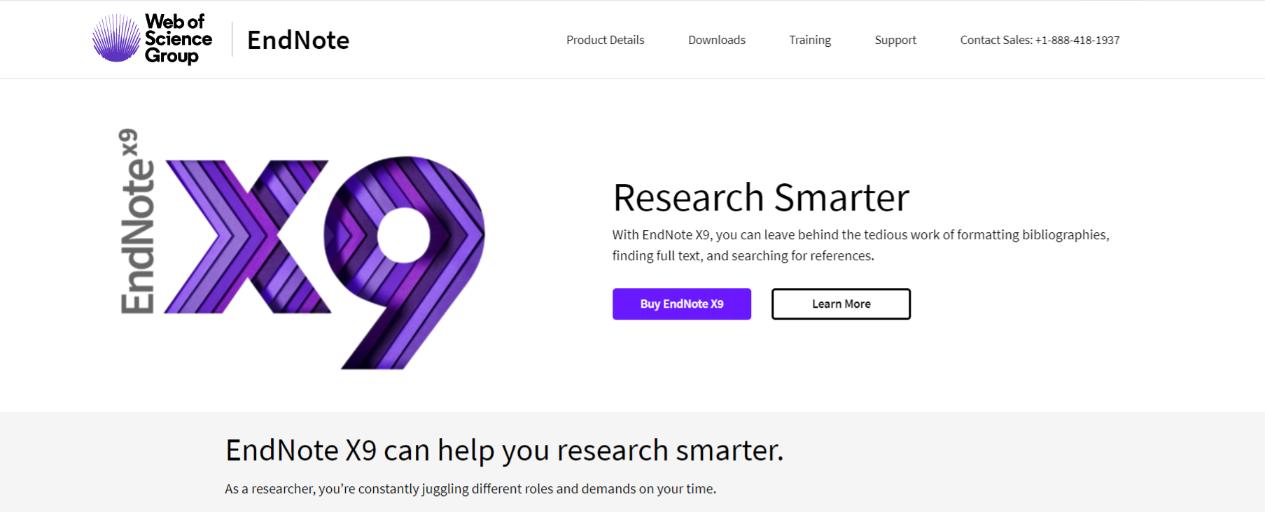
Endnote wants you to research smarter by simplifying the tiresome work of formatting bibliographies, finding full text, and searching for references.
Endnote is collaborative in nature as it allows you to share selected groups of references, manage team access, and track activity and changes from one single dashboard.
With smarter insights, Endnote automatically finds the impact of your references and finds the best-fit journal for your papers.
The platform also enables users to automatically create, format, and update bibliographies. Quickly export your references and full-text PDFs into EndNote and start working instantly.
With a bunch of EndNote templates and plug-ins, researchers can enhance their Endnote experience and get the most out of the platform.
Key Features of Endnote:
- Import filters for prior research
- Track your teammates’ activity on your shared library
- Automatic reference and link updating
- Paid plans start from $249
10. Evernote

Evernote is a note-taking app that can be very useful while conducting research . The app helps you store all your personal ideas, to-do listsm4, notes, and research links in one place.
Create separate tags and folders for the different types of information you are saving and keep it all organized.
Evernote auto-syncs across all your devices, including desktop, smartphone, and tablet, so you can switch between devices without losing your data.
Its Chrome browser extension called the Evernote web clipper is a great add-on for saving articles or other content on the internet while doing your research.
Just click the browser extension to save the entire page or highlights to your Evernote notebook along with any notes you have about that page.
Key Features of Evernote:
- Keep notes, articles, and other content in one place
- Chrome extension for clipping content
- Set reminders
- Paid plans start from Plus ($34.99 per year or $3.99 per month), Premium ($69.99 per year or $7.99 per month), and Evernote Business (contact sales)
11. Mendeley

Mendeley is a reference management software that allows researchers to create references, citations, and bibliographies in multiple journal styles with just a few clicks.
Quickly access your library from anywhere – from anywhere. Windows, Mac, Linux, etc and add papers directly from your browser with a few clicks or import any documents from your desktop to your library.
With its research network, researchers connect and network with over 6 million users. Users can create groups to carry out discussions, discover research, and follow curated bibliographies.
There are also over 250,000 + science, technology, and health jobs to advance your career and grant info from over 5000 organizations to fund your next research !
Key Features of Mendeley:
- Annotate and organize documents
- Find and create groups with fellow researchers
- Grant information from over 5000 organizations
- Paid plans start from $55/year for 5 GB to $165/year to unlimited storage
12. ContentMine

ContentMine offers a variety of text mining services to help researchers find, download, analyze, and extract knowledge from academic papers.
ContentMine builds its own open-source code to help out researchers find papers and not waste time on the internet doing so. They can also convert academic papers , PDFs to HTML, or to almost any format.
ContentMine can also extract data from tables and graphs, reducing the time taken to conduct a meta-analysis. The platform also offers consultancy as well as training workshops to educate people on the work they do and how.
Key Features of ContentMine:
- Extract data from tables and graphs
- Quickly mine text from hundreds of papers
- Workshops and training
- Contact sales
13. ResearchGate

The last tool on our list of awesome tools for researchers is a platform called ResearchGate. ResearchGate gives you access to over 135 million publication pages, allowing you to stay up to date with what’s happening in your field.
With a built-in community, researchers can share their research, collaborate with peers, and discover new papers and bibliographies.
ResearchGate also provides deep analytics on who’s been reading your work and keeps track of your citations. With over 17 million users, ResearchGate is a research community to join!
Key Features of ResearchGate:
- Share and find researchers
- Analytics to see who’s reading your work
- Citation tracking
Before you go!
Our team at bit.ai has created a few awesome templates to make your research process more efficient. Make sure to check them out before you go, y our team might need them!
- Case Study Template
- Research Paper Template
- Competitor Research Template
- Brainstorming Template
- SWOT Analysis Template
- White Paper Template
Final Words
There you have it folks, our list of amazing websites, apps, and software to use while conducting your research. Research is hard work- from finding and managing content to organizing and publishing- research takes a lot of time and effort.
However, with our awesome list of tools, researchers are surely going to get out the most of their time and effort and get work done more efficiently. Did we miss any awesome tool for researchers out there? Let us know by tweeting us at @bit_docs.

Further reads:
- Top 11 Code Editors for Software Developers
- Collaborative Research: Definition, Benefits & Tips!
- Best Resource Management Tools and Software
- How to Write a Research Proposal?

11 Best Link in Bio Tools in 2024!
Writing Vision Statement: Definition, Examples and Best Practices!
Related posts
Best free project management software: complete list with features, mob programming: importance, best practices, & ways to use it, 17 marketing terms you must be aware of, program manager vs. project manager : the key differences explained, workflow automation & everything you need to know, diverse workforce: bringing different perspectives together.

About Bit.ai
Bit.ai is the essential next-gen workplace and document collaboration platform. that helps teams share knowledge by connecting any type of digital content. With this intuitive, cloud-based solution, anyone can work visually and collaborate in real-time while creating internal notes, team projects, knowledge bases, client-facing content, and more.
The smartest online Google Docs and Word alternative, Bit.ai is used in over 100 countries by professionals everywhere, from IT teams creating internal documentation and knowledge bases, to sales and marketing teams sharing client materials and client portals.
👉👉Click Here to Check out Bit.ai.
Recent Posts
How to build an effective knowledge base for technical support, 9 knowledge base mistakes: what you need to know to avoid them, personal user manual: enhance professional profile & team productivity, 9 document management trends every business should know, ai for social media marketing: tools & tactics to boost engagement, a guide to building a client portal for your online course.
Educational resources and simple solutions for your research journey

Top 16 Digital Tools That Every Researcher Should Know About
Using digital tools for researchers effectively can be the difference between an average and an excellent piece of research. But today, with the long list of research tools available online, it is only natural for busy researchers to be baffled when it comes to making the right choice for specific needs. With considerations of time, cost, effectiveness and quality, there is a lot to check before you make the choice. We don’t want you to spend hours just looking for the best tools for researchers, so we’ve rounded up some of the most effective digital tools for researchers to make your life simpler.
In this comprehensive article, we have compiled a list of 16 useful online tools for researchers at various stages of the research journey. These tools will streamline your research process, help you stay organized, and provide you with easy access to the information you need. From reference management software to digital libraries, these cutting-edge tools cater to the needs of both experienced and novice researchers alike. Whether you’re working on a major research project or just starting out, this blog will help you get ahead of the curve and make your research journey a tad (we aren’t making big promises) bit easier.
Table of Contents
Why are digital tools for researchers important
Before any digital tools for researchers were introduced, academics had to rely on old-school manual methods that were typically time-consuming, labor-intensive, and also limited in scope. For instance, you had to subscribe to journals or physically visit libraries and spend hours searching and sifting through tomes before finding the most relevant information. And once that was done, the process of organizing, storing, and referencing data was another challenge you had to overcome.
In contrast, online tools for researchers offer a wealth of information and resources at your fingertips today. With the option to search and access vast amounts of knowledge with a few clicks, researchers are able to boost their efficiency and effectiveness at work.
And it’s not just limited to online tools for researchers that allow you to easily store, organize, and manage information, there are a number of tools that can help you hone your writing, check for plagiarism, find the right journal, collaborate with other researchers, and share your knowledge, ideas, and resources. The rapid development of digital tools for researchers have revolutionized the way researchers work, making way for faster innovation and more groundbreaking research.

Types of tools for researchers
There are various types of online tools for researchers to choose from. These tools can be classified into various categories such as planning and management of research projects, literature search, data collection and analysis, reference management, editing and paraphrasing, and collaboration and communication. These digital tools for researchers have revolutionized the way academics work, adding to their time, productivity and effectiveness; this in turn makes research more accessible, efficient, and collaborative. Let’s take a look at some top tools for researchers across these key stages in the researcher journey.
Reference Management Tools
Reference management tools are great time saving tools for researchers. Not only do they allow you to create a library of relevant articles, they help you format your references, detect duplicate entries and replace incomplete references, and even share articles with other researchers. Furthermore, they are also extremely useful tools for researchers when it comes to correctly linking sources and citing referenced articles.
Among the top reference management tools for researchers, Zotero, Mendeley, and EndNote are the most widely used.
Zotero has quickly become one of the must-have tools for researchers to capture and preserve high-quality publication data from various sources, including journal articles, websites, newspapers, and PDFs. Its integration with popular Word processors such as Microsoft Word, LibreOffice, and Google Docs allows you to efficiently manage citations and bibliographies as you write. The software’s built-in PDF reader enables you to identify and extract cited quotations and comments, which can be directly saved as notes. What sets Zotero apart is its advanced search feature, which enables users to perform complex searches, such as locating articles added in the last month by mentioning a specific keyword and creating auto-updating collections. Zotero can also identify retracted papers and sends out an alert when you attempt to cite a retracted paper.
Zotero follows the freemium model, where one can get 300 MB in the free version with additional storage available for a fee starting at $20/year .
An offering by Elsevier, Mendeley is among the best reference management tools for researchers that combines an intuitive, user-friendly interface with powerful organizational features. With Mendeley, you can store and manage sources, take notes, collaborate with others, and discover new research in your field. Mendeley’s PDF viewer has an excellent, easy-to-use, built-in capability with the option of editing a document simultaneously with other Mendeley users. ‘Mendeley Notebook’, a feature of Mendeley, helps you collate all your highlights and notes from multiple PDFs. ‘Mendeley Cite’, another of its features, is a citation plugin for Microsoft Word that lets you insert references and bibliographies into your document.
Mendeley is a free citation and paper management tool with up to 2 GB of cloud storage. It has a desktop application, mobile app, and Chrome browser extension, making it a top choice among tools for researchers.
Mendeley offers both a free and a premium version, where users get 2 GB in the free version and additional storage space with pricing starting at $55/year .
Endnote is one of the paid reference management tools for researchers. It allows researchers to insert citations into the text, and simultaneously creates a bibliography with its “Cite While You Write” feature in Microsoft Word. Additionally, one can align and format the article as per the target journal requirements using its “Manuscript Matcher” feature. You can also conduct large-scale literature reviews with Endnote’s powerful analysis tools. Endnote is available in the cloud and accessible anywhere, providing researchers with the flexibility to work from any location.
Endnote offers a range of pricing options, starting at $124.95/year . It is one of the must-have tools for researchers keen on saving time and energy!

Academic Writing Tools
If you are not taking advantage of academic writing tools for researchers, well, you’re missing out on a lot. The range of things academic writing tools can do for you is astonishing – language editing, abstract writing, plagiarism checking and so much more! While there are a number of online tools for reseachers that can help improve your academic writing, here are our top choices in this category that you should know about.
iThenticate
iThenticate by Turnitin is an online plagiarism checker designed specifically for researchers and academics to review their manuscripts prior to journal submission and publication. iThenticate is one of the most popular tools for researchers looking to check their writing for originality and ensure they have cited all sources appropriately.
With its advanced plagiarism detection technology, iThenticate compares a submission to an extensive database of web pages and scholarly content before producing a similarity score and report. Researchers can use this report to eliminate any inadvertent instances of plagiarism and other blunders in their research papers.
The price for an iThenticate license starts at $100 for a manuscript and is valid for multiple plagiarism checks for this single document over a year. If you need to check more than one manuscript, you can opt for an annual license at a higher price.
One of the well-known tools for researchers, Scholarcy is an innovative AI engine that helps you analyze different sections of an article, filter out the noise, and deliver a precise structured summary of the research. Scholarcy doesn’t just condense papers into referenced lay summaries, it highlights key claims and statistics mentioned in the research paper that are most useful to your work.
It also extracts all the tables and figures and links to their cited location in the text, saving researchers hours of time searching for the most relevant papers. The smart AI engine is also a great tool for researchers looking to generate lay summaries that can help promote their research to a broader audience
You can use the free Scholarcy browser extension on Chrome or Edge to create summary flashcards online or build your own personal interactive library with a subscription of $7.99 per month.
Scrivener is among the underrated tools for researchers that can help make researchers’ lives simpler if used effectively. It has a user-friendly interface that allows researchers to easily organize their research notes, documents, and outlines. Scrivener gives you three ways to organize your projects: the Binder – which lets you manage folders and text, the Outliner – which helps you outline your research before you write it, and the Corkboard – to help you plan and organize your ongoing tasks.
Scrivener also has a mobile app that syncs with your devices ensuring everything is in one place. This makes it a great option for those who want to walk around and research ideas or take notes on your phone.
Scrivener offers a free trial period, with lifetime licenses available from $63.56 for MacOS and Windows.
Paperpal is as multifaceted as a Swiss Knife and stands tall among online academic writing tools for researchers. With in-depth language and grammar checks, instant and precise academic translations, relevant subject-specific writing recommendations, and critical technical checks, its suite of tools has you covered from the first draft itself. Use the Paperpal for Word plug-in and improve your language as you write in Microsoft Word, including real-time suggestions on vocabulary and phrasing.
Turn to Paperpal for Web to enhance your content with instant checks to ensure error-free language and grammar, clarity, and readability. Choose Paperpal for Manuscript if you have a manuscript ready for submission; its comprehensive language and technical checks ensure your work meets journal guidelines by flagging problem areas that could lead to desk rejection.
The best part about Paperpal, also something that makes it different from other more generic grammar editing tools, is that it is tailored for researchers and academic writing. You can get up to 500 edits for free on Paperpal for Word and Web or enjoy unlimited support at just $99 per year. Paperpal for Manuscript gives you an edited version of your article with suggestions in track changes for just $29.

Project Management Tools
There are several online tools for researchers to manage and organize their work, including keeping track of task completion, setting deadlines, and just having everything in one place. Four tools for researchers that must be there in your productivity kit are Trello, GanttPRO, Evernote, and My Research Projects.
You can use Trello to visually organize your ideas on its boards with the help of interactive cards. These cards can be used in multiple ways – you can create lists, assign tasks, message and tag those you are collaborating with, link files, add due dates–all on the virtual “back” of the card. You can also drag cards between lists, copy cards that you use often (or rather, use the cards as templates), and send cards to other boards. Basically, you can see your entire research process on a single Trello board.
This is a useful tool for researchers involved in large collaborative projects that span the globe. Trello has a free version that offers limited features with pricing models starting at $5 a month.
GanttPRO is another tool for researchers that helps you organize your thoughts better. A Gantt chart timeline on GanttPRO is the best way to visualize tasks, know their start and end dates, and track your progress along the way. The vertical and horizontal axes in a Gantt Chart present a visual summary of how various aspects of your research project are progressing, which allows you to address specific tasks that need extra or immediate attention.
GanttPRO is hosted in the cloud, which makes is easily accessible. It offers users a free trial with the option to choose from plans starting at $7.99 per month.
A productive way to jot down notes and ideas and sort through your research materials, Evernote is one of the most popular online tools for researchers. With Evernote, you can organize your research by a simple notebook structure to keep similar notes together or creating tags and folders for specific purposes.
You can save webpages, articles, or screenshots to your Evernote notebook and use the handy multimedia feature to enhance these by adding new text, images, documents, and even audio messages captured with its inbuilt recorder. Evernote also helps you sync your notes across devices so you can manage your notes across multiple platforms.
The basic version of Evernote lets you create and save notes but has limitations on storage space. You can buy more storage by opting for a paid subscription plan, which is currently available from $5.83 a month at ongoing discounted prices.
My Research Projects
My Research Projects by Researcher.Life is designed for researchers and helps you plan, manage, and communicate your work effectively. It promises end-to-end support in transforming your research into a well-written manuscript with suggestions on suitable journals for your research and guidance on the most relevant literature to cite. You can use the comprehensive submission readiness check to ensure your manuscript meets journal guidelines, with checks for language quality, structural completeness, clarity and consistency, and mandatory declarations. You can also generate detailed article summaries to help you convey your research findings more effectively.
My Research Projects lets you check one manuscript and get a detailed report for free by subscribing to Researcher.Life. You can unlock premium checks for multiple manuscripts by upgrading to the Prime Pack for $99 a year.
Academic Search Engines
As researchers you are expected to keep up with the latest developments in your own and related research fields. Yet, with the exponential growth in research output, this is far from easy. This is what makes academic search engines invaluable to academics searching for relevant scientific information. They use keywords to help researchers find, access and read about the latest most relevant research, including peer-reviewed articles, genuine information, author home pages, and university websites.
Google Scholar, R Discovery, and Scopus are our top tools for researchers in this category.
R Discovery
R Discovery is a strong contender when it comes to the best literature search and reading tools for researchers. An AI-powered app for researchers, R Discovery boasts of an expanding library of research content that includes over 100 million research papers across 9.5 million topics and more than 32,000 journals worldwide. It uses your topics of interest to create a personalized reading feed, with suggestions on top reads, smart summaries, and other features to help you discover the right research in minutes.
This includes open access articles, preprints, and pay-walled content (accessible through institutional credentials) across all major subject areas, including biology, medicine, philosophy, political science, environmental science, social sciences, and psychology. The best part is that this app for researchers continually upgrades its features and eliminated predatory journals to ensure you have access to reliable research that works for you.
R Discovery is one of the many tools for researchers developed by Researcher.Life and is completely free to install and use. It is available on both mobile and web, allowing for streamlined reading on your preferred device.

Google Scholar
If you’re an academic, you probably have used Google Scholar sometime in your research journey. It is one of the most used tools for researchers and acts as an online search engine for academics looking for scholarly literature and relevant sources to cite. It is tailored for academics, which means you can use different keywords to look up various research articles, theses, books, and conference papers to support your research study.
Researchers can also search for authors, journals, and other titles and can even create an account to save their search results. The one drawback here though is that you will need to keep searching until you find related research, and even then you will still need to browse through these individually to find the most relevant content for your research topic.
Another popular academic search tool for researchers is Scopus, an offering by Elsevier that is very similar to Google Scholar and Microsoft Academic. The largest abstract and citation database of peer-reviewed research with over 1.7 billion cited references, Scopus houses content indexed from more than 25,000 active titles and 7,000 publishers, all carefully vetted and selected by an independent review board.
With Scopus, you can look for articles, journals, and any other sources that will help you write better research. You can also refine your literature search by filtering for author name or affiliation among others. Scopus also has analytical tools to help you visualize and compare research data – that is, you can view author, journal, and article impact metrics through the detailed research output and trends reports that Scopus provides.
Scopus works as an API that can be integrated into an institution’s repository or research information management systems. While it is free to use for non-subscribers, there is limited access to content with additional costs to access paywalled articles on this platform.

Journal Selection Tools
Given the enormous number of scholarly journals around and new ones coming up every year, it can be hard to select the best journal for your research paper. Despite its challenges, the process of finding the perfect journal, which is respected, relevant, and reliable, is one of the most critical tasks to get right for researchers. This is why good online journal finders are invaluable tools for researchers.
Elsevier’s Journal Finder tool and the Global Journal Database (GJD) are two pretty effective journal selection tools for researchers.
Journal Finder
The Journal Finder tool by Elsevier, one of the largest publishers of peer-reviewed journals across disciplines, is a great solution for authors looking to shortlist journals for their work. Just use relevant keywords, titles, or your research paper abstract to get a list of recommended Elsevier journals that publish research similar to yours.
Its intelligent machine learning algorithm uses terms specific to the corresponding research field to generate the best matches for your article. You can choose from the top of the list or sort this further using filters based on your preferences. The Journal Finder also lists journals with open-access publishing options and those that cover multidisciplinary research fields.
Elsevier can be used for free to search for journals related to your research.
Global Journal Database
The Global Journal Database, developed by Researcher.Life, comprises of more than 43,000 journals indexed in reputed public directories like Directory of Open Access Journals (DOAJ), Scopus, and Web of Science. Researchers can search for relevant journals using the title or ISSN, similar topics, research paper abstracts, and even manuscripts; the advanced AI engine will use this to generate the best journals for you.
Each journal recommendation comes with a detailed journal report that has key information about shortlisted journals, including publisher details, journal metrics, author instructions, the editorial review process, and even a list of the latest articles published. With the Global Journal Database, you can see where your preferred journal is indexed and browse its publishing history to better understand its scope. The broad journal coverage, multiple search modes, and detailed journal reports make this an exceptional tool for researchers, simplifying and speeding up the often-daunting journal selection process.
The Global Journal Database is available free with a Researcher.Life Essentials Pack subscription.

Wrapping Up
Researchers everywhere are on a quest to uncover new insights and come up with ground-breaking research. Choosing the right digital tools for researcher and using these effectively can make your journey from brainstorming to breakthroughs a smoother, easier, and faster one.

If you’re looking for a seamless transition between various tools, choose Researcher.Life, which brings together innovative solutions to accelerate and optimize each stage of your research journey. Turn to Paperpal the next time you’re perplexed by language nuances, swipe through R Discovery’s reading recommendations to keep up with the latest developments, manage your research effectively with My Research Projects, or find the right journal for your paper with the Global Journal Database. Experience Researcher.Life and its many bespoke tools for researchers.
Researcher.Life is a subscription-based platform that unifies the best AI tools and services designed to speed up, simplify, and streamline every step of a researcher’s journey. The Researcher.Life All Access Pack is a one-of-a-kind subscription that unlocks full access to an AI writing assistant, literature recommender, journal finder, scientific illustration tool, and exclusive discounts on professional publication services from Editage.
Based on 21+ years of experience in academia, Researcher.Life All Access empowers researchers to put their best research forward and move closer to success. Explore our top AI Tools pack, AI Tools + Publication Services pack, or Build Your Own Plan. Find everything a researcher needs to succeed, all in one place – Get All Access now starting at just $17 a month !
Related Posts

Thesis Defense: How to Ace this Crucial Step

What is Independent Publishing in Academia?
Bulk Content Generator
Brand Voice
AI Text Editor
Top AI Tools for Academic Research

Founder, Junia AI

Introduction
Academic research , once a tedious process involving hours spent in libraries and manual data collection, is now increasingly digitized. Technological advancements have made this critical aspect of knowledge generation more efficient and accessible.
One visionary who foresaw this transformation is Bill Gates . Known for his insightful predictions, Gates anticipated that AI-driven software would revolutionize education and academia within a span of 5-10 years. And true to his words, we are witnessing a surge in the use of AI writing tools for academic research.
These AI tools are not just augmenting traditional research methods but are reshaping them altogether. They offer a myriad of benefits like accelerating the pace of research, enhancing accuracy, and democratizing access to academic resources.
In this article, we have compiled a list of the top AI writing tools for academic research. These tools employ natural language processing algorithms to assist researchers in various aspects of the research process, including:
- Generating ideas and outlining papers
- Finding relevant sources
- Proofreading and editing
Best AI Tools For Research: Our Top Picks
| Ranking | Top AI Tool For Research | Highlight |
|---|---|---|
| 1 | Junia AI | Leading tool with citation generator feature, supports APA, MLA, Chicago styles. Enhances time efficiency, accuracy, ease of use, versatility in source formats. |
| 2 | ChatGPT | OpenAI language model for text generation tasks. Used at Stanford University for brainstorming ideas and structuring outlines. Versatile document handling (web browsing, PDFs). |
| 3 | Consensus | Specialized search engine for academics. Summarizes peer-reviewed articles into easy-to-understand summaries using AI algorithms. Efficient information retrieval during literature review stage. |
| 4 | Elicit.org | Comprehensive literature reviews and data extraction from various sources. Identifies main ideas without reading entire text and establishes relationships between concepts across documents. |
| 5 | Scite.ai | Analyzes citation patterns in scholarly articles to assess impact/credibility of papers. Categorizes citations as supporting/mentioning/disputing original paper's claims/findings. |
| 6 | Research Rabbit | Web app for scientific literature exploration/understanding. Creates organized collections of relevant papers using advanced algorithms analyzing content/metadata (keywords/abstracts/citation networks). |
| 7 | Google Scholar | Extensive online repository of scholarly literature across disciplines. Uses AI algorithms to rank documents by relevance and tracks citations to measure impact. |
| 8 | Trinka | Improves academic papers' quality by providing feedback on sentence structure, vocabulary usage, overall coherence. |
thout reading entire text and establishes relationships between concepts across documents. | | 5 | Scite.ai | Analyzes citation patterns in scholarly articles to assess impact/credibility of papers. Categorizes citations as supporting/mentioning/disputing original paper's claims/findings. | | 6 | Research Rabbit | Web app for scientific literature exploration/understanding. Creates organized collections of relevant papers using advanced algorithms analyzing content/metadata (keywords/abstracts/citation networks). | | 7 | Google Scholar | Extensive online repository of scholarly literature across disciplines. Uses AI algorithms to rank documents by relevance and tracks citations to measure impact. | | 8 | Trinka | Improves academic papers' quality by providing feedback on sentence structure, vocabulary usage, overall coherence. |
1. Junia AI
.png?token=eyJhbGciOiJIUzI1NiIsInR5cCI6IkpXVCJ9.eyJ1cmwiOiJ1c2VyLWdlbmVyYXRlZC1pbWFnZXMvZjJmOThkNWUtNjNjNC00MTJiLTkyY2QtZjgyNDI5NTE3YWRkL1NjcmVlbnNob3QgMjAyMy0xMi0xNiBhdCAyMi4yMi40MCAoMSkucG5nIiwiaWF0IjoxNzA5OTM1NzUyLCJleHAiOjIwMjUyOTU3NTJ9.mwSsgMw94c8_U1XaTjDalxtKua8hNbQscZGif0iyTAE)
Junia AI is a leading AI writing tool for academic research, and its citation generator feature is one of its standout offerings. With Junia AI, citing research sources becomes a breeze, saving you time and effort. Let's take a closer look at what makes Junia AI the go-to citation tool for researchers and academicians.
How Junia AI Works
Junia AI utilizes advanced algorithms to simplify the citation process. It has access to a vast database of sources, which allows it to generate accurate citations in various styles such as APA, MLA, and Chicago. Here's how it works:
- Input Source Details: You provide the necessary information about your source, such as author name, publication title, year of publication, etc.
- Select Citation Style: You choose the desired citation style from the available options.
- Generate Citations: Junia AI applies its algorithms to create citations based on the provided details and selected style.
Key Benefits of Using Junia AI
Using Junia AI for your citation needs offers several advantages that can enhance your research process:
1. Time Efficiency
Manually citing sources and formatting reference lists can be time-consuming, especially when dealing with multiple styles. With Junia AI, you can save valuable time by letting the tool handle these tasks for you.
2. Accuracy
Correctly citing your sources is crucial in academic writing as it adds credibility to your work and prevents plagiarism issues. Junia AI's advanced algorithms ensure that your citations are precise and consistent with the chosen style.
3. Ease of Use
Despite its sophisticated features, Junia AI remains user-friendly. Its intuitive interface makes it easy to enter source details, and its ability to generate citations instantly is a boon for researchers working under tight deadlines.
4. Versatility
Whether you're citing a book, a scholarly journal, a website, or any other type of source, Junia AI has got you covered. It supports a wide range of source formats, making it a versatile tool for all your citation requirements.
While Junia AI offers significant benefits for academic writing, it's worth noting that there are other AI-driven tools available to assist you throughout your research journey.
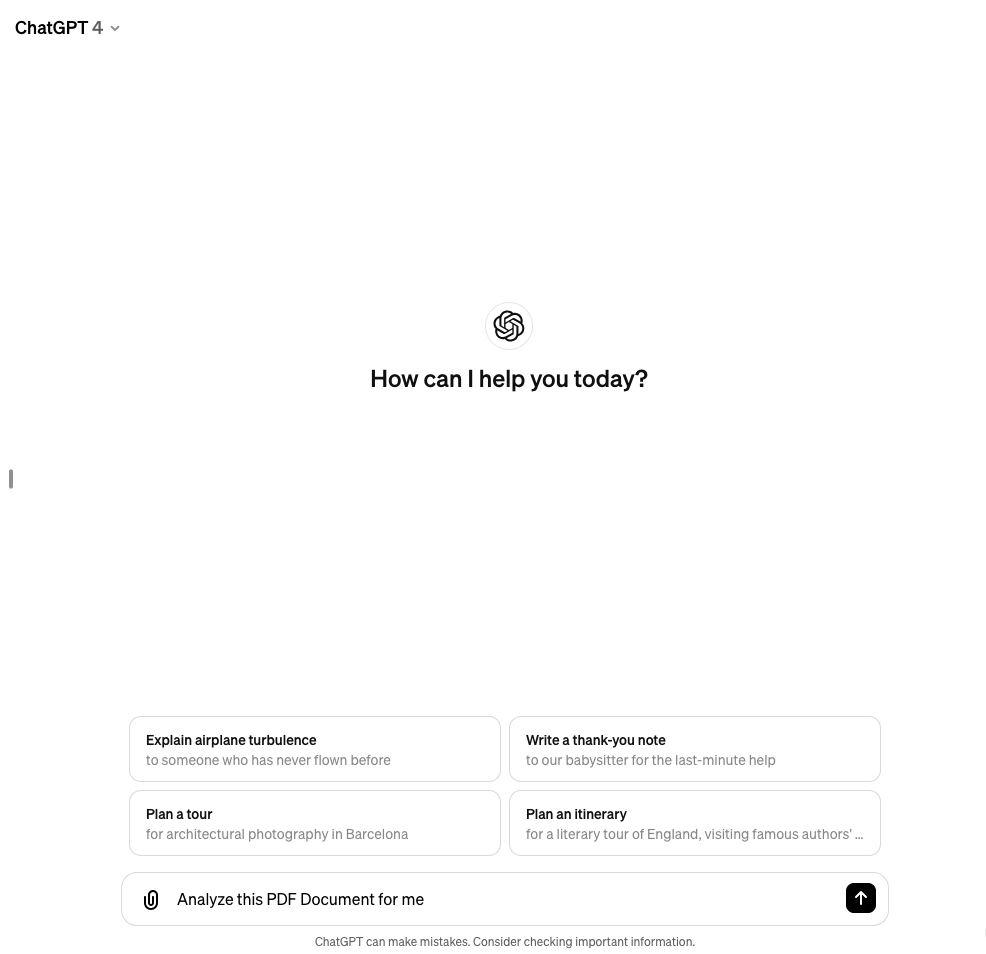
ChatGPT , developed by OpenAI , is an essential tool for academic research. This language model is specifically designed for generating text, making it a valuable assistant for scholars and researchers.
The Power of Incremental Prompting
The key feature of ChatGPT that resonates with academia is its incremental prompting feature. Incremental prompting allows researchers to create detailed outlines for their journal articles or research papers. With this feature, you can provide the model with a series of related prompts one by one, and it will respond accordingly. This step-by-step approach leads to more coherent and detailed responses.
This capability not only simplifies the writing process but also makes it more structured and organized. It's like having an intelligent assistant that helps you arrange your thoughts and ideas into well-defined sections or chapters of the research document.
Versatility in Document Handling
One of the strengths of ChatGPT lies in its ability to work with different types of documents. It can browse the web, interact with files (including PDFs and other formats), making it convenient for users to access various sources during their research work.
This ability is particularly useful when dealing with large PDF files or complex documents where finding relevant information can be challenging. With ChatGPT, you can simply upload your file, ask specific questions about its content, and get precise answers instead of having to read through the entire document.
Case Study: Stanford University
Let's look at an example from Stanford University where ChatGPT was tested by students and professors . They used this AI tool as part of their academic writing process - from generating ideas to creating outlines for journal articles.
- In one instance, a PhD student working on a paper about AI ethics used ChatGPT to generate an outline for his document. He started with a broad prompt on AI ethics which yielded a general response from the model. He then gradually added more specific prompts, leading the model to generate a detailed and organized outline of the paper.
- In another case, a professor at Stanford used ChatGPT for preparing his lectures. He would prompt the model with a topic he planned to teach and based on the generated responses, he would create an outline for his lecture.
These real-life examples demonstrate the effectiveness of ChatGPT in academic writing. It's not just about easing the writing process but also enhancing it by providing a new way to structure your thoughts, ideas, and findings. As Bill Gates predicted, AI-driven software like ChatGPT is indeed revolutionizing education and academia.
From these examples and many more, it is clear that using an AI tool like ChatGPT can significantly improve the academic writing process. By providing structure to your work, generating ideas, and making information retrieval easier, such tools are proving to be game-changers in academic research.
3. Consensus

Consensus is a specialized search engine designed for academics, leveraging advanced Artificial Intelligence to provide accurate and concise summaries of peer-reviewed articles.
How Consensus Works
The power of Consensus lies in its AI algorithms, which analyze the content of papers to extract key information. This makes it more than just a regular search engine - it's a tool that can distill complex academic papers into easy-to-understand summaries.
Why Choose Consensus?
When it comes to finding relevant sources for your research, Consensus offers several advantages over traditional search engines:
Features of Consensus
- Summarized Evidence : Consensus provides summarized evidence from peer-reviewed literature, allowing you to quickly grasp the main points of a paper without reading the entire document.
- AI-Powered Search Engine : Unlike keyword-based search engines, Consensus understands the context and relevance of your query, delivering more precise results.
- User-Friendly Interface : With its simple yet efficient interface, Consensus makes it easy for you to navigate the platform and find what you need.
Benefits of Using Consensus
Using Consensus during the literature review stage of your academic research projects can bring several benefits:
- Efficient Information Retrieval : By providing concise summaries of peer-reviewed articles, Consensus helps you save time during the literature review process.
- Access to Quality Sources : As Consensus focuses on peer-reviewed literature, using it ensures that you're accessing reliable and academically sound sources.
- Time-Saving : Thanks to its AI-powered search engine, Consensus delivers relevant results quickly, allowing you to work more efficiently.
- Improved Understanding : The summarized evidence provided by Consensus can enhance your understanding of the topic at hand, making your research more comprehensive.
- Ease of Use : With its user-friendly interface and straightforward functionality, Consensus is a tool that seamlessly integrates into your academic writing workflow.
Consensus serves as an example of how AI can transform the way academic research is conducted. As we embrace the digital age, tools like Consensus are becoming essential for researchers in various fields. By harnessing the power of AI, Consensus paves the way for more efficient and effective academic research, allowing you to focus on what truly matters - creating impactful knowledge.
4. Elicit.org
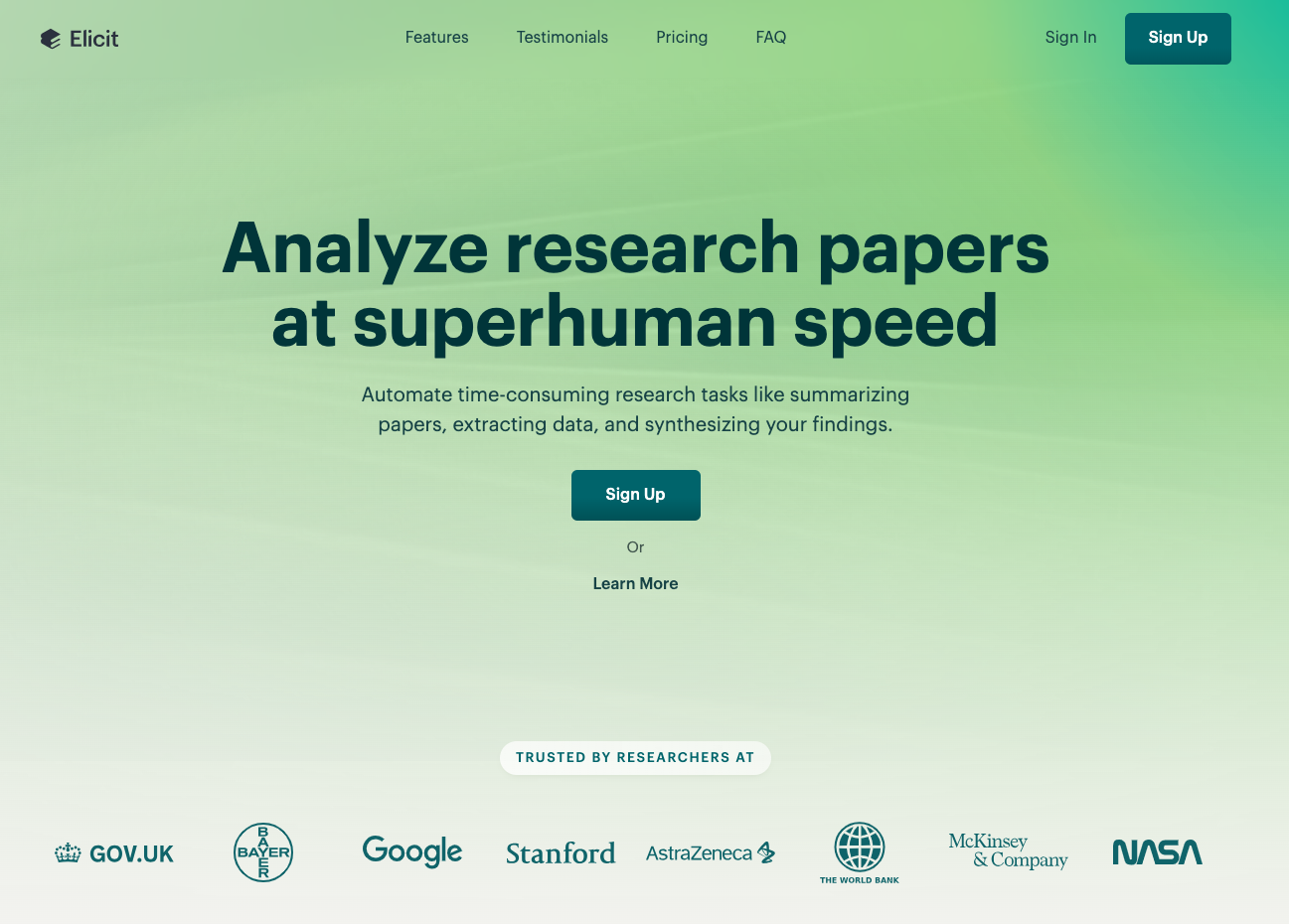
Elicit.org is an AI-powered tool designed to streamline the research process by assisting in conducting comprehensive literature reviews and extracting relevant data from various sources. It is one of the top AI writing tools for academic research that has been embraced by researchers worldwide.
How Elicit.org Works
The power of Elicit lies in its sophisticated algorithms that analyze the content of documents. These algorithms are capable of identifying key concepts, relationships, and findings within a sea of information. This feature allows users to gain valuable insights for their own research projects in a fraction of the time it would take manually.
Key Features of Elicit.org
Identifying key concepts.
Elicit's AI is programmed to identify and highlight key concepts within a text. This gives you an immediate grasp of the main ideas within a document without having to read it in its entirety.
Establishing Relationships
Another significant feature of Elicit.org is its ability to establish relationships between different documents or concepts. This helps to build a comprehensive understanding of the subject matter.
Extracting Findings
Finally, it can extract critical findings from research papers, providing you with specific data points that may be relevant to your research.
The practical applications of these features are numerous. For instance, if you were conducting a literature review on climate change, Elicit.org could:
- Analyze hundreds of papers
- Identify the key concepts such as 'global warming', 'carbon emissions', 'deforestation', etc.
- Establish relationships between these concepts across different papers
- Extract critical data points like specific carbon emission figures.
Try Elicit.org for Your Research
Elicit.org has truly revolutionized the way researchers approach literature review and data extraction, making it a crucial AI tool for academic research. By integrating Elicit.org into your research workflow, you can leverage its AI capabilities to make your research process more efficient and effective.
5. Scite.ai
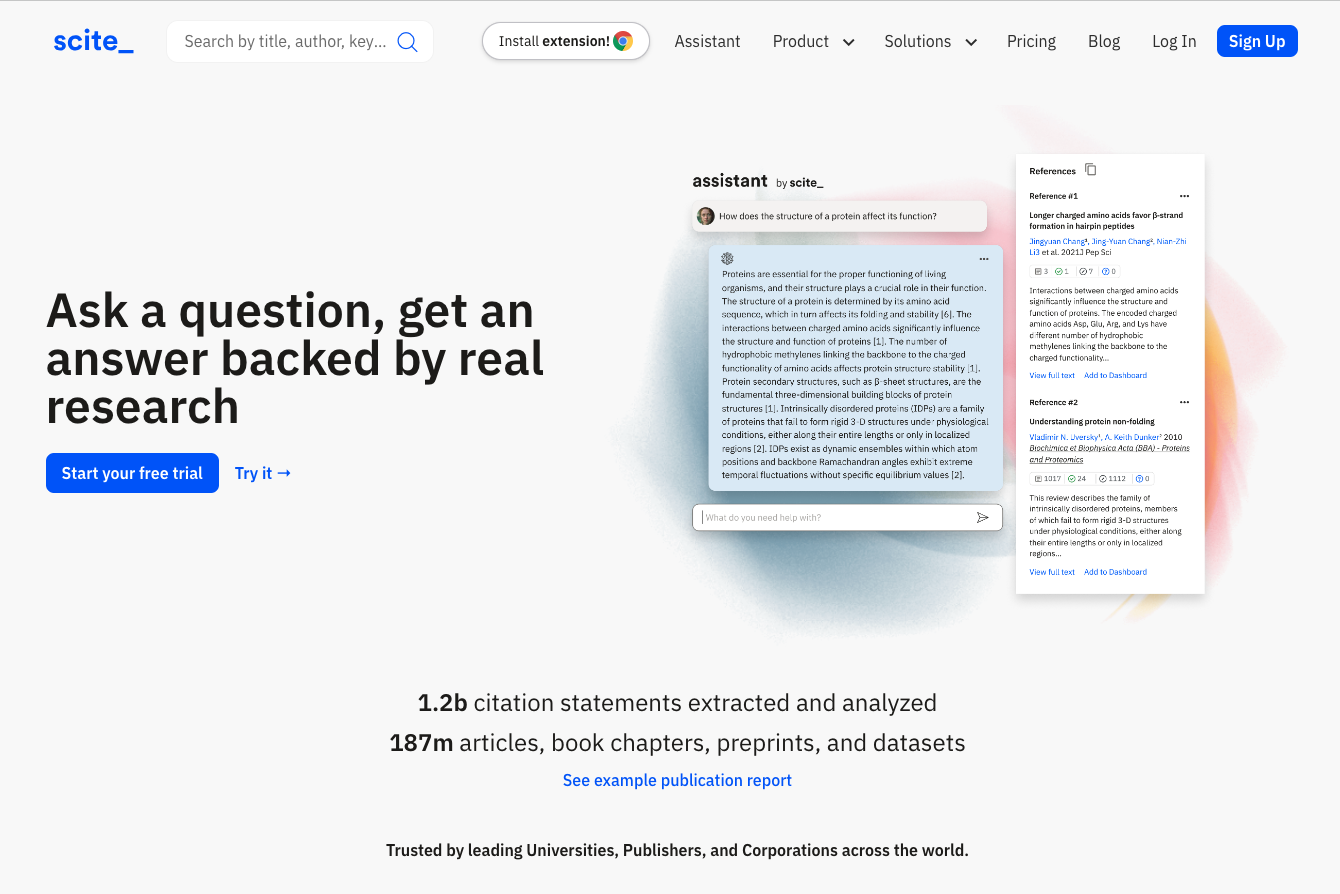
Scite.ai , a unique platform that stands out in its approach to enhancing the credibility of research.
Beyond Traditional Citation Tools
Scite.ai is not just a citation tool; it uses artificial intelligence to analyze citation patterns in scholarly articles meticulously. This insightful analysis offers users contextual information about how particular studies have been cited by other researchers. It's like having an intelligent assistant who can tell you not just who is citing your work, but also how and why they are citing it.
How Does Scite.ai Enhance Research Validation?
The primary focus of Scite.ai is on research validation. This is where the tool truly shines. In simple terms, Scite.ai helps scholars assess the impact and credibility of published papers more effectively. Its underlying AI technology sifts through the multitude of citations associated with any article, cutting through the noise to provide meaningful insights. It uses these insights to determine whether a paper has been positively or negatively received, based on the context within which it has been cited in subsequent works.
But how does this work?
Scite.ai takes each citation and breaks it down into three categories:
- Supporting : The citing work provides evidence in favor of the assertions made in the original paper.
- Mentioning : The citing work refers to the original paper but does not explicitly support or dispute its content.
- Disputing : The citing work challenges or contradicts the findings or claims made in the original paper.
This categorization gives a clear snapshot of how other researchers view your study, which can be invaluable when assessing its impact and validity.
Benefits of Using Scite.ai for Academic Writing
Incorporating Scite.ai into your academic writing process comes with several potential benefits:
- Strengthening Arguments : Knowing how others perceive your references can help you build stronger arguments by choosing sources that have been widely accepted and supported.
- Supporting Claims : Scite.ai gives you an edge by letting you back up your claims with references that have been positively cited in other works.
- Enhancing Credibility : A paper that includes well-regarded sources increases its credibility in the academic community, potentially leading to more citations and higher impact.
Understanding the Context of Citations
Scite.ai's approach to assessing the impact of papers does not stop at categorization. It also provides a 'citation statement', which is a brief excerpt from the citing text. This allows users to understand the context and rationale of the citation without having to read through the entire citing article.
For example, if a researcher is writing about climate change and selects a paper as a reference, Scite.ai not only shows how many times the paper has been cited but also provides an overview of whether these citations are supporting, mentioning or disputing it. This information paints a more in-depth and detailed picture of how the chosen paper has been received by the scientific community.

The Power of Scite.ai for Scholars
In essence, Scite.ai is a powerful ally for any scholar. It provides unique insights into citation patterns, enabling users to make informed decisions about which sources to use and how to present their arguments effectively. The ability to validate research, bolster arguments, and enhance credibility makes Scite.ai an indispensable tool in today's digital age where academic integrity is paramount.
6. Research Rabbit
Research Rabbit is an innovative AI tool designed to assist with exploring and understanding scientific literature. It's a web application that helps researchers navigate through scientific literature, enabling them to create organized collections of pertinent papers.
Utilizing advanced algorithms, Research Rabbit analyzes both content and metadata of articles. The analysis allows the application to suggest related works, providing researchers with new perspectives and connections they might have overlooked.
How Does Research Rabbit Work?
Research Rabbit employs AI algorithms to scrutinize the content and metadata of articles. This process includes evaluating keywords, abstracts, author affiliations, citation networks, and even figures and tables within the paper. This comprehensive approach provides a deeper understanding of the article's context and relevance.
The system then recommends other relevant articles based on its analysis. This feature aids researchers in uncovering new links between studies and gaining interdisciplinary insights.
Benefits of Using Research Rabbit
The use of Research Rabbit can bring multiple benefits to both novice and experienced researchers:
- Keeping Up With Latest Developments : The rapid pace at which new research papers are published makes it challenging for researchers to stay updated. Research Rabbit addresses this issue by providing recommendations based on recent publications related to their chosen topics.
- Identifying Research Gaps : By reviewing related papers suggested by Research Rabbit, researchers can identify gaps in current knowledge and thereby find opportunities for novel research.
- Improving Efficiency : Instead of manually searching for relevant studies, researchers can rely on Research Rabbit's AI-powered suggestions, saving valuable time.
- Enhancing Understanding : By presenting different perspectives on a topic through related works, Research Rabbit fosters a more comprehensive understanding of the subject matter.
To illustrate this process, consider a researcher studying climate change's impact on agriculture. After inputting their research papers into Research Rabbit, the application might suggest articles about innovative farming practices in response to climate change or economic studies on how climate change affects agricultural markets. These suggestions can lead the researcher to consider new angles for their work, promoting a more nuanced and complete analysis.
Research Rabbit represents a significant advancement in AI writing tools for academic research. Its ability to analyze literature and suggest related works enables researchers to delve deeper into their topics, discover new perspectives, and stay abreast of the latest developments in their field. By harnessing this technology, researchers can enhance the depth and breadth of their studies while improving their productivity.
7. Google Scholar
Google Scholar , a well-known platform for academic research, is an extensive online collection of scholarly literature across various fields. It has become an essential tool in the academic world because of its vast collection of research articles, conference papers, theses, books, and patents from professional societies, online repositories, universities, and other scholarly organizations.
Google Scholar uses advanced AI algorithms to rank documents based on their relevance, considering factors such as the full text of each document, where it was published, who authored it, and how frequently and recently it has been cited in other literature. As a result, researchers can access a wide range of scholarly content that might not be available through other search engines.
Finding Relevant Sources with Google Scholar
When doing academic research, the challenge often lies not in finding information but in finding relevant information. By using Google Scholar 's advanced search features effectively, you can overcome this challenge.
General Search
Simply enter your keywords into the search bar for a list of relevant resources.
Advanced Search
Click on the menu icon on the top left of the page and select "Advanced Search" for more specific queries. You can:
- Search for exact phrases
- Exclude certain words
- Search within specific publications or authors
Author Verification
If you're searching for articles from a particular author, make sure that they have verified their Google Scholar profile to avoid confusion with authors having similar names.
Tracking Citations: Measure Your Impact
One of the unique features of Google Scholar is its citation tracking capability. This feature allows researchers to measure the impact and influence of their work within the academic community.
This link under each result shows how many times an article has been cited by other papers indexed on Google Scholar . It's a helpful indicator of an article's influence or importance in a field.
Google Scholar Citations
This feature lets authors track citations to their articles. You can check who is citing your publications, graph citations over time, and compute several citation metrics.
Tips and Strategies: Maximizing Google Scholar's Effectiveness
The value derived from Google Scholar largely depends on how effectively you use its features. Here are some strategies to enhance your academic writing endeavors:
- Refine Your Search : Use boolean operators like AND, OR, NOT, "", and - to narrow or broaden your search.
- Personalized Updates : Set up alerts for new content that matches your specified criteria (such as author or keyword). This helps you stay updated with the latest research in your field of interest.
- Export Citations : Google Scholar allows you to export citations in various formats (like BibTeX, EndNote, RefMan, or RefWorks) which can be directly imported into your reference management software.
Google Scholar is considered one of the most powerful academic search engines available. Its comprehensive database coupled with advanced AI algorithms makes it an invaluable tool for academic research. By understanding its features and learning how to leverage them effectively, you can streamline your academic writing process and produce well-researched scholarly work.
Trinka is an advanced writing assistant powered by AI that aims to improve the quality of academic papers. It provides researchers with valuable feedback and suggestions to refine their writing style and eliminate grammatical errors.
How Does Trinka Help Improve Your Writing?
Trinka uses advanced algorithms to analyze your text thoroughly, focusing on three main areas:
1. Sentence Structure
Trinka examines each sentence in your paper for clarity, coherence, and conciseness. It suggests revisions to make your writing easier to understand.
2. Vocabulary Usage
The tool identifies complex or inappropriate words in your writing and suggests simpler alternatives.
3. Overall Coherence
Trinka evaluates the logical flow of ideas and arguments throughout your paper, highlighting areas that may need further explanation or reorganization.
By addressing these aspects, Trinka helps you create a well-written academic paper with a strong foundation.
"Trinka is more than just a grammar-checking tool. It is a smart companion that understands the nuances of academic writing and can assist you in producing high-quality papers.
The Power of AI Writing Tools for Academic Research
With the rapid advancements in technology, an important shift has taken place in the academic research arena. The emergence of AI writing tools for academic research has become a game-changer, improving both efficiency and quality in research efforts. These tools offer a wide range of capabilities that can help at every stage of the academic writing process.
Adapting to Technological Advancements
The world of academia is changing quickly. Researchers now need to keep up not only with developments in their own fields but also with broader technological trends that could affect their work. This includes embracing advancements like AI, which can greatly enhance research endeavors.
One example of this is Scite.ai . This platform uses AI to analyze citation patterns in scholarly articles, giving users contextual information about how a particular study has been cited by other researchers. This approach to research validation can help scholars better understand the impact and reliability of published papers. By using such tools, researchers can strengthen their arguments and support claims with trustworthy references, thereby improving the credibility of their work.
Experimenting with AI Tools
Innovation is key in academic research. That's why it's crucial for researchers to constantly explore and experiment with new methods and technologies that can enhance their work. This includes trying out various AI writing tools mentioned in this article.
For instance, you might want to consider using Research Rabbit for exploring scientific literature and creating organized collections of relevant papers. Its algorithms analyze the content and metadata of articles to suggest related works, enabling you to discover new connections and interdisciplinary perspectives. Such tools not only streamline your literature review process but also inspire new research directions.
The Future is Here
These AI writing tools are not just about keeping up with technological advancements; they are about embracing the future of academic research. As researchers, it's important for us to adapt and evolve alongside these changes, integrating technology into our workflows to improve efficiency and enhance the quality of our work.
View the latest institution tables
View the latest country/territory tables
AI writing tools promise faster manuscripts for researchers
Automation brings plagiarism risks, and software still needs human input for analysis and narrative.

Credit: gmast3r/Getty Images
17 August 2021

gmast3r/Getty Images
Writing tools powered by artificial intelligence (AI) have the potential to reduce manuscript preparation time to a few days, or hours. Deep-learning technologies that run chatbots, spellchecks and auto-generated tweets are being used in a growing number of products pitched at students and academics.
Grammarly, for example, claims to “inspect your writing carefully to improve clarity, word choice and more”, offering free and fee-based services.
But are these tools up to the task? In an experiment through education information site EduRef, a group of recent graduates, undergraduates and self-described undergraduate-level writers were given the same assignments as GPT-3, an AI language program developed by OpenAI, a research company co-founded by Elon Musk.
The assignments were evaluated by instructors who did not know who (or what) had written them. GPT-3 performed in line with the humans, according to EduRef, and received “more or less the same feedback”.
The program was praised for writing excellent openings and transitions, but was criticised for using vague, blunt and awkward language, and for failing to craft a strong narrative. It wrote shallow, less descriptive papers than the students, according to EduRef’s write-up on its website, but it took between three and 20 minutes to write a paper, compared to three days for the students.
Hilde van Zeeland is chief applied linguist at start-up company Writefull, which offers AI-based language editing, and is part of London-based Digital Science (see disclosure, below). She says AI tools are already powerful enough to improve a writer’s sentence flow and structure, and will continue to improve.
The company recently analysed more than 250,000 abstracts to identify the most commonly used phrases in each of four different parts of the abstract.
They found, for example, that the words ‘aim of this study’ occurred most frequently in part 1 of the abstract (where study aim and background are described) and the phrase ‘95% confidence interval’ occurred most often in part 4 (which deals with meaning of results, contribution, future research). Users can choose phrases and connecting sentences to use in their own papers.
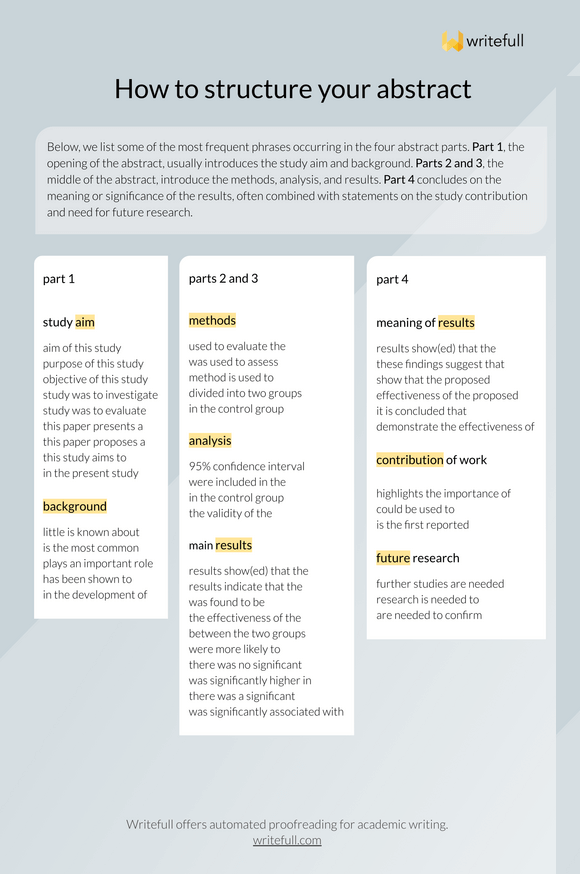
“With this database of phrases, when a user struggles with the right word to use for each section, our software will be able to provide good alternatives,” says van Zeeland.
The website tells users not to worry about plagiarism, reassuring them that certain phrases won’t be flagged by a plagiarism checker because they are short and commonly used.
Writefull is running a separate experiment that involves feeding an abstract into an AI tool, which generates a paper title based on the input. This function can enhance title readability, draw readership to the abstract and make the article more visible to search engines, according to van Zeeland.
AI tools can do more than check a writer’s grammar and spelling and suggest frequently used phrases, says computer scientist, Guillaume Cabanac, from the University of Toulouse in France.
An analysis of journal-published computer-science papers by Cabanac and his colleagues, posted as a preprint on arXiv in July and yet to be peer-reviewed, found swathes of articles containing tortured phrases and nonsensical text. For example, the phrase ‘colossal information’ was used instead of ‘big data’.
The authors suspect that these papers were the result of using automated translations or software that rewrites existing text to disguise plagiarism, according to a report in Nature .
Their study prompted warnings from research integrity experts that a new type of fabricated paper was entering the scientific literature, which will be hard to spot as AI tools learn to use more sophisticated language.
Considerations for using AI writing tools in academic work
Shu Chian Tay, a science communicator at the National University of Singapore , fears that AI writing tools could exacerbate inequality between labs with different access to resources or openness to trying new technologies.

Shu Chian Tay
“Consider a hypothetical situation where AI science-writing is possible and two labs have made the same research breakthrough at the same time,” says Tay.
“One lab stuck to human writing, which took weeks, while the other made use of AI writing tools. The latter, who is likely to publish earlier would get most, if not all, of the scientific recognition and lucrative intellectual property rights.”
Will AI replace human writing?
Tay notes that although AI writing tools are quite powerful, they have not yet reached a point where they can write a scientific manuscript from scratch. “We still need researchers to analyse data, present them as figures, and develop a coherent story before feeding all this information to the AI machine,” she says.
Ryan Morrison, professor of English as a second language at George Brown College in Toronto, Canada, says that although the adoption of AI in academic writing is inevitable, it is unlikely to replace human writing in the near future.

Ryan Morrison
“Just as super-computer calculators can process large sets of numbers fast, AI writing tools outperform humans in completing tasks like spell checks and text generation at a much faster rate,” says Morrison. “But the creativity of AI is ultimately limited by the input materials and the discretion of the human curator.”
Software such as Turnitin is also incorporating AI technology to enhance its ability to detect plagiarism. This could potentially be used to identify documents written using AI tools.
Be transparent about using AI writing tools in academic work
Michael Mindzak, assistant professor in the department of educational studies at Brock University in Ontario, Canada, cautions that the academic community has not yet agreed on how to manage potential problems related to AI writing tools, such as plagiarism and authorship credits.

Michael Mindzak
Most institutions are yet to formulate policies on the use of these tools by students and staff. This can be problematic when committee members making decisions on tenure and promotion have different views about the appropriateness of using them, says Mindzak.
“My advice is to be transparent,” says Mindzak. “Declare and add a disclaimer if you have used AI-assisted writing. As more people in the community do this, it may become a norm, just like how the ‘conflict of interest’ section has been added to academic papers in response to a rise in company-funded research and start-ups from academic labs.”
*Digital Science is a subsidiary of Holtzbrinck Publishing Group, which owns 53% of Springer Nature, publisher of the Nature Index. Nature Index is editorially independent of its publisher.
Have a language expert improve your writing
Run a free plagiarism check in 10 minutes, generate accurate citations for free.
- Knowledge Base
Methodology
Research Methods | Definitions, Types, Examples
Research methods are specific procedures for collecting and analyzing data. Developing your research methods is an integral part of your research design . When planning your methods, there are two key decisions you will make.
First, decide how you will collect data . Your methods depend on what type of data you need to answer your research question :
- Qualitative vs. quantitative : Will your data take the form of words or numbers?
- Primary vs. secondary : Will you collect original data yourself, or will you use data that has already been collected by someone else?
- Descriptive vs. experimental : Will you take measurements of something as it is, or will you perform an experiment?
Second, decide how you will analyze the data .
- For quantitative data, you can use statistical analysis methods to test relationships between variables.
- For qualitative data, you can use methods such as thematic analysis to interpret patterns and meanings in the data.
Table of contents
Methods for collecting data, examples of data collection methods, methods for analyzing data, examples of data analysis methods, other interesting articles, frequently asked questions about research methods.
Data is the information that you collect for the purposes of answering your research question . The type of data you need depends on the aims of your research.
Qualitative vs. quantitative data
Your choice of qualitative or quantitative data collection depends on the type of knowledge you want to develop.
For questions about ideas, experiences and meanings, or to study something that can’t be described numerically, collect qualitative data .
If you want to develop a more mechanistic understanding of a topic, or your research involves hypothesis testing , collect quantitative data .
| Qualitative | to broader populations. . | |
|---|---|---|
| Quantitative | . |
You can also take a mixed methods approach , where you use both qualitative and quantitative research methods.
Primary vs. secondary research
Primary research is any original data that you collect yourself for the purposes of answering your research question (e.g. through surveys , observations and experiments ). Secondary research is data that has already been collected by other researchers (e.g. in a government census or previous scientific studies).
If you are exploring a novel research question, you’ll probably need to collect primary data . But if you want to synthesize existing knowledge, analyze historical trends, or identify patterns on a large scale, secondary data might be a better choice.
| Primary | . | methods. |
|---|---|---|
| Secondary |
Descriptive vs. experimental data
In descriptive research , you collect data about your study subject without intervening. The validity of your research will depend on your sampling method .
In experimental research , you systematically intervene in a process and measure the outcome. The validity of your research will depend on your experimental design .
To conduct an experiment, you need to be able to vary your independent variable , precisely measure your dependent variable, and control for confounding variables . If it’s practically and ethically possible, this method is the best choice for answering questions about cause and effect.
| Descriptive | . . | |
|---|---|---|
| Experimental |
Prevent plagiarism. Run a free check.
| Research method | Primary or secondary? | Qualitative or quantitative? | When to use |
|---|---|---|---|
| Primary | Quantitative | To test cause-and-effect relationships. | |
| Primary | Quantitative | To understand general characteristics of a population. | |
| Interview/focus group | Primary | Qualitative | To gain more in-depth understanding of a topic. |
| Observation | Primary | Either | To understand how something occurs in its natural setting. |
| Secondary | Either | To situate your research in an existing body of work, or to evaluate trends within a research topic. | |
| Either | Either | To gain an in-depth understanding of a specific group or context, or when you don’t have the resources for a large study. |
Your data analysis methods will depend on the type of data you collect and how you prepare it for analysis.
Data can often be analyzed both quantitatively and qualitatively. For example, survey responses could be analyzed qualitatively by studying the meanings of responses or quantitatively by studying the frequencies of responses.
Qualitative analysis methods
Qualitative analysis is used to understand words, ideas, and experiences. You can use it to interpret data that was collected:
- From open-ended surveys and interviews , literature reviews , case studies , ethnographies , and other sources that use text rather than numbers.
- Using non-probability sampling methods .
Qualitative analysis tends to be quite flexible and relies on the researcher’s judgement, so you have to reflect carefully on your choices and assumptions and be careful to avoid research bias .
Quantitative analysis methods
Quantitative analysis uses numbers and statistics to understand frequencies, averages and correlations (in descriptive studies) or cause-and-effect relationships (in experiments).
You can use quantitative analysis to interpret data that was collected either:
- During an experiment .
- Using probability sampling methods .
Because the data is collected and analyzed in a statistically valid way, the results of quantitative analysis can be easily standardized and shared among researchers.
| Research method | Qualitative or quantitative? | When to use |
|---|---|---|
| Quantitative | To analyze data collected in a statistically valid manner (e.g. from experiments, surveys, and observations). | |
| Meta-analysis | Quantitative | To statistically analyze the results of a large collection of studies. Can only be applied to studies that collected data in a statistically valid manner. |
| Qualitative | To analyze data collected from interviews, , or textual sources. To understand general themes in the data and how they are communicated. | |
| Either | To analyze large volumes of textual or visual data collected from surveys, literature reviews, or other sources. Can be quantitative (i.e. frequencies of words) or qualitative (i.e. meanings of words). |
Receive feedback on language, structure, and formatting
Professional editors proofread and edit your paper by focusing on:
- Academic style
- Vague sentences
- Style consistency
See an example

If you want to know more about statistics , methodology , or research bias , make sure to check out some of our other articles with explanations and examples.
- Chi square test of independence
- Statistical power
- Descriptive statistics
- Degrees of freedom
- Pearson correlation
- Null hypothesis
- Double-blind study
- Case-control study
- Research ethics
- Data collection
- Hypothesis testing
- Structured interviews
Research bias
- Hawthorne effect
- Unconscious bias
- Recall bias
- Halo effect
- Self-serving bias
- Information bias
Quantitative research deals with numbers and statistics, while qualitative research deals with words and meanings.
Quantitative methods allow you to systematically measure variables and test hypotheses . Qualitative methods allow you to explore concepts and experiences in more detail.
In mixed methods research , you use both qualitative and quantitative data collection and analysis methods to answer your research question .
A sample is a subset of individuals from a larger population . Sampling means selecting the group that you will actually collect data from in your research. For example, if you are researching the opinions of students in your university, you could survey a sample of 100 students.
In statistics, sampling allows you to test a hypothesis about the characteristics of a population.
The research methods you use depend on the type of data you need to answer your research question .
- If you want to measure something or test a hypothesis , use quantitative methods . If you want to explore ideas, thoughts and meanings, use qualitative methods .
- If you want to analyze a large amount of readily-available data, use secondary data. If you want data specific to your purposes with control over how it is generated, collect primary data.
- If you want to establish cause-and-effect relationships between variables , use experimental methods. If you want to understand the characteristics of a research subject, use descriptive methods.
Methodology refers to the overarching strategy and rationale of your research project . It involves studying the methods used in your field and the theories or principles behind them, in order to develop an approach that matches your objectives.
Methods are the specific tools and procedures you use to collect and analyze data (for example, experiments, surveys , and statistical tests ).
In shorter scientific papers, where the aim is to report the findings of a specific study, you might simply describe what you did in a methods section .
In a longer or more complex research project, such as a thesis or dissertation , you will probably include a methodology section , where you explain your approach to answering the research questions and cite relevant sources to support your choice of methods.
Is this article helpful?
Other students also liked, writing strong research questions | criteria & examples.
- What Is a Research Design | Types, Guide & Examples
- Data Collection | Definition, Methods & Examples
More interesting articles
- Between-Subjects Design | Examples, Pros, & Cons
- Cluster Sampling | A Simple Step-by-Step Guide with Examples
- Confounding Variables | Definition, Examples & Controls
- Construct Validity | Definition, Types, & Examples
- Content Analysis | Guide, Methods & Examples
- Control Groups and Treatment Groups | Uses & Examples
- Control Variables | What Are They & Why Do They Matter?
- Correlation vs. Causation | Difference, Designs & Examples
- Correlational Research | When & How to Use
- Critical Discourse Analysis | Definition, Guide & Examples
- Cross-Sectional Study | Definition, Uses & Examples
- Descriptive Research | Definition, Types, Methods & Examples
- Ethical Considerations in Research | Types & Examples
- Explanatory and Response Variables | Definitions & Examples
- Explanatory Research | Definition, Guide, & Examples
- Exploratory Research | Definition, Guide, & Examples
- External Validity | Definition, Types, Threats & Examples
- Extraneous Variables | Examples, Types & Controls
- Guide to Experimental Design | Overview, Steps, & Examples
- How Do You Incorporate an Interview into a Dissertation? | Tips
- How to Do Thematic Analysis | Step-by-Step Guide & Examples
- How to Write a Literature Review | Guide, Examples, & Templates
- How to Write a Strong Hypothesis | Steps & Examples
- Inclusion and Exclusion Criteria | Examples & Definition
- Independent vs. Dependent Variables | Definition & Examples
- Inductive Reasoning | Types, Examples, Explanation
- Inductive vs. Deductive Research Approach | Steps & Examples
- Internal Validity in Research | Definition, Threats, & Examples
- Internal vs. External Validity | Understanding Differences & Threats
- Longitudinal Study | Definition, Approaches & Examples
- Mediator vs. Moderator Variables | Differences & Examples
- Mixed Methods Research | Definition, Guide & Examples
- Multistage Sampling | Introductory Guide & Examples
- Naturalistic Observation | Definition, Guide & Examples
- Operationalization | A Guide with Examples, Pros & Cons
- Population vs. Sample | Definitions, Differences & Examples
- Primary Research | Definition, Types, & Examples
- Qualitative vs. Quantitative Research | Differences, Examples & Methods
- Quasi-Experimental Design | Definition, Types & Examples
- Questionnaire Design | Methods, Question Types & Examples
- Random Assignment in Experiments | Introduction & Examples
- Random vs. Systematic Error | Definition & Examples
- Reliability vs. Validity in Research | Difference, Types and Examples
- Reproducibility vs Replicability | Difference & Examples
- Reproducibility vs. Replicability | Difference & Examples
- Sampling Methods | Types, Techniques & Examples
- Semi-Structured Interview | Definition, Guide & Examples
- Simple Random Sampling | Definition, Steps & Examples
- Single, Double, & Triple Blind Study | Definition & Examples
- Stratified Sampling | Definition, Guide & Examples
- Structured Interview | Definition, Guide & Examples
- Survey Research | Definition, Examples & Methods
- Systematic Review | Definition, Example, & Guide
- Systematic Sampling | A Step-by-Step Guide with Examples
- Textual Analysis | Guide, 3 Approaches & Examples
- The 4 Types of Reliability in Research | Definitions & Examples
- The 4 Types of Validity in Research | Definitions & Examples
- Transcribing an Interview | 5 Steps & Transcription Software
- Triangulation in Research | Guide, Types, Examples
- Types of Interviews in Research | Guide & Examples
- Types of Research Designs Compared | Guide & Examples
- Types of Variables in Research & Statistics | Examples
- Unstructured Interview | Definition, Guide & Examples
- What Is a Case Study? | Definition, Examples & Methods
- What Is a Case-Control Study? | Definition & Examples
- What Is a Cohort Study? | Definition & Examples
- What Is a Conceptual Framework? | Tips & Examples
- What Is a Controlled Experiment? | Definitions & Examples
- What Is a Double-Barreled Question?
- What Is a Focus Group? | Step-by-Step Guide & Examples
- What Is a Likert Scale? | Guide & Examples
- What Is a Prospective Cohort Study? | Definition & Examples
- What Is a Retrospective Cohort Study? | Definition & Examples
- What Is Action Research? | Definition & Examples
- What Is an Observational Study? | Guide & Examples
- What Is Concurrent Validity? | Definition & Examples
- What Is Content Validity? | Definition & Examples
- What Is Convenience Sampling? | Definition & Examples
- What Is Convergent Validity? | Definition & Examples
- What Is Criterion Validity? | Definition & Examples
- What Is Data Cleansing? | Definition, Guide & Examples
- What Is Deductive Reasoning? | Explanation & Examples
- What Is Discriminant Validity? | Definition & Example
- What Is Ecological Validity? | Definition & Examples
- What Is Ethnography? | Definition, Guide & Examples
- What Is Face Validity? | Guide, Definition & Examples
- What Is Non-Probability Sampling? | Types & Examples
- What Is Participant Observation? | Definition & Examples
- What Is Peer Review? | Types & Examples
- What Is Predictive Validity? | Examples & Definition
- What Is Probability Sampling? | Types & Examples
- What Is Purposive Sampling? | Definition & Examples
- What Is Qualitative Observation? | Definition & Examples
- What Is Qualitative Research? | Methods & Examples
- What Is Quantitative Observation? | Definition & Examples
- What Is Quantitative Research? | Definition, Uses & Methods
What is your plagiarism score?
- Resources Home 🏠
- Try SciSpace Copilot
- Search research papers
- Add Copilot Extension
- Try AI Detector
- Try Paraphraser
- Try Citation Generator
- April Papers
- June Papers
- July Papers

Best AI Tools for Research Paper Writing in 2024

Table of Contents
Before discussing the unique benefits and characteristics of using AI tools in research, let’s look at some of the AI writing tools that can help you with writing a research paper. There’s a plethora of AI research tools available today tailored to different research purposes and with different capabilities. Let’s look at the 5 best AI tools for research that you can incorporate into your research and writing process.
Top 5 AI Tools for Research Paper Writing
- SciSpace Literature Review
- ChatGPT | Custom GPTs for Research Writing
Let's explore these tools in detail!
1 . SciSpace Literature Review
SciSpace’s Literature Review tool is designed for researchers to conduct systematic literature reviews efficiently. This AI research tool helps you compare and contrast scientific papers, and extract key information, themes, patterns, and concepts of numerous research papers in minutes, all in one single workspace.
By simply entering your questions or keywords or niche-specific topics, you can find relevant research articles from SciSpace’s repository of 282M+ scientific papers. With the matrix feature, you can filter and derive useful insights from relevant research papers and save time. You can extract the summaries of all the prominent sections of the research paper including introduction, abstract, methodologies, conclusions, discussions, etc. And ask follow-up questions simultaneously to Copilot, the AI research assistant, to identify gaps in the literature, and even extract empirical data from papers. This lets you dive deeper into each paper and get more clarity on concepts or ideas within them. With an AI research tool like SciSpace Literature Review, researchers can save hours of valuable time and boost the overall quality and productivity of their research while improving academic writing.
Here’s a sample:

2. ChatGPT | Custom GPTs for Research Writing
ChatGPT serves as a valuable ally for brainstorming research paper outlines and structures . Researchers can leverage ChatGPT to generate ideas, refine research questions , and outline the paper's framework. Custom GPTs that are tailored to research paper writing can also be very helpful.
Especially, custom GPTs for research writing like SciSpace’s GPT (formerly ResearchGPT) that are trained on scientific papers can help you locate relevant literature with ease and also brainstorm ideas for your research paper.
An example of a simple outline:

3. WordVice
WordVice enhances language precision, ensuring the clarity and coherence of research papers. It offers advanced proofreading, language enhancement, and coherence improvement.
By automatically detecting and correcting errors in academic papers with WordVice, researchers can let their words flow without the typical interruptions to make amends. It can also give coherent explanations of each error and suggest stylistic changes in your writing.
This AI writing tool is incredibly helpful in writing your research paper, especially if you’re not a native speaker of the language or if you don’t have enough grasp of grammar and the conventional usages in academic writing.
Take a look at this example:

4. Wordtune
A personal AI writing assistant that excels in paraphrasing, aiding researchers in presenting ideas with clarity and originality. It helps to rephrase and refine sentences, avoiding plagiarism and enhancing the overall quality of writing.
Do you want to sound more authentic in your writing and also find the appropriate words for different contexts? Wordtune can help you fine-tune any text and also improve the quality of writing by suggesting a plethora of options with the Spices feature. Spices feature is essentially meant to improve your writing by generating text and giving you different options to choose from.
This AI writing tool also includes the option to ‘Incorporate data from verified sources’ to make your paper more empirically adequate and relevant. This way, Wordtune will help you deal with writer’s block and also give you relevant information, and suggest stylistic adjustments to boost the quality of your research paper.
Here's an example:

An AI-powered transcription tool, is a valuable asset for researchers, particularly those involved in the social sciences. It streamlines tasks such as transcribing interviews, capturing research ideas, and converting spoken words into text through mobile dictation.
Despite the inherent challenges of AI-generated transcriptions, Otter excels in providing quick and automated solutions, saving significant time for researchers. The tool's support for real-time transcriptions enhances its utility as an efficient starting point for various research endeavors.
Here’s what it might look like to get started:

Benefits and Challenges of Using AI Tools
While these tools offer immense benefits, challenges exist. AI research tools can streamline tasks but must be used responsibly. The responsible integration of AI into research processes ensures a harmonious blend of technological guidance without compromising the researcher's intellectual rigor and creative input.
Let’s look at some of the main benefits and challenges of using ai for research paper writing.
- Time Efficiency: AI tools accelerate tedious tasks, allowing researchers to focus on critical thinking and analysis. It also enables researchers to manage their time better, by focusing more on areas that require manual, intellectual effort.
- Language Precision: Tools like WordVice and Wordtune refine language, elevating the quality of communication in research papers.
- Heuristic support: AI tools can help you get acquainted with new theories, concepts, and arguments while offering personalized support to your learning process. Being better informed will positively reflect in your writing as well.
- Improving overall quality: The tools we’ve seen so far are capable of improving your overall work quality. By helping you with idea organization, extracting information, creating rough drafts, and fine-tuning your writing skills, AI tools can improve your work’s overall quality.
Challenges:
- Overreliance: Researchers must avoid overreliance on AI, preserving their unique insights and analytical skills. This balance ought to be cultivated in budding researchers, allowing them to explore diverse sources of information while remaining anchored in good research practices.
- Potentials for Bias: While we think that AI tools have overcome biases, the truth is quite far from it. Especially in research, AI tools can generate responses that conform to the restricted data available at the source, betraying its lack of reflexivity and bias-recognition ability.
- Ethical Considerations: Responsible use involves addressing ethical concerns, such as data privacy and algorithmic biases. With the use of AI tools, the necessity for ethical considerations and regulations has become even more important in research.
- Inherent limitations: There are inherent limitations to AI, which of course is a result of its design itself. For example, despite several attempts to overcome AI hallucinations, we still encounter the problems of AI tools generating fake or untrue information, precisely because the model runs on iterative text-predictions in a given context.
Despite the many challenges associated with it, AI tools can indeed propel radical changes in scientific research. Embracing the best AI tools for research paper writing pushes academia into a new era of efficiency and precision.
The synergy between human intellect and AI tools can cultivate a research landscape where technological advancements complement, rather than overshadow, our intellectual endeavors.
As you embark on your next research journey, consider integrating these tools and navigating the intricate path toward academic success with confidence.
1. How do I use AI for academic writing?
2.can ai tools help me brainstorm and outline my research paper.
Yes, AI tools like SciSpace can assist in generating ideas and outlining a research paper. AI tools can also help refine your writing, including the style and overall structure of your ideas.
3.Which is the top AI tool for writing research papers in 2024?
SciSpace is the best AI tool for writing research papers in 2024. It has a plethora of AI tools geared towards locating relevant papers, conducting literature reviews, and finessing your research writing.
4.What are the pros and cons of using AI tools for academic writing?
Pros include time efficiency, language precision, heuristic support, and improved productivity. Cons include overreliance on AI tools, potential for bias, ethical challenges, and limitations of the models themselves.
You might also like

Boosting Citations: A Comparative Analysis of Graphical Abstract vs. Video Abstract

The Impact of Visual Abstracts on Boosting Citations

Introducing SciSpace’s Citation Booster To Increase Research Visibility
Citation Management and Writing Tools: Research & Collaboration Tools
- LaTeX and BibTeX
- Other Citation Tools
Collaborate with Colleagues
- Google Drive Create documents, spreadsheets and more to share with a group.
- Overleaf Access Overleaf Pro+ accounts through MIT Libraries.
- Dropbox Paper
Read, Organize, and Annotate PDFs
- ReadCube Papers Read, annotate, and organize PDFs. Create teams for collaboration. **Requires a subscription.
- GoodReader Robust PDF reader for iPad, iPhone and iPod touch. Manage, read, and annotate files.
- foxit PDF Reader Annotate, collaborate, and share PDFs.
- Petal Reference Manager Petal is the world’s first and only AI-powered reference manager. Using OpenAI’s GPT-3 language model (same engine as chatGPT), Petal enables direct and dynamic interaction with your research library. Automatic metadata extraction. Drag & drop, import existing reference lists (BibTeX), and create collections to stay organized.
Store and Organize Files
- Dropbox Link your personal account to MIT for additional storage
- Evernote Capture, organize, and share notes from anywhere. Share notes with friends and colleagues.
Need more help with organizing and storing your files/data related to your research? Check out the Store your data guidance from the Data Management Services team or contact them directly at [email protected] .
Get help with citation software
Contact us at: [email protected]
Research & Collaboration Tools Navigation
- << Previous: Other Citation Tools
- Next: Overleaf >>
- Last Updated: Apr 29, 2024 11:49 AM
- URL: https://libguides.mit.edu/cite-write
TRY OUR FREE APP
Write your book in Reedsy Studio. Try the beloved writing app for free today.
Craft your masterpiece in Reedsy Studio
Plan, write, edit, and format your book in our free app made for authors.

Blog • Perfecting your Craft
Last updated on Feb 07, 2023
The 23 Best Writing Tools of 2024: A Guide for Writers
Before the computer there was the typewriter, and before the typewriter there was pen and paper, and before pen and paper there were plenty of other lost tools of writing — like clay, papyrus, wood, slate, parchment, and, of course, pens made out of reeds. (Fun fact: the name “Reedsy” is inspired by the “reed pen,” which was used as early as 800 B.C. for documentation).
As you can tell by now, the act of writing has been a part of human culture from the days of chiseling stories onto the walls of caves — and as we have evolved, so have our writing tools . In fact, today’s writers and storytellers are spoiled for choice when it comes to deciding which tools to use.
The following list details our favorite writing tools and resources for taking any idea through to its written conclusion. If you want to cut straight to the chase and find out which is the right writing app for you, we recommend taking this quick 30-second quiz.
Which writing app is right for you?
Find out here! Takes 30 seconds
Otherwise, let's dive in!
Writing tools
We all know Google Docs and Microsoft Word, so we’re not going to waste your time giving those two a run-down in our list. Below are four other word processors you might not know about, and that are worth checking out.
1. Reedsy Book Editor
Cost: Free Does “fake it ‘til you make it” ring true to you? Well, the Reedsy Book Editor is a free, online word processor that formats your book as you write. See your drafts automatically turn into a professional-looking, ready-to-publish manuscript — and allow this glimpse of your work as the final product spur your motivation to write.

It comes with an automatic spell-checker — and a built-in goal reminder system to get you back into shape if you find that you're falling behind on your writing schedule! Another one of the Reedsy Book Editor’s best functions is that it lets you instantly typeset your manuscript to EPUB and print-ready PDF files.
Check it out if: if you want a writing tool that takes care of formatting and conversion for you.

FREE WRITING APP
The Reedsy Book Editor
Set goals, track progress, and establish your writing routine in our free app.
Cost: Free Do you like a helpful tap on the shoulder, reminding you about something you need to do? Well, you’ll likely enjoy Draft then, because the book writing software not only keeps track of how many words you write per day, it can also email you daily reminders about your daily word count goals. (Of course, if this sounds a little too “hands-on” for you, you can always turn the reminder function off).
Other than that, Draft functions a lot like Google Docs: allowing you to track changes, collaborate via suggested edits, and make comments on the doc.
Check it out if: you like Google Docs, but want an even simpler interface.
3. LibreOffice
Cost: Free Yes, we did say that we wouldn’t mention Microsoft Word, because by now everyone knows that it’s a useful writing tool. But we didn’t say we wouldn’t mention its free counterpart: LibreOffice .
LibreOffice is the open source answer for people who want to try Microsoft without paying the price tag. (Open source means that the software is built on code that anyone can inspect and enhance). Plus it’s compatible with all of the regular file types people are used to, such as .doc, .docx, .xls, .xlsx, .ppt, and .pptx files.
Check it out if: you like a classic word processor — and moreover, a free one.
Cost: $50 (or try a 30-day free trial) The people behind Mellel don’t just know word processing — they also know catchy, memorable marketing. Their description of why writers should choose Mellel starts like this: “Mellel is a writer's dream come true. To start, it is exceedingly boring: it just works, day in and day out, reliably. An enormous number of people used Mellel to write and they all report that their journey with Mellel was boring and uneventful. As well it should. In other words, it does all the mundane bits, and leaves the creative stuff to you.”
Mellel is not free (and note that it’s only for Mac). In return for the price tag, you’ll get more book-specific tools than other, perhaps more traditional word processors — such as outlining and bibliography-making functions. And, judging by the witty, funny copy on Mellel’s website, Mellel makes the process of writing much more fun than they let on.
Check it out if: you’re a Mac user who wants more than the Pages app offers.
Organization tools
Plotters tend to finish their writing projects quicker than pantsers — simply because when they hit a wall, they have their notes or outlines to reference, allowing them to jump straight over that hurdle and hit the ground running. P.S. You can grab a free template for your book outline here in this comprehensive guide to outlining .
The following resources will help you keep your thoughts organized so that any bouts of writer’s block don’t slow you down.
5. Milanote
Cost: Free for basic plan or $12.50/month for premium. Milanote is an easy-to-use creative writing app to organize your research, ideas, characters and outline in one place.
The vast majority of novelist-oriented writing software is organized around the idea of a linear document. But for most people, writing isn’t linear — because thinking isn’t linear. Writing is about gradually getting a jumble of ideas into shape, and Milanote's writing app matches the way writers think.
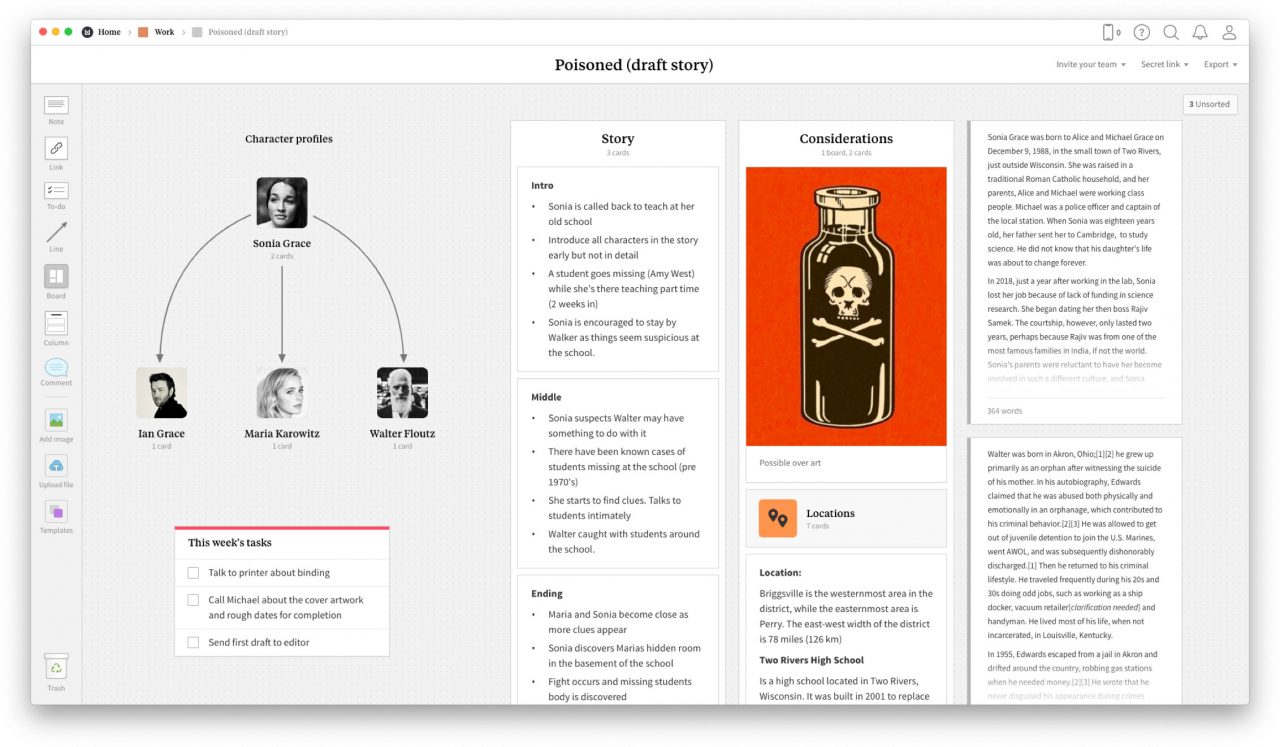
Check it out if: you're a plotter who likes a flexible workspace to organize ideas and see a birds-eye view of how your story outline is coming together.

FREE RESOURCE
Get our Book Development Template
Use this template to go from a vague idea to a solid plan for a first draft.
6. Evernote
Cost: free for basic plan or $9.99/month for premium. Its cute, little green elephant logo aside, Evernote is a great and easy-to-use option for writers who could do with a little more organization in their lives.

The app lets you quickly jot down thoughts, record audio notes, save online articles you’re hoping to reference, and it will sync all of this information across all of your Evernote-installed devices. What’s also handy about the app is the collaborative aspect of it: you can create shared accounts, so that multiple people can access saved documents at once.
Check it out if: you’re prone to getting great ideas while on the go, and need somewhere to make sure you don’t forget them by the time you’re home.
Cost: $5/month or $40/year (or try a 14-day free trial) While it’s ultimately a writing tool, one of the best assets of comprehensive programs like Ulysses or Scrivener are their organizational features. At the end of the day, whether you’re writing a blog post or a full-length novel, the seed of an idea doesn’t get too far without the ability to organize that idea into a cohesive piece of writing.
And that’s exactly what Ulysses allows you to do: organize your thoughts into a well-written work. This is accomplished through features like customizable writing goals and deadlines, plain text enhancements, a distraction-free typewriter mode, bookmarks, outlining functions, and more.
Check it out if: you’re working on a lengthy piece of non-fiction, like a blog post or essay. (For a comparison of Scrivener vs. Ulysses, keep reading!)
8. Scrivener
Cost: $45 (or a 30-use free trial) Literature and Latte ’s word processor is a popular writing tool — also, in large part, thanks to its organizational capabilities that seamlessly allow writers to turn fragmented ideas into a fully realized book/script/research paper/or whatever else you’re writing.
Scrivener vs Ulysses Apart from the price (Scrivener charges a one-time licensing fee while Ulysses charges yearly), the two platforms offer many of the same features. So we’ll focus on what makes the two programs different.
- Scrivener’s corkboard function is an absolute favorite for writers who rely on visual aid to help with outlining. The function looks like an actual corkboard, and lets writers pin notes to the board in chronological order.
- Scrivener offers templates for works such as fiction, essays, recipe collections, screenplays, comic books — which gives Scrivener another point for versatility.
- Ulysses boasts an interface that is slightly more clean and simple — so if ease-of-use is high on your priority list, it might be the better option for you.
- Ulysses offers a very helpful WordPress and Medium integration, which bloggers who publish on either of these platforms will love.
Check it out if: you’re working on a longer piece of content (like a book or screenplay) and want one comprehensive place to manage all your work. (And don’t forget to check out our equally as comprehensive review of Scrivener’s newest update : Scrivener 3!)
9. Hubspot's AI Content Writer
Cost: Free, with premium upgrade available
HubSpot’s Free AI Content Writer is designed to help bloggers streamline their content creation process. This tool can generate drafts of blog posts, website copy, emails, and more with ease and without additional resources, by relying on prompts or topics provided by users. For those suffering from writer's block, the AI content writer can also create outlines to help spur writing along.
For those already using HubSpot's marketing and sales tools, the AI content writer's integration will be extra handy.
Check it out if: you're a blogger short on time or inspiration.
Productivity tools
Alright, let’s kick things into high gear now. You know what you want to use to write, and your thoughts and ideas are concisely organized. If you’re finding it difficult to buckle down and get the job done (or struggle to write quickly or consistently), these resources will help you realize that Nike manta: just do it.
10. Ommwriter
Cost: free web version or $7 for the full program Do you find the clacking sound of old typewriters satisfying? Do you find soft, neutral colours calming? Does nothing really get you focused quite like a purposeful, long, deep breath? If so, Ommwriter might be the tool to help you reach your goal. As the site’s tagline reads, Ommwriter is “a perfect place to think and write.”

With soothing background noises, customizable keyboard noises, and peaceful backgrounds to choose from, Ommwriter could just be the “break” from everything else going on around you that you need to write.
Check it out if: your very best writing ideas come to you while in “savasana.”
11. To Doist
Cost: free or $4/month for premium plan Have you ever woken up in a cold sweat, panicking about something important you forgot to do? Or, god forbid, gripped in dread about how far behind you are on your word-count goals?
Well, To Doist might be able to help. It’s the ultimate app for creating to-do lists — but these aren’t your grandma’s pen-and-paper lists with little check marks beside them (though we mean no offense to your grandma). It lets you get a daily or weekly overview of your tasks, prioritize the tasks that are most important, and even lets you assign tasks to other people if you’re working on a specific goal with other collaborators.
Check it out if: you have never been able to find an agenda that’s souped up enough to keep you on track.

FREE COURSE
How to Build a Solid Writing Routine
In 10 days, learn to change your habits to support your writing.
12. Marinara Timer
Cost: Free The Pomodoro Technique is a time management method meant to promote productivity. In a nutshell, it stipulates that you should work for 25 minutes, then take a 5-minute break, then work for 25 minutes, take another 5-minute break, etc., etc.
The free-to-use Marinara Timer makes this easy for you by alerting you each time your work sessions and breaks are up. It also offers customizable timers in case the 25/5 isn’t quite right for keeping you on track. Fun fact: taking a break to stand up or walk (or do anything but sit!) every hour is also a good way to protect your back if you sit hunched at a computer working for long stretches at a time.
Check it out if: consistent breaks from work help actually keep you focused on the task at hand.
13. Cold Turkey
Cost: Free for basic plan or $20 for premium plan “Meet your match, Zuckerberg,” says Cold Turkey ’s tagline. In case that, paired with the writing tool’s name, doesn’t make it clear enough, Cold Turkey is a program that allows you to completely rid yourself of distraction. And when we say “completely,” we mean completely.
With Cold Turkey, you can block yourself from accessing certain websites — or even your entire computer — for periods at a time, only allowing you to use the current document you’re working on.
Check it out if: “willpower” is not a characteristic you’d ascribe yourself, and the only way for you to get something done is in a totally distraction-free state.
14. Freedom
Cost: $7/month or $29/year (or a 7-use free trial) Apart from pleasantly getting the “freedom” refrain from Aretha Franklin’s “Think” stuck in your head, the Freedom app is another resource that can turn your devices into tools of productivity once more.
It functions like Cold Turkey; however, a unique function of Freedom is the ability to sync your distraction-free periods across all your devices. So if you know that on Tuesdays, you want your computer, phone, and tablet to all block access to Twitter, Instagram, and Facebook — you can!
Check it out if: letting other people know not to bother you during your non-negotiable writing time isn’t enough, you need to let yourself know not to interrupt, well, yourself.
Cost: Free If total silence encourages your mind to wander, whereas light sensory action keeps your thoughts on the task at hand, Noisli will be a friend to you. The tool lets you choose from a range of soundtracks, such as rain, coffee shop, wind, lake, and more. You can mix several sounds at once, and choose the volume for each one. So let’s say you want to create the atmosphere of writing by a babbling brook, with a fire crackling next to you, and the moon shining brightly overhead. Noisli will make this happen for you!
Check it out if: you get the most work done with white noise.
Editing tools
If you’re planning to publish a book — or any kind of writing you’re hoping to make a profit from, it’s crucial that your work is thoroughly edited. To that end, working with a professional editor is an investment you should give serious thought to.
In the meantime, here are a few editing tools that can help you out along the way. Hopefully, they’ll either ensure a typo-free draft, so by the time you do work with an editor, they can spend less time fixing small typos and more time on big-picture work, or, if you decide to forego a professional edit, you’ll have the tools to do the best editing job you can.
16. Hemingway
Cost: Free The Hemingway app claims to make your writing “bold and clear.” It has a number of handy features like a word-counter and an automatic readability score. But its real use lies in the features that make suggestions to your prose. For instance, it might highlight a complex sentence that’s hard to read. It also highlights instances of passive voice , qualifiers, and adverbs. Let’s take a look at how this passage from Ernest Hemingway’s very own To Have and Have Not fares:

“Just” is highlighted because it’s a qualifier, and Hemingway suggests, instead: “Be bold. Don’t hedge.” The sentence in red is highlighted as being hard to read. And “probably” is pointed out as an adverb — the app suggests using a forceful verb instead.
Check it out if: you want to bring out your inner Ernie. (Curious what else Hemingway offers? Check out our full review of the app right here .)

NEW REEDSY COURSE
How to Write a Novel
Enroll in our course and become an author in three months.
17. Fictionary
Cost: $19/month or $169 per year
The Fictionary Story Editing software creates intelligent visuals that help you improve your story's structure, characters, plot, and settings. Using Natural Language Processing, Fictionary identifies your key story arc scenes and gives you actionable insights to improve the structure of your book. Annual subscribers get access to year-round live classes on writing and editing. Think of it like Peloton for writers. Check it out if: You want to get your story structure in the best possible shape before submitting to agents and/or editors.
18. Marlowe Pro
Cost: $29.95/mth or $199/year; $45 for single reports
This manuscript assessment tool will provide in-depth feedback on your novel within minutes. Using artificial intelligence, Marlowe can analyze your plot, pacing, story beats, and readability — then provide actionable insights (as well as comp titles ) based on its database of bestsellers across a number of genres.
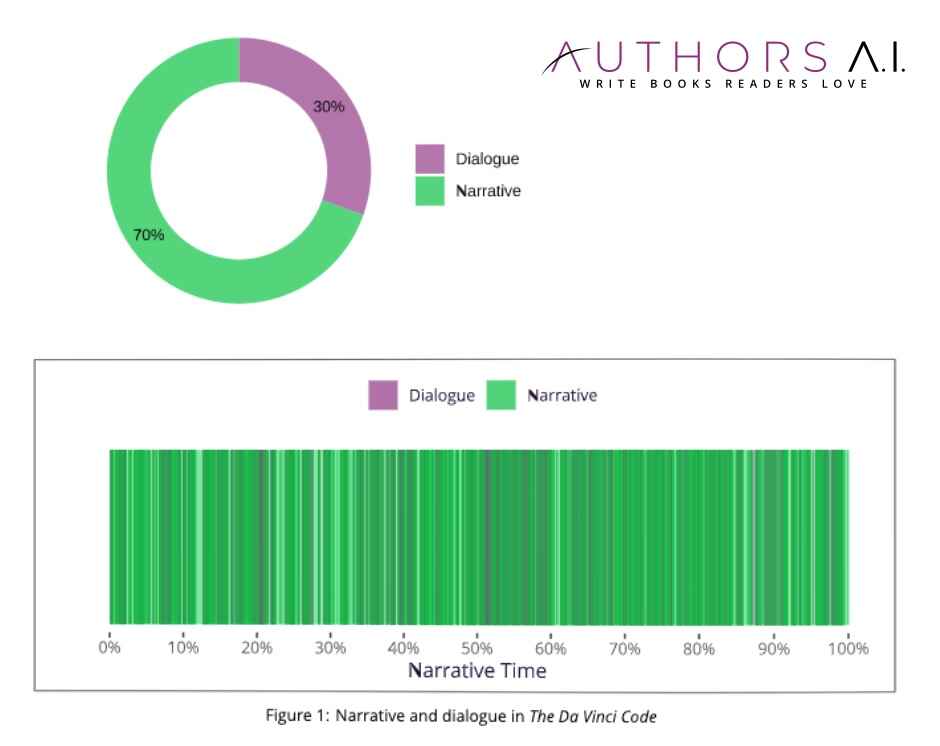
To try out this AI editor, claim a free report by entering REEDSYFREE at checkout. And for a 15% discount on a Marlowe Pro subscription , enter REEDSY15OFF when prompted at checkout.
Check it out: to take a scientific and methodical approach to your developmental edits.
19. Cliché Finder
Cost: Free Cliché Finder is exactly what it says on the tin: it combs through your writing in search of clichés, and then highlights them for you. It’s not always necessarily bad to use clichés in your writing, but when you do, you want to be purposeful about it (and not to mention aware of it!).
Check it out if: you want to avoid clichés like the plague, and for your book to sell like hotcakes — and the rest is history.
20. Grammarly
Cost: Free Have you ever sent an email, only to realize that you'd made a glaring typo just as you hit “Send”? Well, no more!
Grammarly essentially functions like the spell checker tool from Microsoft Word or Google Docs, but here’s the great part: it’s a plug-in that will work wherever you happen to writing. That means Twitter, Gmail, Google Docs, Facebook — anywhere. Plus it offers vocabulary or alternate word suggestions — for instance, it might suggest you replace “walking aimlessly,” with the word “wandering.” For a more in-dept analysis, check our full Grammarly review .
Check it out if: you’re typo-prone! (Read below for a comparison of Grammarly vs. ProWritingAid.)
21. ProWritingAid
Cost: Free browser extension or $79/year for the full software ProWritingAid is a tool you can install that will proofread and spell check your material for you , no matter where you’re writing. It will also offer suggestions to improve your overall language — outside of just grammatical technicalities. (You can even get 10% off via this special offer !)
ProWritingAid vs Grammarly The two programs offer a lot of the same services, so you might be wondering which one to pick. We have a review of ProWritingAid that dives deep into this comparison, but the main differences are:
- Grammarly is free to use, and while ProWritingAid offers a free Google Chrome plug-in, this free option only offers spell checking services, it won’t make editorial suggestions.
- ProWritingAid is slightly more tailored towards authors, while Grammarly is a slightly better fit for articles and essays. Ultimately, both tools lend a very helpful editing hand, so deciding between the two mostly boils down to the one you enjoy using more.
Check it out if: you want to make sure your writing is as polished as possible.
Workspace tools
At the end of the day, all you really need to write is a pen and paper. All the fancy tools and apps in the world won’t get the words out for you. That being said, creating an environment that’s appealing — and conducive! — to write in can make the whole process more enjoyable, and encourage you to get the job done.
Here are few physical tools to look over if you’re thinking of sprucing up your workspace.
22. Livescribe Pen
Cost: starts at $100 If you prefer writing on paper, but dread the process of transferring your words to a computer, Livescribe will likely be right up your alley. Through Bluetooth technology, the pen can actually transcribe your pen and paper words to your device. What’s more, it can also transcribe voice notes into digital documents for you.
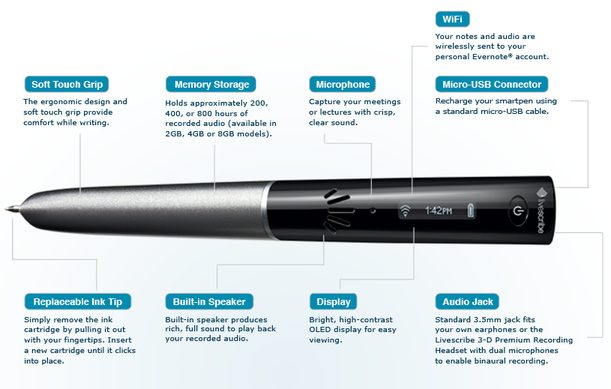
Check it out if: you’ve ever felt envy at Rita Skeeter’s Quick-Quotes Quill in Harry Potter and the Goblet of Fire .
23. Ergonomic desk setups
Cost: Varies As more and more of the workforce moves to sedentary jobs where the majority of 9am to 5pm is spent sitting — usually hunching — at a computer, a growing number of sitting-related health injuries have been occurring. That’s why looking into more ergonomically friendly desk setups is a good idea for writers who spend long hours at the computer — or even writing in a notebook. This could be a standing desk, or even just a number of textbooks piled under your desktop so that your screen is eye level, resulting in less stress on your shoulders.
Check it out if: you don’t want writing gains to come at the cost of growing back pains.
24. Computer Glasses
Cost: Varies Writers are all familiar with computer-caused eyestrains. Because you blink far less when looking at a screen than you do otherwise, computer vision syndrome (CVS) is a condition people have been developing due to long stretches of staring at a computer.
One way to help alleviate this — other than just making sure to take time looking away from your computer — is to invest in some computer glasses. They typically come in blue or amber shades, and are coated with a protective coating.
There are several brands you can check out, such as Pixel Eyewear or Felix Gray .
Check it out if: you notice itchy or tired eyes after long writing sessions.
Have you tried any of the above writing tools — and if so, which were your favorites? Or maybe you feel there are some great resources missing from this list? Let us know in the comments below!
Mystic says:
24/10/2019 – 03:38
I tried Cliche Finder several times and it found a couple of items in my text, but it didn't highlight where it was at. The rest of the tools here, that I can use since I'm on a strict income, are amazing!
Comments are currently closed.
Continue reading
Recommended posts from the Reedsy Blog

450+ Powerful Adjectives to Describe a Person (With Examples)
Want a handy list to help you bring your characters to life? Discover words that describe physical attributes, dispositions, and emotions.

How to Plot a Novel Like a NYT Bestselling Author
Need to plot your novel? Follow these 7 steps from New York Times bestselling author Caroline Leavitt.

How to Write an Autobiography: The Story of Your Life
Want to write your autobiography but aren’t sure where to start? This step-by-step guide will take you from opening lines to publishing it for everyone to read.

What is the Climax of a Story? Examples & Tips
The climax is perhaps a story's most crucial moment, but many writers struggle to stick the landing. Let's see what makes for a great story climax.

What is Tone in Literature? Definition & Examples
We show you, with supporting examples, how tone in literature influences readers' emotions and perceptions of a text.

Writing Cozy Mysteries: 7 Essential Tips & Tropes
We show you how to write a compelling cozy mystery with advice from published authors and supporting examples from literature.
Join a community of over 1 million authors
Reedsy is more than just a blog. Become a member today to discover how we can help you publish a beautiful book.

We made a writing app for you
Yes, you! Write. Format. Export for ebook and print. 100% free, always.

1 million authors trust the professionals on Reedsy. Come meet them.
Enter your email or get started with a social account:

Artificial Intelligence Tools for Detection, Research and Writing
- AI Detection
Prompts and Places to Start
Research and literature review tools, writing tools, grant writing tools, meeting and video tools, other useful tools.
- Higher Education Articles and Examples
- Texas Tech Resources
- AI Images and Multimedia

STEM Librarian

- Generative AI Product Tracker The Generative AI Product Tracker features an extensive, updated list of generative AI products that are either marketed specifically towards postsecondary faculty or students or appear to be actively in use by postsecondary faculty or students for teaching, learning, or research activities.
- AgentGPT Assemble, configure, and deploy autonomous AI agents in your browser that learn on their own without requiring prompts.
- Andi Andi is an AI search chatbot that is accurate, ad-free and privacy-focused. It uses a new type of search engine powered by generative AI combined with live data and semantic search technology. Instead of just links, Andi gives you answers - like chatting with a smart friend.
- Bearly This business focused tool allows you to interact with documents, transcribe audio and video, access the web and transcribe audio and generate meeting minutes and identify key takeaways.
- ChatGPT For those curious to try ChatGPT, this site provides a link to do so. ChatGPT is trained to interact in a conversational way. The dialogue format makes it possible for ChatGPT to answer followup questions, admit its mistakes, challenge incorrect premises, and reject inappropriate requests.
- ChatGPT Prompt Genius Discover, share, import, and use the best prompts for ChatGPT & save your chat history locally.
- Chatsonic Chatsonic is a conversational AI NLP processor that attempts to address the limitations of ChatGPT.
- Claude This AI chatbot is designed to be more ethical and safer to use than other chatbots and may be more suitable for users who are concerned about chatbots doing objectionable things.
- Forefront Forefront provides free access to ChatGPT-4, 3.5, as well as other models. It enables you to create and use personas, generate images, and share content with colleagues.
- FreedomGPT Download this free chatbot to fun locally on your computer to enjoy faster response and the privacy of not having to share your data with big tech companies.
- Gemini Formerly known as Bard, Google Gemini also offers a paid option called Gemini Advanced. Gemini features multimodality and performance, handling various input formats like text, code, audio, and video.
- GPT4All This uncensored chatbot is a free-to-use, locally running, privacy-aware chatbot that can be downloaded and trained on your own data without risking your privacy to big tech companies.
- Myriad: AI Content Prompt Generator This free tool lets you build and fine-tune prompts for writing, rewriting, or analyzing content. It’s optimized for ChatGPT but also works with Copilot and other AIs.
- Open Assistant This free, independent, uncensored chatbot has fewer guardrails and may respond more freely to questions than more conventional bots.
- Perplexity This free AI software operates in a manner similar to ChatGPT but it is not as popular so you may not have to wait as long to access it.
- Phind Phind is an intelligent search engine and assistant. It is connected to the internet and uses generative AI to give you the answer you're looking for in seconds instead of hours.
- Pickaxe Pickaxe is a platform to building, managing, and deploying AI prompts. It's a hub for prompt engineers and AI pioneers.
- Poe Poe is a bot aggregator that features access to many of the more popular chatbots and allows users to create their own bots as well.
- PromptHero This searchable index of prompts allows you to find the right words to get the best results from AI programs like ChatGPT and DALL-E.
- WebChatGPT Augment your ChatGPT prompts with more current relevant results from the web. This free extension adds relevant web results to your prompts to ChatGPT for more accurate and up-to-date conversations.
- You.com This tool allows you to search, chat, and create with AI.
- 2D Search 2Dsearch is a radical alternative to conventional 'advanced search'. Instead of entering Boolean strings into one-dimensional search boxes, queries are formulated by manipulating objects on a two-dimensional canvas.
- AI Researcher Simply pose a question, and AI Researcher will delve into an extensive library of textbooks, pinpointing the most relevant works and specific passages that directly address your research query.
- Any Summary Summarize a wide variety of file types including audio and video files or a URL in bullet points, quotes, or a full abstract.
- AskYourPDF Upload documents into this tool and it will allow you to chat with them and ask questions of them.
- ASReview Lab This tool helps with conducting systematic reviews by searching for and identifying the most relevant records by screening large amounts of text.
- Carrot Search This group of text clustering and visualization tools identifies themes in search results and organizes them into thematic groups.
- ChatPDF This tool is similar to ChatGPT but for PDFs. Upload a PDF and this tool will summarize and answer questions for free.
- Chat with PDF Summarise your documents, instantly answer questions, and understand research easily with AI.
- Citation Gecko Based on seed papers that you provide, Citation Gecko provides related papers based on citation networking.
- CitNetExplorer The tool allows citation networks to be imported directly from the Web of Science database. Citation networks can be explored interactively, for instance by drilling down into a network and by identifying clusters of closely related publications.
- Connected Papers This visualization tool allows users to submit a paper and it will create a graphic chart of similar papers allowing you to visualize trends. It includes a Prior Works feature to trace earlier works, Derivative Works to find literature reviews, and State of the Art Works to find subsequent papers.
- Consensus Consensus is a search engine that uses AI to extract and distill findings directly from scientific research. It reads the papers for you and extracts key results.
- Counterargument Generator An AI tool designed to help generate counterarguments to a statement or assertion.
- Danswer This tool provides answer with source links to your files and allows you to create personas to improve responses.
- DataSeer Analyze and extract the data you need from diagrams & datasheets: DataSeer provides automated visualization software that digitizes unstructured data trapped in 2D images and creates a digital twin database with API access.
- Dimensions AI This database provides free access to over 100 million publications and preprints to help you find exactly what you need, quickly and easily. It also shows the context - with citations, news and social media mentions, and links to funded grants and patents.
- Docalysis Upload a document or collection of document to chat with them and get answers to your questions instead of having to read them.
- docAnalyzer Ask questions and receive precise answers in real time. docAnalyzer.AI offers dynamic, context-aware interactions with one or multiple PDFs, powered by cutting-edge AI research for superior document analysis.
- Dovetail Accurately auto-transcribe interviews, build your taxonomy and visualize your research.
- Elicit: The AI Research Assistant Elicit uses language models to help automate research workflows, like parts of a literature review. Elicit can find relevant papers without perfect keyword match, summarize takeaways from the paper specific to your question, and extract key information from the papers. While answering questions with research is the main focus of Elicit, there are also other research tasks that help with brainstorming, summarization, and text classification.
- EvidenceHunt This tool provides a chat-interface to assist users in locating clinical and biomedical evidence.
- ExperAI The tool enables users to find experts in various fields, such as writing, engineering, psychology, and medicine, among others. Users can connect with experts to start a random chat or select a popular expert from the list.
- Explainpaper Characterizing itself as "a better way to read papers" Explainpaper allows users to upload a paper, highlight confusing text, and Explalnpaper will provide an explanation.
- Genei This tools provides keyword extraction and definition, semantic and query-based search within and across documents, summarization of entire documents and sections within them.
- Hypothesis Maker Hypothesis Maker is an AI-driven tool that generates a hypothesis based on your research question. Powered by advanced AI models like GPT-4 and ChatGPT, this tool can help streamline your research process and enhance your scientific studies.
- Inciteful Inciteful consists of two different tools: Paper Discovery builds a network of papers from citations, uses network analysis algorithms to analyze the network, and gives you the information you need to quickly get up to speed on that topic. Literature Connector is intended for interdisciplinary scholars trying to bridge two domains, and allows you to enter two papers to give you an interactive visualization showing you how they are connected by the literature.
- Iris.ai A comprehensive platform for research processing: smart search and a wide range of smart filters, reading list analysis, auto-generated summaries, autonomous extraction and systematizing of data.
- Keenious Keenious analyzes articles that you supply and searches for similar articles to provide you with related research.
- Laser.ai Designed to reduce literature reviews and systematic reviews time by half.
- Lateral Lateral allows you to import papers relevant to your topic and then finds similar ones that match those.
- Litmaps Litmaps uses citation searching to reveal new papers on a topic and then creates a visual map of the literature to illustrate how the studies relate to one another.
- MirrorThink Unleash the power of AI for science and find answers to all your burning questions about scientific methods, research, papers and more.
- Notion Upload content and this AI tool will allow you to ask questions, create summaries, drafts and tables.
- Open Knowledge Maps Based on the search term you provide, Open Knowledge Maps creates a visualization in the form of a map that provides an overview of the topic based on the most relevant papers that it finds.
- OpenRead OpenRead features a Paper Q&A tool that allows users to quickly answer any questions they have about a paper, a Paper Espresso feature that helps to generate literature reviews quickly, an AI-powered research tool that accelerates the reading process, a low code paper editor, and a powerful notes system with backlinks and outgoing links for increased efficiency.
- Paper Brain Search for complex academic white papers. This tool will then help simplify the papers by allowing you to ask questions in natural language about the papers.
- Paper Digest Paper Digest is an AI tool that distills a research paper into a three-minute read, allowing readers to quickly grasp the core ideas of a paper.
- Paper Wizard A tool for writing papers that includes source embedding and citations.
- PDF.ai Ask questions, extract information, and summarize documents that you upload. Not just articles and books, but legal agreements, financial reports, user manuals.
- Petal With Petal, you can narrow down from hundreds of papers to a few using any criteria you define through the AI. Identify measured outcomes, trace driving factors and influencers, assess potential weaknesses, and compare similar studies using our unique multi-document AI table.
- Prophy Find, follow, share, and collect the most relevant articles for you, find referees, construct editorial boards or panels and create peer performance comparisons across disciplines and career stages.
- PUREsuggest PUREsuggest is a scientific literature search tool that, starting from some seed papers, suggests scientific publications through citations/references.
- R Discovery R Discovery provides readers with the top 3 papers to read every day without having to search for them day-in day-out. It presents the key highlights of the papers upfront for you so that you only spend time reading full texts where it’s absolutely worth it.
- Reduct For qualitative researchers, Reduct is a collaborative transcript-based video and audio platform for reviewing, searching, highlighting, and editing content of people talking, at scale.
- ResearchAlde ResearchAIde is the ideal tool for students, researchers, and business professionals seeking to extract and synthesize relevant information from research papers quickly and efficiently, saving time.
- ResearchBuddy Research Buddy is an AI-powered tool that generates comprehensive Academic Literature Reviews with Harvard Referencing in just a matter of minutes. This tool is designed to simplify the process of literature review, making it quick and easy.
- Research Rabbit ResearchRabbit is an innovative “citation-based literature mapping tool" that allows you to supply a seed paper and find more papers relevant to the topic of interest.
- ScholarAI ScholarAI is a ChatGPT Plugin that helps connect users to peer-reviewed open access research articles.
- Scholarcy Scholarcy gives you more than just an abstract. It condenses papers into referenced summaries, highlights key claims and statistics and extracts tables and images. It helps you to filter out the noise, identify the most relevant papers faster, and easily jump between the sections in an article that are most important to your work.
- Scispace This AI program decodes research papers to help you read and understand scientific literature faster. Highlight confusing text, math, and tables to get a simple explanation. Ask follow-up questions and get instant answers. SciSpace Literature Review is also worth trying: https://typeset.io/search
- Scispace Copilot This AI tool summarizes scientific papers to reduce time spent reading.
- SciSummary Send an email or upload an article to our dashboard with text, a link, or even attach a PDF and within minutes you'll receive a summary in your inbox. The perfect tool for busy scientists, students and enthusiasts who don't have time to read through long and complicated scientific articles.
- scite Discover supporting and contrasting evidence for papers. Upload a PDF to check if the references have been supported, contrasted, retracted, received an expression of concern, etc.
- Semantic Scholar An academic search engine that utilizes artificial intelligence methods to provide highly relevant results and novel tools to filter them with ease.
- Smmry Summarize PDF or TXT documents by uploading a file or summarize online articles or webpages by pasting the URL.
- Snowball Snowball allows users to quickly find and filter through papers using the snowballing method. Start with a core collection of papers, and find more by going through their citations and references.
- Sourcely Upload an essay and Sourcely will provide reputable, credible academic references, summarize them, and extract key insights from them.
- TLDR This Upload text and this tool will summarize it for you, extract the citation, and estimate the reading time.
- VOSviewer VOSviewer is a software tool for constructing and visualizing bibliometric networks. These networks may for instance include journals, researchers, or individual publications, and they can be constructed based on citation, bibliographic coupling, co-citation, or co-authorship relations. VOSviewer also offers text mining functionality that can be used to construct and visualize co-occurrence networks of important terms extracted from a body of scientific literature.
- Zeta Alpha Use state-of-the-art Neural Search and Generative AI to improve how you and your team discover, organize and share internal knowledge.
- AI-Writer This subscription-based tool boasts the ability to generate article drafts just from a headline, cite verifiable sources, and draw upon up to date content.
- Article Forge Using advanced artificial intelligence and deep learning, Article Forge writes entire 1,500+ word articles automatically.
- Humata Summarize lengthy papers and turn complex technical papers into simply explained summaries. Automatically create new writing based on your file.
- Jenni AI This research and writing tool automatically completes sentences, creates tone and style, cites in multiple styles, paraphrases and rewrites.
- PaperPal This tool offers real-time, subject specific language suggestions to help you write better and faster.
- QuillBot This tool allows you to paraphrase text, check grammar, and get explanations to learn from mistakes and improve your writing.
- Sudowrite According to their website, Sudowrite is the non-judgmental,always-there-to-read-one-more-draft, never-runs-out-of-ideas-even-at-3am, AI writing partner you always wanted.
- Textero Get your papers and research done in minutes with Textero AI essay generator.
- Wordtune Spices Unlike ChatGPT, Wordtune Spices can cite its sources and utilize the most recent data from the internet.
- Writefull Automated paraphraser, abstract generator, title generator and copyeditor that has been trained on millions of scholarly journal articles.
- Writesonic An article writing tool that features paraphrasing, text expansion, and single-click summarization.
- Grantable Upload existing grant proposals and writing to train the AI. Input a question or prompt from an RFP. Let Grantable AI draft answers for you to approve using your previous answers.
- Granted ai Granted's specialized AI is trained on successful proposals that have generated billions of dollars. Instantly generate high-quality drafts for a wide range of grant proposals, appeals, letters of support, articles, and more, just by entering simple information about your project.
- Clipto Clipto transcribes your audio, video, or YouTube files to text swiftly and accurately. This app is essential for podcasts, corporate meetings, interviews, class recordings, and much more. It supports over 99 languages with 99% accuracy.
- Deep Motion Animate 3D, AI motion capture from any video, and SayMotion, harnessing the power of Generative AI to seamlessly transform text into dynamic animations.
- Fathom Fathom records, transcribes, highlights, and summarizes your meetings so you can focus on the conversation
- Fireflies.ai Fireflies.ai helps your research team transcribe, summarize, search, and analyze voice conversations
- Invideo Enter a text prompt and invideo generates a script, creates scenes, adds voiceovers, & tweaks the video at your command.
- Lucas AI Video Creator Turn any text prompt into a professional video, including interactive video, without scripts or tech skills. A built-in editor makes it easy to make changes.
- Luman5 This tool enables users to turn text or blogs into video.
- Machine Translation This tool is designed to analyze, compare, and recommend the best machine translation for any given text and language pair. It relies on the formidable abilities of GPT-4 to determine the strengths and weaknesses of each MT engine translation output, which in turn provides a tailored translation experience for each user.
- Otter.ai This AI meeting assistant records audio, writes notes, automatically captures slides, and generates summaries.
- Runway Runway AI is a platform that combines machine learning and artificial intelligence (AI) to streamline the process of generating and editing images and videos.
- Sora Sora is a text-to-video model that can generate videos up to a minute long while maintaining visual quality and adherence to the user’s prompt.
- Summarize.tech Get a summary of any long YouTube video, like a lecture, live event or a government meeting. Powered by ChatGPT.
- Synthesia This video generation platform allows you to turn text into video.
- Tome Type a prompt into the command bar and let Tome generate a presentation, outline, or story for you—complete with text and images.
- Whisper AI Whisper is a free speech-to-text tool that allows you to transcribe audio into text.
- 152 Best AI Tools of 2023 The author describes the pros and cons and pricing of dozens of useful AI tools.
- AIPRM’s Ultimate Generative AI Glossary Helpful for understanding AI-related jargon and technospeak.
- AI Tools Club Find useful artificial intelligence (AI) tools. The AI Tools Club expert team reviews and provides insights into some of the most cutting-edge AI tools available.
- AlphaCode AlphaCode uses transformer-based language models to generate code at an unprecedented scale, and then smartly filters to a small set of promising programs.
- Audemic This tool allows you to upload an article and have it read to you as an audio track.
- Chatbot Arena This free tool offers a side-by-side interface that allows users to easily compare how different chatbots respond to the same prompt.
- ChatGPT Code Interpreter Code interpreter allows ChatGPT subscribers to analyze data, create charts, solve math problems and edit files, among other uses. It also supports uploading and downloading files, which was not possible in ChatGPT before. Access limited to ChatGPT subscribers.
- Futurepedia AI Tools Directory This site contains a collection of AI tools and claims to be "the largest AI tool directory, updated daily."
- Future Tools This site collects and organizes AI tools into categories that you can select to see what tools are available.
- GitHub Copilot GitHub Copilot uses the OpenAI Codex to suggest code and entire functions in real-time, right from your editor.
- Julius AI Upload data to query and create visualizations, perform modeling and predictive forecasting, and generate polished analyses and summaries.
- Kudos Kudos uses AI-generated, easy-to-understand summaries that you post on their site to expose your research to a wider audience.
- Mainstay This AI system features automated two-way chatbot messaging that sends students timely reminders of course requirements, customized feedback on progress, weekly digests with due dates, encouragement and support during exam time and quizzes offering practice exams.
- Powerdrill Upload data sets and ask questions of them and create personal AI assistants without using code.
- QuestionWell Just input some reading or a video, and the AI will write essential questions, learning outcomes, and aligned multiple choice questions, which you can then export to your favorite tool.
- Quivr Quivr is a cloud-based open source platform that allows you to upload and store papers and pose queries like "what are the gaps in this paper?"
- Sentient Syllabus A newsletter addressing issues related to the growth of artificial intelligence in the academy.
- Teach Anything This tool allows you to write your question, select language, select difficulty and receive an answer based on your selections.
- There's An AI For That This is an AI aggregator site that features thousands of AI tools and a searchable index.
- TutorAI Type a topic in the search box and it will create a course for you.
- Zapier Zapier allows you to automate your workflow by describing what you want using text rather than code.
- << Previous: AI Detection
- Next: Higher Education Articles and Examples >>
- Last Updated: Jun 21, 2024 11:28 AM
- URL: https://guides.library.ttu.edu/artificialintelligencetools
36 Online Research Tools for Students
For many students, the most challenging part about writing a research paper is the research. Even the best students often don’t know how to conduct research or even where to start.
But you’re in luck:
This article by Custom-writing.org experts provides a list of great research tools that will be useful at every stage of the process. The collection includes everything necessary to write a great paper, from online public libraries to dissertation databases. There are also some data analysis and data visualization research tools, as well as organizers for scholars. The list includes brief descriptions for each of the tools. All you need is to continue reading, choose the tools you like most, and get a fantastic result!
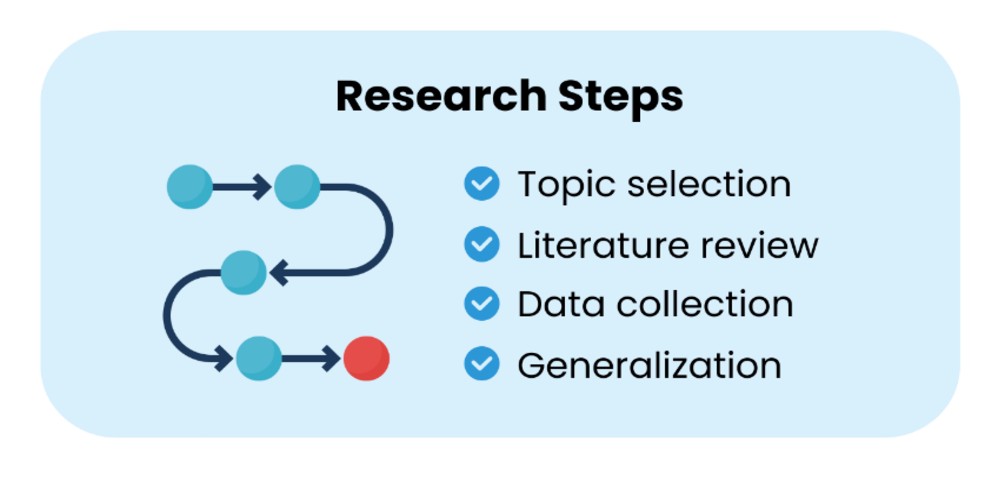
- 👣 Research Steps
- 💡 Topic Generating Tools
- Research Databases
- Digital Libraries
- Discipline-Oriented Libraries
- Dissertation Databases
- 🔬 Data Analysis Tools
- 📈 Data Visualization Tools
- 📑 Organizers for Scholars
1. 👣 Doing Research: Key Steps
Regardless of the subject field, all research has a similar structure. Such an approach facilitates the mutual understanding of scientists from neighboring or even distant domains. As a rule, scientific texts are challenging to write and read. That is why you need to observe the following procedure.
- Topic selection. Surprisingly, this is the most creative part of a research project. The subject area shall be topical and relevant, and the title must be concise and informative.
- Literature review and concept development . To write something new, you need to know what has already been written by other scientists. Study the available literature on your subject and define what statement or concept you will defend in your research.
- Empirical part: data collection and analysis. Accumulate the evidence to support your thesis statement .
- Conclusions and recommendations. Any research finishes with generalizations of the findings. You can as well give general suggestions for your successors in research. At this step, online summarizer would be a highly effective tool.
The following sections provide you with tools and techniques to facilitate each of the four stages. There is also a list of tools helping to organize the entire research procedure.
2. 💡 Topic Generating Tools
In science and academia, nobody receives a ready-made topic to work on. As a rule, you are given a direction in which you should look for an unexplored field of knowledge. With this direction in mind, you can brainstorm a compelling topic that would be engaging. There are multiple tools to make the task an easy one.
| 🌐 | Lucidchart is an excellent instrument based on infographics. The diagrams in this software help to understand people’s behavior, data, and processes. The visualization allows to find out the interdependence between different phenomena. If you have a large bulk of information to process before generating a topic, this should be your choice. | |
| 🌐 | Mind42 is a free (ad-supported) mind mapping tool. Structure your notes here for further reference. It works as a block diagram, where units of information are connected with arrows. It is user-friendly, so you will not waste much time on preparations. | |
| 🌐 | This one is more about the formulation. If you have come up with a topic, but struggle with its wording, visualize it with the tool. The tool gives you a list of word associations and their relationships. Considered by many to be the , the service is excellent for theoretical research as it builds word maps, provides their meanings, and suggests related terms. |
3. 📚 Research Tools for Making a Literature Review
3.1. research databases.
So, you have created a word document and noted the title. What next? You should look for the most authoritative works in the required sphere. How do you know which ones are the most influential? There are online research tools that create lists of the most cited scientific articles.
| 🌐 | The same company that produced the world’s top search engine also offers the world’s top scholarly search engine. Google Scholar works just like Google. But it directly links you to only publications in countless academic journals. When using the system, look at the right-hand side of the search results. There, Google Scholar shows you if a PDF is available for each article. | |
| 🌐 | Many academic research services charge a fee. But Web of Knowledge is the most widely used. And this is for a good reason: it provides search features missing from Google Scholar. Check to see if your library offers access to the Web of Knowledge. | |
| 🌐 | This is the research resource of choice for law school students and lawyers. Of course, this is an expensive service for individuals. But your school may have free access. | |
| 🌐 | Scopus is a bibliographical base used by over five thousand academic, governmental, and corporate establishments. It searches through about 75 million entries, including 194’000 books. You can search by author, document title, or affiliation. It shows the citation rate of almost any article from any discipline. The tool also suggests similar documents by related references, which could accelerate your research. | |
| 🌐 | WoS is a multidisciplinary citation database trusted by more than 9 thousand institutions. It allows for the historical tracking of research questions in all spheres of knowledge. 9.1 billion cited references would suffice for the most exigent researcher. Web of Science can be used as a resource to find trusted materials in the public domain. |
3.2. Digital Libraries
Once you have found enough references, you need to study them. Visiting conventional libraries is often a waste of time since many contemporary research documents are accessible on the web. Digital libraries are usually paid web research tools, but many universities and colleges purchase a subscription for their students.
| 🌐 | Google Books was launched in 2004. Today, it offers full-text searches of over 25 million books. That’s a lot of reading! | |
| 🌐 | As a leading research library, the Library of Congress has an incredible number of online resources. Their website lets you search for nearly every book ever written. You can also skim their vast online collections. | |
| 🌐 | The goal of Project Gutenberg sounds crazy. They aim to digitize every book that is not under copyright. In brief, they offer almost every classic book published before 1900. | |
| 🌐 | This database searches for books, primary sources, and journals. It provides free access to open community collections of museums, public libraries, and archives. The resource has a special offer due to COVID-19 displacement of students, offering free use of unlicensed materials. Still, only the participating educational institutions are eligible. You can share your lists with other users if you wish. | |
| 🌐 | ScienceDirect focuses on medical, technical, engineering, and scientific research, but humanities are also covered. It provides access to foundational and theoretic materials and the latest findings. You can search by keywords, author, title of book or journal, volume, issue, and page. All the literature is peer-reviewed and can be trusted. | |
| 🌐 | ResearchGate provides more than 135 million publication pages. The tool is an excellent solution to keep up with the latest research news. It allows sharing your research with peers, collaborating with them across the continents, and asking for expert support. You can as well track how many people have read or referenced your work. | |
| 🌐 | Here you can access an extensive collection of books and reference resources during 48 hours on a pay-per-view basis. Many articles are available for paid download for lifetime use. It can be done without a subscription. Through this resource, you can find reliable user guides, training videos, and webinars. |
3.3. Discipline-Oriented Libraries
If you are working in a narrow scientific field, multidisciplinary libraries may not meet your expectations and needs. Besides, if various disciplines discuss your research question, the search for references becomes a daunting task. Then you should explore discipline-oriented libraries. They function just like any other digital library but provide access to works in only one area of knowledge.
| 🌐 | Johns Hopkins University hosts this web resource. It mainly focuses on digital articles and book chapters on . | |
| 🌐 | The U.S. National Institutes of Health’s National Library of Medicine offers PubMed Central. This is a free source for almost 4 million academic articles on biology and . | |
| 🌐 | This is the place to start if your research focuses on any of the many engineering fields. | |
| 🌐 | Cornell University’s arXiv is the most extensive collection of open-source papers in mathematical fields. Subjects range from to statistics and finance. |
3.4. Dissertation Databases
Ph.D. theses are usually written by young scientists. They are interested in being cited as much as possible, as it raises their researcher’s status. For this reason, top universities allow free access to Masters’ and Ph.D. papers written by their students. You can use these databases in your research.
| 🌐 | Proquest is the most extensive open-access dissertation database. It provides full-text versions of theses & dissertations on a range of disciplines. | |
| 🌐 | This archive contains every and completed at MIT since 2004. But some date back to the 1800s. The complete collection contains more than 50000 texts. | |
| 🌐 | The graduate work of over a hundred thousand Stanford students is searchable from anywhere in the world. | |
| 🌐 | Since 1997, the University of Colorado has archived every one of their Ph.D. dissertations here. | |
| 🌐 | At the University of Illinois, students have the option of depositing their theses on IDEALS. And you have the option of searching for their dissertations! | |
| 🌐 | Last but not least, check out Harvard’s archive of dissertations begun in 2012. It’s one of the most famous universities in the world for a very good reason. |
4. 🔬 Research Tools for Data Analysis
Data analysis is an essential part of any empirical research. It requires discipline-specific skills and knowledge of research instruments. Below you can find just a small share of data analysis tools available online or downloadable for most operating systems.
| 🌐 | Many people know it, but few of us can use its functionality. Its principal benefit is that this program is available in the MS Office package. It is an old tool, but it is the best for simple statistics, customizable graphics, and data visualization. | |
| 🌐 | SPSS or Statistical Package for the Social Sciences is the most popular statistical software among human behavior researchers. It allows for parametric and non-parametric studies, descriptive statistics, and graphic visualization of the findings. You can also write scripts for automated analysis or more advanced statistical research. | |
| 🌐 | This package is free and widely used in many disciplines. Its toolboxes (or plugins) simplify any data processing. The functionality is the best among similar software solutions. It requires a certain knowledge of coding. Still, you can discuss any issues with the extended community that builds and improves the package. | |
| 🌐 | Stata is more functional than SPSS but simpler than R. Detailed user guides and tons of valuable information on forums can help you resolve almost any issue. This paid software is available for any platform. It is user-friendly and easily automated. |
5. 📈 Data Visualization Tools
When your research findings are ready, the worst thing you can do is pour all the statistical data on your future readers. Visualization of all those percentages, ratios, and correlations makes your paper engaging and easy to follow. Respect your reader’s time and try not to turn your research paper into a quiz.
| 🌐 | This is an excellent and totally free example of data visualization tools. Its interactive charts are explicitly designed to be embedded online. It offers a wide range of chart formats to choose from. The most significant benefit is its ability to work with dynamic data. However, Google Charts have limited support, namely tutorials and forum discussions. | |
| 🌐 | Tableau astonishes with the number of data uploading options. Besides, it has a desktop, online, and free public versions. Unlike Google Charts, it has multiple video tutorials, so only the lazy will not master it. Still, its paid versions are expensive (about $70), and the public version does not permit you to keep your data private. | |
| 🌐 | Infogram has a free version offering basic functionality and tiered pricing for the paid version. Its drag-and-drop editor is user-friendly and intuitive. The tool allows for interactive visualizations to be integrated into websites and apps. Its drawback is the small number of built-in data sources, as compared to other programs. | |
| 🌐 | This is a free, open-source JavaScript library to manage data documents. People without programming skills can easily use software tools to create visualizations. Multiple types of charts and a customizable interface make it convenient and understandable. Still, programming knowledge will be beneficial when working with this software. |
6. 📑 Tools to Organize Your Research Process
Good organization is something needed on every research step. Below is a list of the most useful organizational tools for scholars.
| 🌐 | This tool unites the functions of a typewriter, ring-binder, and scrapbook. The trial version lasts for 30 days and includes all the features of the full version. This period is enough to understand whether you enjoy working in this program and complete a short project. It provides you with multiple methods of how to enjoy your research. | |
| 🌐 | This is a excellent option for theoretical research that includes numerous citations. It is an open-source program facilitating the process of quoting and indicating the sources. It also collects and structures your information. These structures are tagged with keywords, which is very convenient for large-scale projects. Zotero has a function that creates a bibliography in any citation style. | |
| 🌐 | Mendeley creates a personal library directly from your browser tabs and desktop files. In a few clicks, you can generate citations and references to your library list. It has a function of personalized recommendations to stay informed about the newest research results. Besides, here you can browse information about more than 5’000 funding organizations and their grants. |
Most people work with the software they are used to, ignoring the new and more functional alternatives. It is often rewarding to invest your time into exploring a new tool than to research and write your thesis in the same old way. Share your opinion about the described instruments in the comments and suggest your favorite ones!
🔗 References
- Tools for Researchers: Augusta University
- Research Tools: Smithsonian Libraries
- Useful Research Tools: Oregon tech Libraries
- Tools for Researchers: University at Albany
- Conducting Research: WUSTL Libraries
- Organizing a Research Project: Duke University
- 15 Steps to Good Research: Georgetown University Library
- WRITING A RESEARCH PAPER: UW-MAdison Writing Center
- Share to Facebook
- Share to Twitter
- Share to LinkedIn
- Share to email

Graduating from high school and entering college, you may feel intimidated by the upcoming courses. As you wait for the first essay or another writing task, you might feel completely overwhelmed. Fortunately, there are plenty of effective writing strategies to help you get through your homework in one piece. And...

As a student, you might be wondering how to increase your IQ and boost your academic success. After all, students with a high IQ level are really lucky, right? They can study easily, sail through exams, build a successful career, and end up with a very high salary. All in...

Student life can be stressful even in the best of times. And it has become almost axiomatic that student life comes with substantial weight gain in the first few semesters of college. Causes of the infamous freshman 15 are manifold, and keeping those pounds off may prove tricky.

To the uninitiated, journalistic writing may appear intimidating at first. Even if you’ve done other kinds of writing before, chances are you’re feeling the pressure to “deliver.” Because unlike essays and research papers that have a guaranteed invested audience (your teacher), articles have the additional task of gaining and keeping...

Nobody likes this part of the writing process. It seems that the assignment is complete, and you can do something else, but no. If the text quality is low, editing can take you as much time as the writing. Most high school and college students do not know that editing...

Essay writing can be manageable if you take a strategic approach to the process. Yet it still requires your close attention. The variety of requirements, including the format intricacies and language peculiarities, can make your head spin. It’s easier to forget something than not. However: This will never be the...

Are you struggling with the attention-getter for your motivational speech about school? Or maybe you need to add some humor to your creative essay on learning? Don’t hesitate to use funny quotes about education! We are sure you will impress everybody with your creative ideas and our funny sayings.

Every student knows that a boring lecture can be the best sleeping pill ever – especially when you are tired. You might start blinking slowly, and then the lecturer’s words will seem so far away and without any meaning, sounding like a sweet lullaby. Students beware: avoid classroom naps! They...

Descriptive writing is the equivalent of drawing with words instead of lines and colors. You need to create vivid pictures, using only your words and memory or imagination. Your goal is to make your readers see, hear, taste, smell, and feel what you want to say. How can you start...

A couple of centuries ago, writers received their salaries at a fixed rate for a line or a word. It took them hours to count how much they had written. To facilitate the counting process, teachers used to give assignments in the number of pages, not words. Nowadays, any text...

If you never gave a persuasive speech before a large audience, you probably want to know how this task can be approached. First and foremost, you need to construct a good persuasive speech outline that will be the cornerstone of your success. There are several ways in which you can...

Online classes are becoming increasingly popular each year; after all, it’s convenient and allows you to study from the comfort of your home! What’s not to like? Unfortunately, online students have tons of classes and assignments each semester, and it isn’t easy to complete them all. In your search for...
Please, help me with a dissertation topic for my Ph.D. in Hospitality and Tourism Management.

New database features 250 AI tools that can enhance social science research
Assistant Research Professor at the Social Science Research Center, Mississippi State University
Professor of education, Mississippi State University
Research associate in sociology, Mississippi State University
Doctoral student in psychology, Baylor University
Disclosure statement
The authors do not work for, consult, own shares in or receive funding from any company or organisation that would benefit from this article, and have disclosed no relevant affiliations beyond their academic appointment.
Mississippi State University provides funding as a member of The Conversation US.
View all partners
AI – or artificial intelligence – is often used as a way to summarize data and improve writing. But AI tools also represent a powerful and efficient way to analyze large amounts of text to search for patterns. In addition, AI tools can assist with developing research products that can be shared widely.
It’s with that in mind that we , as researchers in social science , developed a new database of AI tools for the field . In the database, we compiled information about each tool and documented whether it was useful for literature reviews, data collection and analyses, or research dissemination. We also provided information on the costs, logins and plug-in extensions available for each tool.
When asked about their perceptions of AI, many social scientists express caution or apprehension. In a sample of faculty and students from over 600 institutions, only 22% of university faculty reported that they regularly used AI tools .
From combing through lengthy transcripts or text-based data to writing literature reviews and sharing results, we believe AI can help social science researchers – such as those in psychology, sociology and communication – as well as others get the most out of their data and present it to a wider audience.
Analyze text using AI
Qualitative research often involves poring over transcripts or written language to identify themes and patterns. While this kind of research is powerful, it is also labor-intensive. The power of AI platforms to sift through large datasets not only saves researchers time, but it can also help them analyze data that couldn’t have been analyzed previously because of the size of the dataset.
Specifically, AI can assist social scientists by identifying potential themes or common topics in large, text-based data that scientists can interrogate using qualitative research methods. For example, AI can analyze 15 million social media posts to identify themes in how people coped with COVID-19. These themes can then give researchers insight into larger trends in the data, allowing us to refine criteria for a more in-depth, qualitative analysis.
AI tools can also be used to adapt language and scientists’ word choice in research designs. In particular, AI can reduce bias by improving the wording of questions in surveys or refining keywords used in social media data collection.
Identify gaps in knowledge
Another key task in research is to scan the field for previous work to identify gaps in knowledge. AI applications are built on systems that can synthesize text . This makes literature reviews – the section of a research paper that summarizes other research on the same topic – and writing processes more efficient.
Research shows that human feedback to AI, such as providing examples of simple logic, can significantly improve the tools’ ability to perform complex reasoning . With this in mind, we can continually revise our instructions to AI and refine its ability to pull relevant literature.
However, social scientists must be wary of fake sources – a big concern with generative AI . It is essential to verify any sources AI tools provide to ensure they come from peer-reviewed journals.
Share research findings
AI tools can quickly summarize research findings in a reader-friendly way by assisting with writing blogs, creating infographics and producing presentation slides and even images.
Our database contains AI tools that can also help scientists present their findings on social media. One tool worth highlighting is BlogTweet . This free AI tool allows users to copy and paste text from an article like this one to generate tweet threads and start conversations.
Be aware of the cost of AI tools
Two-thirds of the tools in the database cost money. While our primary objective was to identify the most useful tools for social scientists, we also sought to identify open-source tools and curated a list of 85 free tools that can support literature reviews, writing, data collection, analysis and visualization efforts.
In our analysis of the cost of AI tools, we also found that many offer “freemium” access to tools. This means you can explore a free version of the product. More advanced versions of the tool are available through the purchase of tokens or subscription plans.
For some tools, costs can be somewhat hidden or unexpected. For instance, a tool that seems open source on the surface may actually have rate limits, and users may find that they’ve run out of free questions to ask the AI.
The future of the database
Since the release of the Artificial Intelligence Applications for Social Science Research Database on Oct. 5, 2023, it has been downloaded over 400 times across 49 countries. In the database, we found 131 AI tools useful for literature reviews, summaries or writing. As many as 146 AI tools are useful for data collection or analysis, and 108 are useful for research dissemination.
We continue to update the database and hope that it can aid academic communities in their exploration of AI and generate new conversations. The more that social scientists use the database, the more they can work toward consensus of adopting ethical approaches to using AI in research and analysis.
- Artificial intelligence (AI)
- Social science

Postdoctoral Research Fellowship

Health Safety and Wellbeing Advisor

Social Media Producer

Dean (Head of School), Indigenous Knowledges

Senior Research Fellow - Curtin Institute for Energy Transition (CIET)
Experience the future of academic writing
Boost your chances of success with real-time, subject-specific language suggestions that help you write better, faster!
Research, Write, Cite: Enjoy Uninterrupted Writing with Paperpal
Get science-backed answers to your questions from 250M+ research articles and save relevant citations to your library!
Online Plagiarism Checker For Students & Academics
Avoid accidental plagiarism in your academic text with Paperpal’s accurate plagiarism detector.

1Mn+ Academics love Paperpal
Rated Excellent on Trustpilot
“It offers suggestions about tenses, and paraphrasing and helps re-organize my paragraphs, giving them better language structure. I feel confident about my manuscripts after running them through Paperpal. ”
" Unlike Grammarly, Paperpal aligns and tailors my sentence structures to the convention of academic writing. It also helps me to rephrase or simplify unclear sentence structures and helps me write with confidence and ease"
" What I love about Paperpal is that it has an element of context sensitivity. It understands the context in which the content is written and then gives suggestions"
" The best thing about Paperpal Word is that you get edits in real-time , and not when you’re done writing your document."
“Because of Paperpal, my manuscript is now free of errors, more concise and more readable! ”
“Its easy to use, helpful in drafts as an academic and unlike ChatGPT, it doesn't provide same suggestions everytime. ”
Try Paperpal
Unmatched features for academic writing
Language suggestions.
Paperpal understands academic context, suggesting precise language corrections without changing references, equations, technical terms, and non-English words.

Plagiarism Checks
Get similarity score, colour-coded results and side-by-side comparisons to sources.
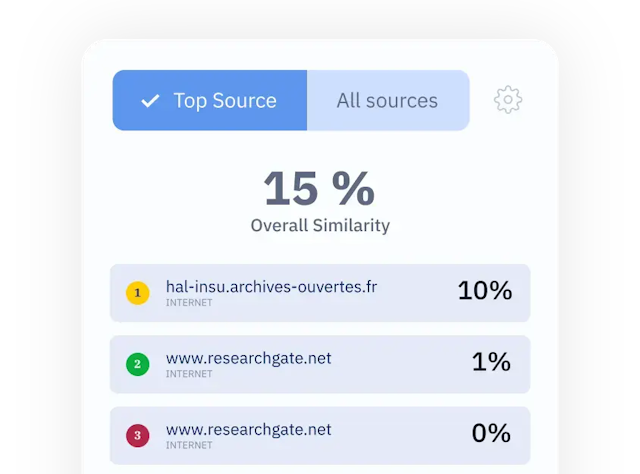
Research NEW
Get science-backed answers to your questions from 250M+ research articles as you write
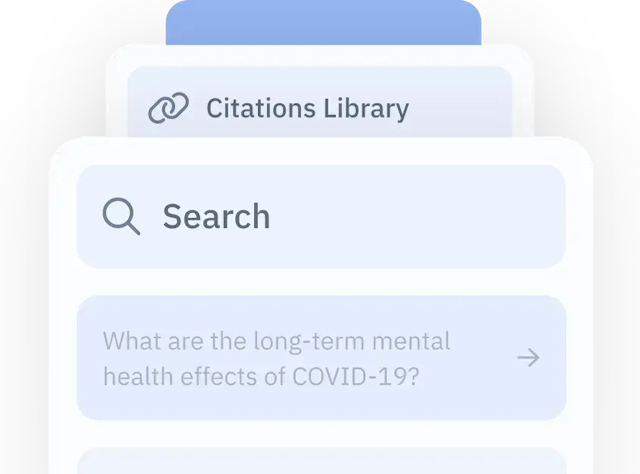
Brainstorm ideas, get outlines and titles, create abstracts, summaries, study highlights, or craft powerful emails to journals with a click.

Paraphrase text to improve clarity and tone
Accurate paraphrasing that retains the meaning of your work, helps meet journal-prescribed word counts and maintains a formal tone.
High quality academic translations for your text
Context-sensitive translations from 25+ foreign languages to English, letting you focus on your research while we polish your writing.
Pre-submission checks to avoid desk rejection
Comprehensive submission readiness report with 30+ language and technical checks.
Contextual synonyms for better vocabulary
Improve the clarity of your text with relevant synonym suggestions that are validated based on published literature.
Paperpal has you covered at every writing stage
Have a ready manuscript that needs review? Full language checks with edits in track changes and multiple free rounds to ensure high-quality writing
Work anywhere online with real-time, secure, accurate language and grammar checks and rewrite suggestions for academic writing
Writing a paper on MS Word? Paperpal for Word provides assistive writing with instant language and grammar suggestions as you write
Be a part of the new writing revolution
Our powerful AI tools transform your work by giving you the power to improve your writing. Paperpal is built for all academics. Learn more below

Frequently Asked Questions
Is my data used for training paperpal’s ai, how does paperpal work, how to use paperpal in ms word, can i use paperpal for free, what is the price for paperpal paid subscriptions, who can use paperpal, what all can paperpal be used for, how secure is my manuscript and does paperpal use my data, what ai models are used in paperpal, will my paperpal edited document be flagged as plagiarised, will my paperpal edited document be flagged by ai detectors, will i retain copyright over my paperpal edited document, take the first step towards academic writing excellence.

12 Best AI Tools for Dropshipping In 2024 - Free & Paid
This article is about the best AI tools for dropshipping.

The goal is to introduce you to tools that will help you:
- Automate your work
- Reduce the need for employees or freelancers
- Prevent spending too much money on tasks
Over the years, I built several stores the manual way. I also wrote ads and product descriptions manually. It took me weeks to do all these. Today, all these tasks will only take a few seconds.
In addition, I will also discuss the following:
- What you can expect from AI
- Best AI support tools for dropshippers
- The best alternative to store building
- Ways to use AI wisely for dropshipping
Here is our list of the best AI tools for dropshipping :
- Dropship – Best AI Built stores
- Google Gemini (formerly Bard) – Best for writing articles
- Flair - Best for product photography
- Looka – Best for creating logos
- Browse AI – best for data scraping (competitor analysis)
- CopyAI – Best for writing product descriptions
- Murf AI – best for text-to-speech voiceover
- Creatify – Best for creating video ads
- Magic Design – Best for social media images
- TIDIO – Best AI customer support
- Leonardo AI – Best for creating images
- ChatGPT – best for research
In the end, I am hoping that you can pick the AI tools you need according to the status of your business. I also recommend that you at least experiment on all of them, as most of them are free.
What is AI and What Does It Do?
Science defines “intelligence” as the capacity to learn. As such, artificial intelligence refers to any human-made program (software) that can learn.
The difference between AI and a typical program is that AI can overwrite itself. It reprograms itself based on:
- Your actions
- The available data
- The logic programmed into it
We use AI every day. From YouTube to social media, there is an AI component that interacts with you. In dropshipping, it is possible for an AI to:
- Write product descriptions for you
- Tell you what keywords to use
- Make offers to a customer based on his actions
- Run your store operations instead of hiring a virtual assistant
As you can see, there are many things that AI can do today. To some extent, AI is becoming a threat to jobs that are so easy to do. To dropshippers, this is a boon, not a bane, because AI can save you a lot of money.
12 Best AI Tools for Dropshipping
1. dropship – best ai built stores.

At Dropship, you can expect to get a fully functional dropshipping store built specifically for your target market.
For as little as $49, you can get a store that has your brand, which means you just need to supply things like your logo and preferred color scheme.
In addition, you will also get:
- Product Imports – the dropshipping store package includes 30 products. The product selection depends on your selected niche. In addition, an expert will handpick these products for you.
- Integration – since Dropship.IO will build the store, the integration with Dropship is part of the service. With it, you can find suppliers and products. You can also spy on competitors and ads.
You can get a Dropship.IO store for free. All you need to do is follow Dropship’s Instagram page , and you may be able to get a free store.
However, the free store will not have the same bells and whistles as the paid one.
2. Google Gemini (formerly Bard) – Best for writing articles

You will certainly need articles for your blog, and Google Gemini is the best AI writing program you can use today.
Why do you need blog posts anyway? As a dropshipper, you will find it easier to market your store if you have tons of blog posts. These blog posts will:
- Build your credibility as an expert in your niche
- Rank on search engines, making it possible for people to find you organically
- Supply people with knowledge, making you an authority
Google Gemini is easy to use. All you need to do is write prompts, or commands, to tell the AI what to do.
Here is an example:

As you may have observed, the output is simplistic. You can expand on this, though, and you can do this by first asking Gemini to create an outline. From here, you can ask the AI to write content for each main point.
Another cool feature of Gemini is the “related topics section.” At the bottom of the article, it will tell you what people are searching for—these are keywords related to the topic you asked Gemini to write about.

You can use these keywords in your article or write independent articles about them. Since Gemini is part of Google’s universe, you have a guarantee that these keywords are really in demand.
Just to be clear: these “Search-related topics” are phrases that users typed in Google Search, all of which are relevant to your niche.
3. Flair - Best for product photography

Dropshippers tend to use the default product photography of the supplier. Because of this, all their product images are the same.
What you want is to be different. It is one of the ways to set yourself apart.
Now, it does not make sense to buy these products and do your photography at home. You can do it if you want, but it requires a lot of money.
The solution is Flair , an AI tool that removes image backgrounds and replaces them with new ones. Here is a demonstration of how it works:

As you can see, you only need to upload a product photo, and then you can generate a new background. With Flair, you can also:
- Stage scenes use digital props
- Use templates for product photography
- Put a shirt on a person (the human models are the templates; the shirt is your product)
You can use Flair for free , but the free account only allows you to generate 10 images per month. in addition, you have a limit of five projects monthly. The pro plans cost $10 or $35 monthly. These plans allow you to make unlimited product photography.
4. Looka – Best for creating logos

Although you will not create a logo all the time, you need an AI logo maker like Looka to make a professional logo. A company logo is something that you need to do right the first time—your brand depends on it.
Here are the steps you need to take to make a logo with Looka:
- Enter your business name
- Choose an industry or niche
- Choose a design and color
- Add your slogan, if any
Looka will not show you several logos like the ones below:

You can start customizing your logo from here. If you do not like the AI-generated logos, you can always start fresh. Keep exploring the tool until you find a logo that best matches your brand’s look and voice.
Looka also has a brand kit feature. A brand kit contains your branding standards, such as color, font, etc. All these are standards that you can you for your:
- Social media posts
- Social profiles
- Business cards
- Email signatures
- Letterheads
- Social covers
A brand kit is a necessary element of branding and marketing. It standardizes the look and feel of all your posts, letters, stickers, labels, etc. Essentially, a brand kit is what makes your business look professional.
5. Browse AI – best for data scraping (competitor analysis)

As an entrepreneur, you must investigate what your competitors are doing. This is the only way you can be a step ahead of them. To do this, you need an AI program like Browse. AI.
Browse AI is a programmable machine. It will learn based on your prompts, and then scrape data according to your instructions.
For starters, it already has pre-built robots, such as:
- LinkedIn monitoring
- Product data extraction
- Service data extraction
Browse AI is a data scraper, which means you can scrape information from a competitor’s website. in addition, you can also extract data from TikTok.
Here is a sample TikTok data:

The tool is easy to use. For example, all you need to supply is the TikTok URL, and the robot will extract this information by default. You can add more data to extract if that is what you want.
So, how does it benefit you? The use cases for dropshipping are:
- Extract website data from a competitor
- Find a competitor’s ads
- Extract data from particular viral videos
- Get Google Search results based on a keyword
Overall, Browse AI is a fundamental data mining tool. If you have data and you know what to do with it, you can slice and dice this data to help you make informed business decisions.
6. CopyAI – Best for writing product descriptions

It is not easy to write product and ad copy. You need to have a solid understanding of the fundamentals of copywriting. Learning how to write copy can take years. Thankfully, there is CopyAI.
CopyAI is a machine that writes headlines and product descriptions. Here is an example:

I just prompted this machine and said that my product is a t-shirt for men who are into bodybuilding. CopyAI produced five variations of the copy.
The next step now is to edit the copy, combine the five of them into a coherent product description, or ask CopyAI to do more.
CopyAI can also:
- Write content brief for blog posts
- Scrape advertising data with only the URL of the ad
- Create press releases
- Write Facebook Ad copy for your products
You can use CopyAI for free, with a limit of only 2,000 words. If you need more, they offer a subscription package that costs $36 monthly. The most expensive plan costs $186 monthly.
7. Murf AI – best for text-to-speech voiceover

Murf is a text-to-speech AI. What you can do with it is upload text, and you can select a voice that would read it.
You can use this AI to create voiceovers. You do not need to hire a talented artist anymore. Voiceover artists are expensive. Usually, they charge by word count. Although Murf also charges by length, you get more options and features than a human being.
Here is how it looks:

All you need to do here is add a block of text and click the play button. There are over a hundred voices, accents, and languages to choose from.
I cannot demonstrate what Murf can do, but it can:
- Convert your text to a voiceover (audio)
- Convert audio file into text and a subtitle (SRT file)
- Clone your voice; let the AI read text using your voice
Murf is a powerful voiceover AI tool that costs $23 monthly. At this rate, you will get 24 hours of voice-over per year. They also offer a free account, but it does have limitations. With the free account, you will only get 10 minutes of voice generation. In addition, you will not have access to all the voices.
8. Creatify – Best for creating video ads

Video ads are tedious to do and expensive to outsource. Creatify solves all of these challenges. I can say that it is best used for creating product videos and ads.
To quickly make an ad or video, supply your product’s URL to the AI. The AI will then create a video based on your product page’s contents.
Do not worry about the “person.” Creatify has many synthetic or AI personalities. These are avatars that look human. They will talk in the video and your viewers will never know that these are AI-generated people.
The best thing about Creatify is that it also has AI scriptwriters and text-to-speech features. You no longer have to subscribe to other AI tools to generate these things.
Creatify offers a free account, but you only get ten credits for it. Use it to test the system, and then upgrade to a paid plan later. The lowest plan costs $27 monthly.
9. Magic Design – Best for social media images

Canva is the creator of Magic Design, and you will have access to this AI if you subscribe to the Premium plan of Canva. You can use Magic Design for:
- Presentations
- Branding kits
- AI video editing
The most useful aspect of Magic Design is video editing. With it, you can highlight several of your uploaded videos, and tell Magic Design what to do with it.
Magic Design is also ideal for creating backgrounds that fit your niche. You can do this for images and videos. All it takes is to tell the AI what background you want. Below is an example prompt and the result.

These are two different screenshots that I just stitched together so you can see the prompt and result side by side. As you can see, the AI created a video background based on the prompt.
You can use Magic Design for your product photography, website design, and even for your social media ads. Finally, you can also integrate other AI tools to work with Magic Design, such as Dall-E, Imagen, Enhancer, Sketch to Life, and many more.
10. TIDIO – Best AI customer support

Customers today want instant answers, but you cannot be awake all the time to provide this service. On the other hand, you may be thinking of hiring a virtual assistant, but that does not make business sense if the business is still small.
The solution is Tidio, an AI that can provide customer service in real-time. With this AI, you can:
- Answer customer service questions
- Expect to get more leads and sales
- Offer live chat service
The Tidio AI is so powerful that most of your consumers will not even realize that they are chatting with a robot.
Here is a screenshot of how the chat looks like:

I recommend that you use this service if you are now in a position where you are getting an influx of customer inquiries all the time.
There are several types of services you can get from Tidio. These are Customer Service AI, Lyro, and Flows. Lyro is an advanced AI that can solve problems.
For customer service, the AI is capable of helping customers with basic injuries, which we can compare with chatbots that can answer the most frequently asked questions. You can use all these services for free, albeit with certain limitations.
11. Leonardo AI – Best for creating images

Named after Leonardo da Vinci, you can leverage the power of this AI if what you need is an image. The big difference between Leonardo and other image-generation Ais is that Leonardo produced art.
Here are the things you can do with it:
- Generate artistic images based on prompts
- Ask the AI to use motion to make your images move
- Edit and refine the detail of the drawings to suit your needs
An AI like this is best for dropshippers who rely on artistic renderings in their marketing campaigns. How so?
For example, let us say that you are dropshipping rings with wolf designs and that your niche is lycanthropy. You will certainly need images of werewolves on your product pages, your blog headers, your website’s hero banner, your social media pages, etc.
Instead of looking for an artist on Fiverr or Upwork, just use Leonardo. Human artists are expensive, and editing a human’s work is tedious and time-consuming.
In addition to all artistic images, you can also use Leonardo AI to create interior design. If you are selling furniture, you can use this AI to create images of model homes where you can showcase your products.
12. ChatGPT – best for research

ChatGPT is what you want to use for general questions. It can also write articles for you, similar to what Google Gemini and CopyAI can do. The best thing about ChatGPT is that it is free. The paid version, ChatGPT 4, is only necessary if you want a higher degree of quality.
Here are the things you can do with ChatGPT:
- Keyword Search – the main ChatGPT infrastructure is capable of generating keywords. You can use this for your product titles, product descriptions, and blog posts. If you want more, you can use third-party prompts (or apps) to generate better keyword lists.
- Image Generator – if you subscribe to ChatGPT 4.0, you will have access to DALL-E, a powerful AI that can generate images based on prompts. The free version, ChatGPT 3.5, cannot do this. The free version also does not allow you to edit photos. GPT4 costs around $20 monthly.
- Write Blogs – the AI can write long blog posts. For best results, I recommend that you first ask it to create a blog outline. Then, ask it to write the article based on that outline.
If you need more apps, all you need to do is click on EXPLORE GPTs. You will see so many 3 rd -party apps for writing, productivity, research, analysis, and many more.
How Can AI Help in Dropshipping?
Below are the ways by which you can use AI for dropshipping.
1. Write Product Descriptions
AI can write product descriptions from scratch and also improve existing ones. Typically, dropshippers merely copy product descriptions that come from the supplier’s sales page.
You can ask AI to rewrite the product descriptions to make them unique. Or, you can ask it to build a product description from scratch.

As you can see, I prompted the AI to also include an age demographic. You can add more instructions if you want to.
Once satisfied, what you need to do now is to replace the product name. Next, change any detail that does not apply to your product. For example, if the lipstick does not last for 12 hours, remove that from the description.
2. Search for Keywords
There is no way we can know what customers type on Google to search for a product. The only way to do this is with the use of a keyword research tool. The problem is that these tools are too expensive.
Now, AI can provide you with keywords that you can target. All it takes is to type a prompt. Here is an example:

Knowing this now, I can use these keywords, or sprinkle them, on my product descriptions. It is also a good idea to add these keywords in blog posts.
3. Create Product Photography and Audio
AI can help you create images and audio. There are free AI tools that can do this, but the images you can generate have a limit.
Here are some examples:

The way it works is simple. You upload your product image, and then prompt or command the AI. You can say something like, “Put the product on a table.” The AI will then create different photo versions.
You can alter your prompts until the AI provides you with what you are looking for. The main benefit of this is you no longer have to buy the product for photography. You also no longer need to spend thousands of dollars to hire a professional photographer.
As far as voiceover goes, you can use text-to-speech (TTS) AI to read product descriptions or ad copy. Instead of hiring a voiceover artist, you can take advantage of TTS to read your text.
Then, you can use the audio with your videos. Finally, upload these videos either to your product page, homepage, or your ads.
4. Produce Ad Copy
Finally, you can ask AI to write ad copy for you. Ad copy refers to the text found on ads. It is one of the most difficult things to do in dropshipping, as it is not easy to write marketing materials that produce sales results.

The next step is to edit this copy because what the AI wrote is too long. Some advertising channels have a text limit, so make sure you comply with that.
As you can see, the AI produced a headline and a copy. Both of these are necessary to convince the reader to buy. It takes only a few seconds to do this, so you will save a lot of time.
In addition, you will save a lot of money. Copywriters are expensive, and they charge either by the hour or by project. With AI, you can get as many ad copies as you want and only pay a monthly subscription.
5. Track Competition
AI can help you track competition. How? You can either scrape data from a particular site or use a tool like Dropship.IO to instantly view their sales, apps, and products.

Tracking your competition is an integral part of business. You have to know what they sell, how many units they sell, what their revenue is, and more.
Remember: knowledge is power. If you know what is happening, you can stay ahead of the game.
FAQ: Best AI tools for Dropshipping
Can ai help dropshipping.
Yes, AI can help significantly in dropshipping. With AI, you can search for keywords, improve your image sizes, create product descriptions that work , and operate your store.
Can ChatGPT help with dropshipping?
Yes, you can use ChatGPT for writing product descriptions, blog posts, and keyword research. If you have ChatGPT 4, you can also ask it to create images.
Is it possible to automate dropshipping?
Yes, automation is the name of the game now. Most dropship tools offer automation as it helps reduce the workload of dropshippers. It also helps significantly in reducing order processing times.
Can AI make a Shopify store?
Yes, and one good example is Dropship.IO . The store builder program does not only build a store; it includes 30 winning products that belong to your niche.
The next step from here is to explore the various AI tools I showed you. Most of them offer a free trial. Do not forget to sign up for Dropship.IO’s 7-day free trial , too.
Dropship.IO has a lot of dropshipping tools you can use for competitor spying, finding winning products, and tracking stores and products.
Latest Articles

Stay In The Loop
Subscribe to our newsletter to never miss out on future articles.
24-Hour Customer Support
7-Day Free Trial
Cancel Anytime
Discover Winning Products To Sell
Built by sellers for sellers with the mission to help entrepreneurs start and grow successful businesses.
Dropship FZCO Premises No: 33007-001, IFZA Business Park, Dubai Silicon Oasis, DDP, Building A1 United Arab Emirates
- Skip to primary navigation
- Skip to content
- Skip to primary sidebar
Copyblogger
The 12 Best AI Writing Tools (And How They’re Different)
There are many AI writing tools on the market, and it’s hard to understand how they differ from each other.
We analyzed many of the most popular AI writing tools, and this post explains how each tool works, key differentiators, and more.
This chart provides a quick snapshot of each AI writing tool, and below is a more detailed description of each tool and how they work.
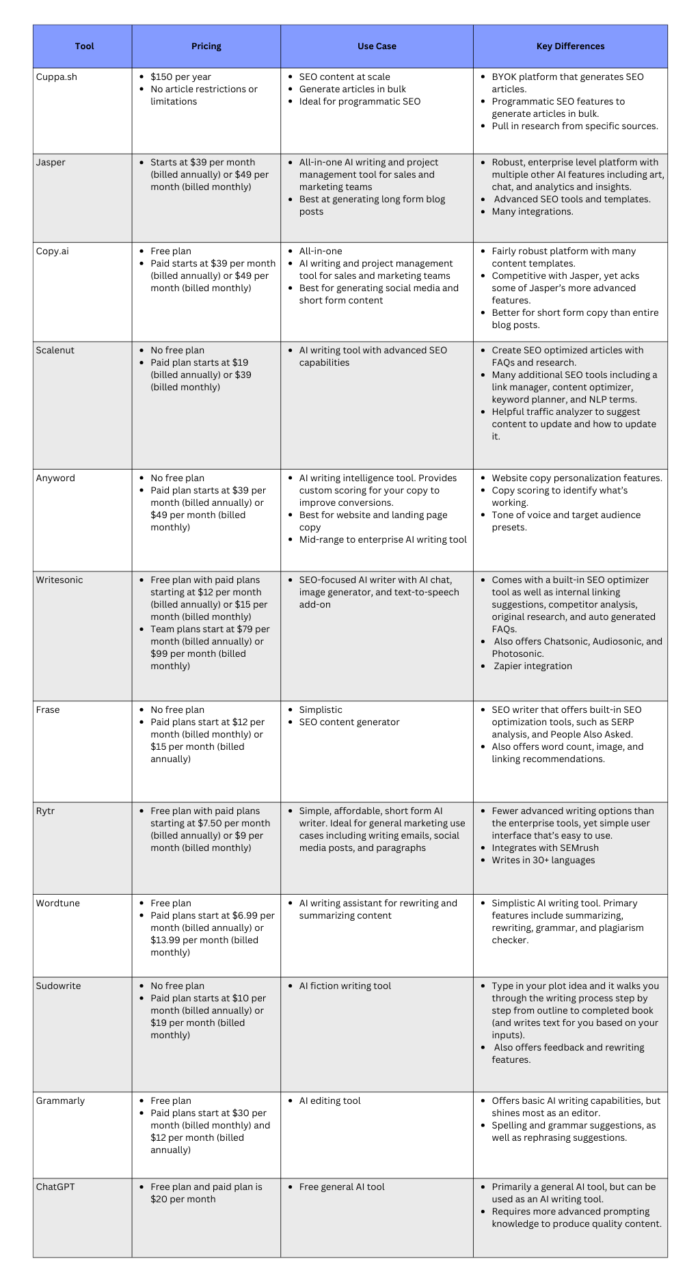
Want us to scale your traffic?
For the first time, The Copyblogger methodology is now available to a select few clients. We know it works. We’ve been doing it since 2006.
1. Cuppa.sh
Cuppa is an AI writing tool designed for SEO professionals.
Its main differentiator from other AI writing tools is that it is a Bring Your Own Keys (BYOK) platform, allowing users to use their own API keys from OpenAI. Therefore, you only pay the price charged by OpenAI, and as OpenAI becomes cheaper, you realize those savings.
Most AI writing tools use their own enterprise API keys, which you must pay for separately.
Cuppa functions similarly to many of the other AI writing tools. You type in a primary keyword and subheaders you want within the article. You can also request it to add research data to any of the subheaders.

Once you have an outline, it writes the article, and then you can either edit it or publish directly on WordPress.
It offers helpful SEO suggestions, like word count, headline and link benchmarks based on the top ranking articles in the SERPs, as well as FAQs, news, and wiki data to add to your article.

Cuppa also generates title and meta descriptions for you.
Once it’s ready to go, you can publish it directly to WordPress through Cuppa’s integration.
It also has a programmatic SEO feature which allows you to generate articles in bulk using its Programmatic Keywords feature:

You can see Cuppa.sh in action here:
It also works with LangChain and other image generators so that you can add your own unique image to your articles.
If you get stuck or need help with your AI writing and content strategy, you can ask questions in the Discord group and receive answers from the community and the Cuppa founders.
Cuppa currently supports 33 languages, and they are constantly expanding the tool’s capabilities.
Jasper is a popular AI writing tool designed for general writing use cases, from SEO blog posts and product descriptions to Facebook and Google ad copy.
To get started, you can create a brief of the marketing campaign you’re working on (e.g., blog post, email, Facebook ad, etc.) using one of their templates.
Then, you can complete the brief by describing the topic, adding keywords, and filling out other details. If you don’t like the initial version of copy Jasper provides, you can always ask it to regenerate that content.
Jasper also offers a Brand Voice feature that allows you to feed the tool your brand’s URL, or copy and paste a selection of text that accurately reflects your brand’s voice. The tool then uses that information to craft content in a similar voice and style.
Jasper is also expanding with project management features, like Kanban boards, and you can add statuses (e.g., “in progress”) and due dates to specific content briefs within Jasper.
Jasper also offers an AI chatbot, which is designed to be a more intelligent and conversational version of a ChatGPT chatbot.
Overall, Jasper is excellent for enterprise teams and it’s one of the highest quality long form content generators.
Copy.ai is a great all around AI content writer that supports a variety of use cases, including ecommerce product descriptions, long form blog posts, social media posts, emails, ad copy, and more.
Like many of the AI writing tools, you can use a template to create an outline for your content. Here’s an example of its blog post template:
Then, it creates a piece of content that you can then edit:
It can also translate your content into multiple languages so that you can reach a wider audience.
Some other features Copy.ai offers include:
- AI chatbot : Copy.ai offers a more intelligent chatbot you can use on your website.
- Brand voice : You can give it your brand’s URL or paste specific text and Copy.ai will use that data to craft copy that matches the same tone and style.
- Infobase : You can upload information like value propositions, brand guidelines, and positioning information so that you can automatically tell the tool to pull accurate data rather than repeatedly typing in the same basic information.
- Security : Unlike ChatGPT, Copy.ai doesn’t train on your data or store any of your prompts.
Copy.ai is a very close competitor to Jasper, so if you’re looking for a robust, all-around AI writing tool, these are likely the two tools you’ll compare.
The main difference between Jasper and Copy.ai is that Jasper tends to be a better long form content writer (e.g., blog posts) whereas Copy.ai tends to have superior short form content (e.g., social media posts).
Another downside of Copy.ai is that it only integrates with Zapier, whereas Jasper integrates with many other tools, such as Google products, Surfer, Webflow, and more.
However, Copy.ai tends to have a more simplistic, easy-to-navigate interface.
4. Scalenut
Scalenut is another robust AI writing tool, and it’s designed primarily for SEO professionals as it contains many features that you might find in a full-fledged SEO tool, like Ahrefs or SEMrush.
To get started with the article writer, type in the topic you want to write about. Then, it provides a variety of more advanced settings, like article type (e.g., listicle, guide, etc.), featured image style, reference articles it can pull research from, and tone of voice.
It then generates title ideas and an outline that you can modify. Once you’re happy with the outline, it will write the article for you:
However, the article writer is just one of Sclaenut’s many writing tools.
It also offers a Content Optimizer feature that you can use to refresh existing content.
Type in the URL of any blog post you want to optimize and the keywords you want it to rank for.
Then, Scalenut provides an SEO score for the URL based on the top-ranking pages and provides keyword, word count, linking, and featured snippet opportunities that you can use to improve your ranking.
It also offers these additional SEO features:
- Keyword Planner : This helps you identify new keywords and build out a topical authority map (a feature that’s not offered at the lowest pricing tier in many SEO tools like Ahrefs).
- Link Manager : This add-on makes it easy to identify new internal linking opportunities and current inbound and outbound links to specific pages.
- Traffic Analyzer : This feature tracks your existing content’s traffic so that you know which pages to update and refresh.
- NLP Terms : Find semantic keywords to add to your content.
Scalenut is evolving into a more complete SEO tool, so it’s excellent if you’re creating SEO-driven content.
However, if you’re already paying for a tool like Ahrefs or SEMrush, it might not be worth the price as you already have access to many of the same features.
Rytr is a great tool if you’re looking for a simple, affordable AI writer that can generate paragraphs and short-form content.
Here are some specific use cases it’s designed for:
- Email writing
- Post captions
- SEO meta information
- Call to actions
- Reply to reviews and messages
Here’s an example of what its internal editor looks like:
Rytr is compact and simple, allowing you to select a language, tone, and use case. You can also ask it to create multiple text versions and rewrite or expand specific sentences.
In general, Rytr is more simplistic than other AI content writers, like Jasper or Copy.ai, as it offers fewer advanced features and templates. For example, it doesn’t yet have templates for specific social media platforms, and it’s primarily designed to produce short form content rather than full blog posts.
It also doesn’t have any project management tools, SEO features, or a chatbot.
Therefore, it’s an affordable AI writing tool if you need an assistant to help you expand your writing or organize your thoughts into a more cohesive structure.
Rytr also integrates with SEMrush and supports over 30 languages.
6. Writesonic
Writesonic is another SEO writing tool that provides various features to help you create more SEO content in less time.
In addition to its article writer, it also has an SEO checker to give you specific suggestions to improve your content’s optimization.
To get started, you type in a topic, select a language, and then select specific sources you want it to reference:
You can also select a primary keyword and secondary keywords, and then it generates an outline. You can either edit the outline or accept it as is, and writesonic will produce your blog post.
Once you’ve produced the article, you can use its SEO checker to optimize the article’s word count and headings and add specific semantic keywords.
It also internally links to other content on your website and integrates with Surfer SEO to further improve your SEO.
It also offers these three features to further improve your SEO:
- Chatsonic : This is a ChatGPT alternative that provides more accurate real-time web search and allows you to ask questions with your own resources, like PDFs, images, websites, and audio files.
- Audiosonic : Writesonic’s AI voice generator that transforms text to speech in over 30 languages, making it an excellent solution for podcast content creation.
- Photosonic : This is its AI art generator. Type in a prompt, and it will generate an image.

Frase is another more basic AI writing tool designed for SEO professionals.
To get started, you enter a topic and then it gives you a list of People Also Asked questions and the outlines of the top ranking posts in the SERPs.
This makes it a handy tool for creating content briefs to ensure that your posts cover the right topics.
Then, it generates an article, and you can further optimize it with its SEO tool:
While it’s an affordable tool, it’s also one of the more basic ones, and users report variable content quality as it can sometimes be repetitive.
It also offers some project management tools and allows you to organize your content in folders within the Frase interface.
Frase also supports the Bring-Your-Own-Token model (BYOK) so that customers can use their own OpenAI keys.
If you’re looking for a basic writing tool that’s affordable and great for outline creation, general blog post writing, and basic SEO optimization, Frase is a good option.
They also have plenty of resources and a community to support you.
Anyword is an AI writing tool that positions itself as a conversion-focused writer. Rather than just creating SEO content, it’s designed to help you optimize your copy (landing pages, product pages, emails, etc.) to convert.
At all pricing tiers, it offers predictive performance scores and analytics designed to help you understand how your copy is performing. It also offers suggestions on how to improve the copy and will generate new copy for you.
To make sure the copy it generates is on-brand, you can create custom target audiences and brand guidelines that the tool then uses to generate copy.
Another handy feature designed to improve website conversions is its hyper-personalization feature. For example, it can show different landing page copy depending on the ad someone clicked on to arrive at that landing page:
To further improve your ads’ performance, it will also document the highest performing ads and then generate copy based on them:
It still offers plenty of marketing templates and prompts to generate your own copy, but it’s much more robust than a traditional AI content writer. It also offers a Google Chrome extension that you can use across the web.
9. Sudowrite
Sudowrite is an excellent tool for journalists and authors writing novels as it emphasizes creativity.
Unlike many of the other AI writing tools, it walks you through the novel writing process step by step and generates the content for you at each step of the process.
Here are a few specific features that make it easy to produce a novel with Sudowrite:
- Describe : Rather than focusing exclusively on dialogue, this feature allows you to tell the tool to include some context about the scene.
- Story Bible : Instead of staring at a blank page, it takes you through the writing process step by step. First, it prompts you to write an idea and then it works with you to generate an outline, and then chapter ideas.
- Write : It analyzes your story arc and characters and then uses the outline to write the story for you.
- Expand : If the pacing feels too fast, you can ask it to expand on a paragraph or section and slow it down.
It also allows you to ask it to rewrite sentences and has an editing feature that provides detailed feedback on characters, story arc, and more.
You can either write in Sudowrite’s interface or use its Google Docs integration.
Finally, they offer a Discord community and live classes to connect with other writers and learn how to use the tool more efficiently.
10. Wordtune
Wordtune is more of an AI writing assistant than a comprehensive writing tool. It allows you to rewrite and rephrase articles, emails, and messages, and you can use it to summarize videos or text.
It also has a grammar checker and proofreading tool to improve completed copy. So it’s great if you want to improve your content, but it isn’t really designed to generate finished copy for you.
Nevertheless, it has plenty of templates to help you get started and can be used for a variety of use cases, like job descriptions, social media posts, and more.
Wordtune offers a Chrome and Microsoft Edge extension.
11. Grammarly
One of the main problems with most AI writing tools is that they still require human editing. So even though Grammarly offers a handful of AI writing tools, it really shines as an editor.
Grammarly goes beyond mere spellcheck and grammar correction. It offers practical suggestions to rephrase sentences and enhance the overall flow of your writing.
You can either paste text into its editor or use the Google Docs extension, though the extension tends to have bugs.
When you open the editor, you can set goals for the content’s intent, audience, and formality.
It then highlights specific sentences that could use improvement and offers suggestions for improving them. Not all of the suggestions are 100% accurate, but most are helpful, and if nothing else, it points out sentences that are poorly phrased.
Using Grammarly also helps you become a better writer as you’ll begin to recognize your common grammar mistakes.
You can also turn on the Chrome plugin and Grammarly will highlight grammar mistakes in your emails, social media posts, and any other text you write.
Pricing
12. ChatGPT
ChatGPT is one of the most convenient AI writing tools as most people are already familiar with it and use it for other use cases.
ChatGPT 3.5 is free, and ChatGPT 4 is only $20 per month, which tends to be more accurate and allows you to use plugins and generate images.
The main drawback of ChatGPT is that even the paid version is somewhat repetitive, and it generally produces lower-quality content. For example, you can’t create voice presets, and it’s not really designed to generate entire articles. Instead, it’s generally best to ask it to produce an outline for a specific blog post you have in mind and then ask it to write it out paragraph by paragraph.
Additionally, ChatGPT isn’t designed as an SEO tool, so it won’t provide access optimization scores or tools to help your content rank higher. Nevertheless, if you’re excellent at prompting, you can ask it to look at the top ranking posts for your primary keyword and then provide optimization suggestions.
The other downside of ChatGPT is that it tends to hallucinate and isn’t always correct.
Therefore, you can use ChatGPT to produce outlines and help you get your thoughts on paper, though it’s important to go back and edit everything it produces. You can even copy the text, paste it into Grammarly and edit it using Grammarly’s suggestions.
Get More Help With Your Content Marketing
These AI writing tools make writing easier, but they aren’t perfect, and you’ll still have to edit all of them manually.
Additionally, because these tools make it easier to mass produce content, it’s more important than ever before to improve your skills as a strategist and understand the type of content your audience wants and the specific questions they need answered.
We have plenty of resources on building an audience , constructing an effective content marketing strategy , and delivering quality content, but if you want more personalized help, consider joining the Copyblogger Academy . It’s a course and community run by seven figure entrepreneurs Tim Stoddart and Charles Miller. Inside, you’ll have access to nine different marketing courses, including SEO, content marketing, email marketing, and personal branding and you can always submit your work for feedback and ask questions in the community.
We even have accountability meetings to ensure you’re on track to meet your goals. You can join the Copyblogger Academy today, and we’ll give you a full refund if you aren’t 100% satisfied.
Megan Mahoney
Megan is the head of SEO for Copyblogger. In addition, she runs the content agency Ignite My Site . You can follow here on LinkedIn.
- Copyblogger Academy - The Copyblogger Academy is a premier membership program that gives you the tools and skillset to turn your writing into income. Join 1300+ members inside.
- Content Marketing - We're Digital Commerce Partners, Copyblogger's Content Marketing & SEO Agency. Fill out this form to apply for our program.
- Promote yourself to 100,000+ subscribers by sponsoring our newsletter.
Reader Interactions
Reader comments (1).
June 20, 2024 at 11:07 am
Great article! It does an excellent job breaking down each AI writing tool’s unique features and benefits. As someone always looking for ways to enhance my writing workflow, I found the comparisons very helpful.
Thanks Megan!
Comments are open for two weeks.
Leave a Comment Cancel reply
Your email address will not be published. Required fields are marked *
Save my name, email, and website in this browser for the next time I comment.
Get free access to proven marketing training.
Apple Intelligence Preview

AI for the rest of us.
Coming in beta this fall *

Built into your iPhone, iPad, and Mac to help you write, express yourself, and get things done effortlessly.
Draws on your personal context while setting a brand-new standard for privacy in AI.

Write with intelligent new tools. Everywhere words matter.
Apple Intelligence powers new Writing Tools, which help you find just the right words virtually everywhere you write. With enhanced language capabilities, you can summarize an entire lecture in seconds, get the short version of a long group thread, and minimize unnecessary distractions with prioritized notifications.
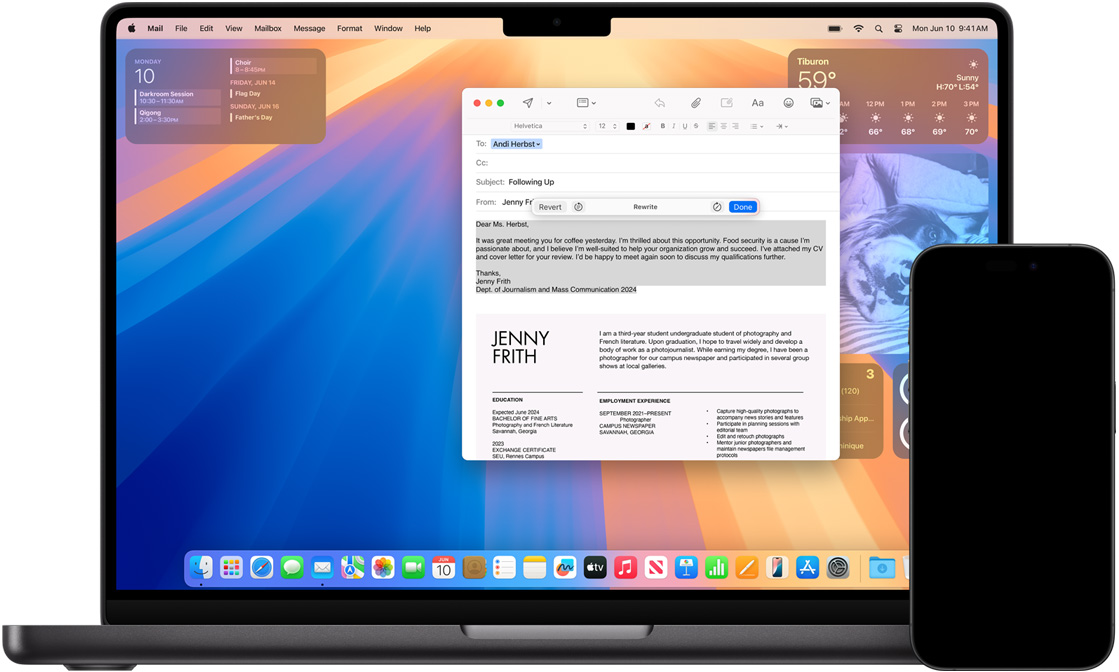
Explore new features for writing, focus, and communication.
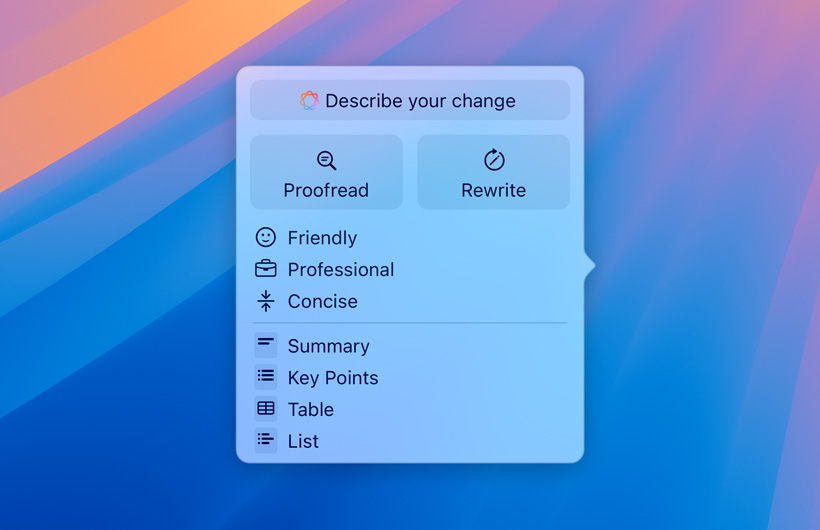
Transform how you communicate using intelligent Writing Tools that can proofread your text, rewrite different versions until the tone and wording are just right, and summarize selected text with a tap. Writing Tools are available nearly everywhere you write, including third-party apps.

Priority notifications appear at the top of the stack, letting you know what to pay attention to at a glance. And notifications are summarized, so you can scan them faster.
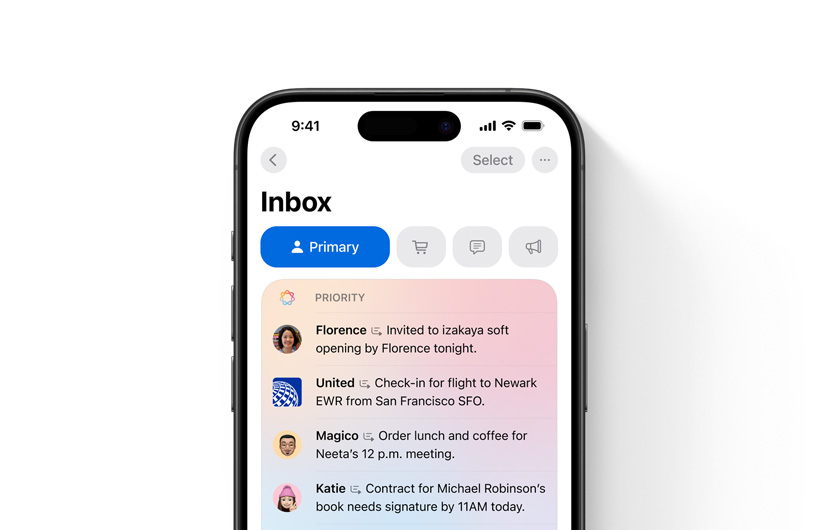
Priority messages in Mail elevate time-sensitive messages to the top of your inbox — like an invitation that has a deadline today or a check-in reminder for your flight this afternoon.

Tap to reveal a summary of a long email in the Mail app and cut to the chase. You can also view summaries of email right from your inbox.
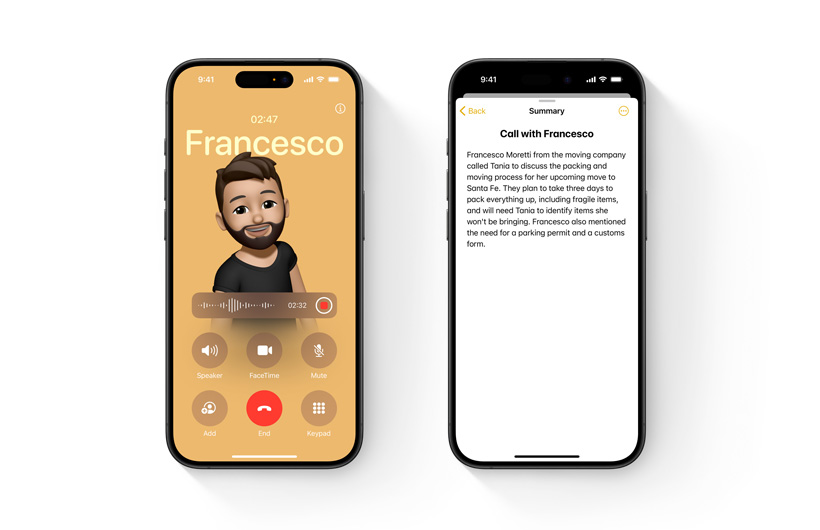
Just hit record in the Notes or Phone apps to capture audio recordings and transcripts. Apple Intelligence generates summaries of your transcripts, so you can get to the most important information at a glance.

Reduce Interruptions is an all-new Focus that understands the content of your notifications and shows you the ones that might need immediate attention, like a text about picking up your child from daycare later today.

Use a Smart Reply in Mail to quickly draft an email response with all the right details. Apple Intelligence can identify questions you were asked in an email and offer relevant selections to include in your response. With a few taps you’re ready to send a reply with key questions answered.
Delightful images created just for you.
Apple Intelligence enables delightful new ways to express yourself visually. Create fun, original images and brand-new Genmoji that are truly personal to you. Turn a rough sketch into a related image that complements your notes with Image Wand. And make a custom memory movie based on the description you provide.

Create expressive images, unique Genmoji, and custom memory movies.
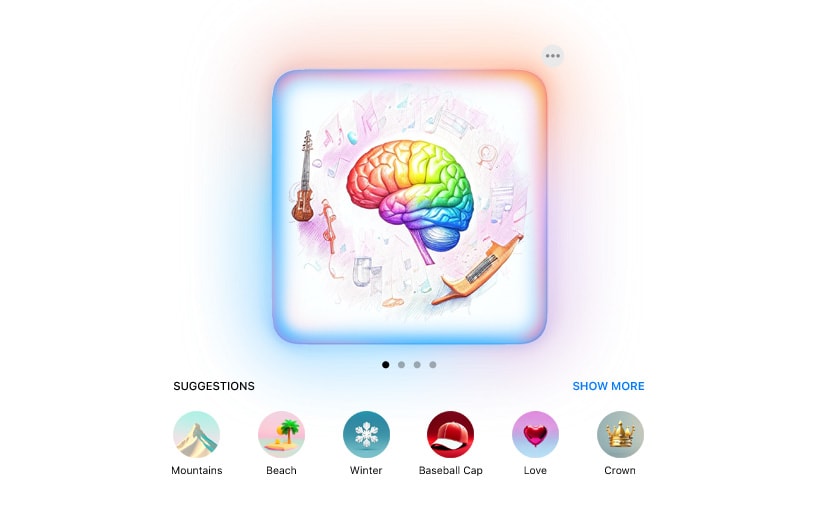
Produce fun, original images in seconds with the Image Playground experience right in your apps. Create an entirely new image based on a description, suggested concepts, and even a person from your Photos library. You can easily adjust the style and make changes to match a Messages thread, your Freeform board, or a slide in Keynote.

Experiment with different concepts and try out image styles like animation, illustration, and sketch in the dedicated Image Playground app . Create custom images to share with friends in other apps or on social media.
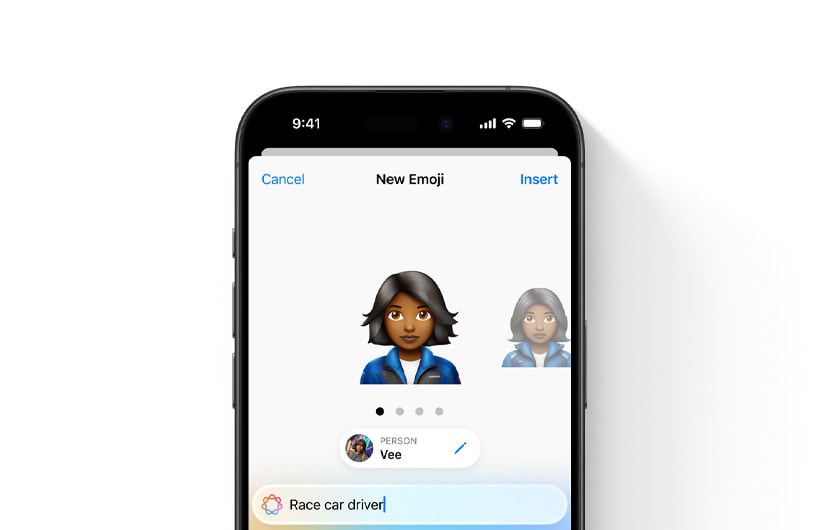
Make a brand-new Genmoji right in the keyboard to match any conversation. Provide a description to see a preview, and adjust your description until it’s perfect. You can even pick someone from your Photos library and create a Genmoji that looks like them.
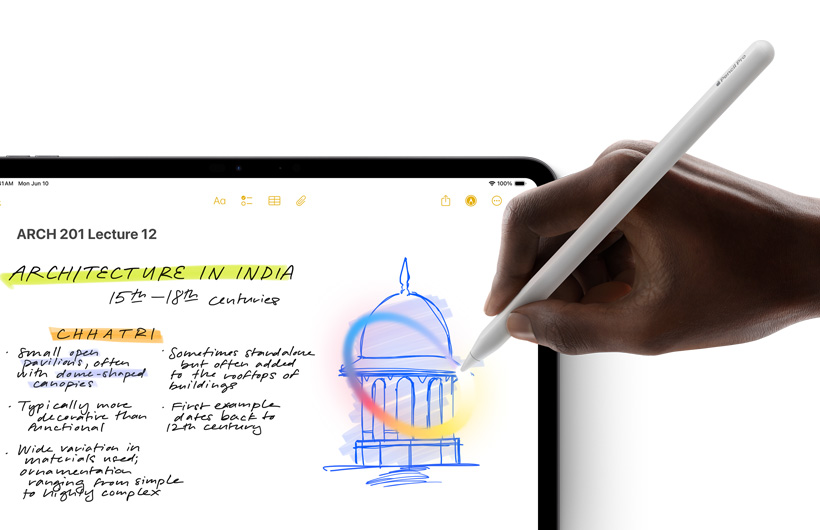
Image Wand can transform your rough sketch into a related image in the Notes app. Use your finger or Apple Pencil to draw a circle around your sketch, and Image Wand will analyze the content around it to produce a complementary visual. You can even circle an empty space, and Image Wand will use the surrounding context to create a picture.

Create a custom memory movie of the story you want to see, right in Photos. Enter a description, and Apple Intelligence finds the best photos and videos that match. It then crafts a storyline with unique chapters based on themes it identifies and arranges your photos into a movie with its own narrative arc.

Search for photos and videos in the Photos app simply by describing what you’re looking for. Apple Intelligence can even find a particular moment in a video clip that fits your search description and take you right to it.

Remove distractions in your photos with the Clean Up tool in the Photos app. Apple Intelligence identifies background objects so you can remove them with a tap and perfect your shot — while staying true to the original image.
The start of a new era for Siri.
Siri draws on Apple Intelligence for all-new superpowers. With an all-new design, richer language understanding, and the ability to type to Siri whenever it’s convenient for you, communicating with Siri is more natural than ever. Equipped with awareness of your personal context, the ability to take action in and across apps, and product knowledge about your devices’ features and settings, Siri will be able to assist you like never before.
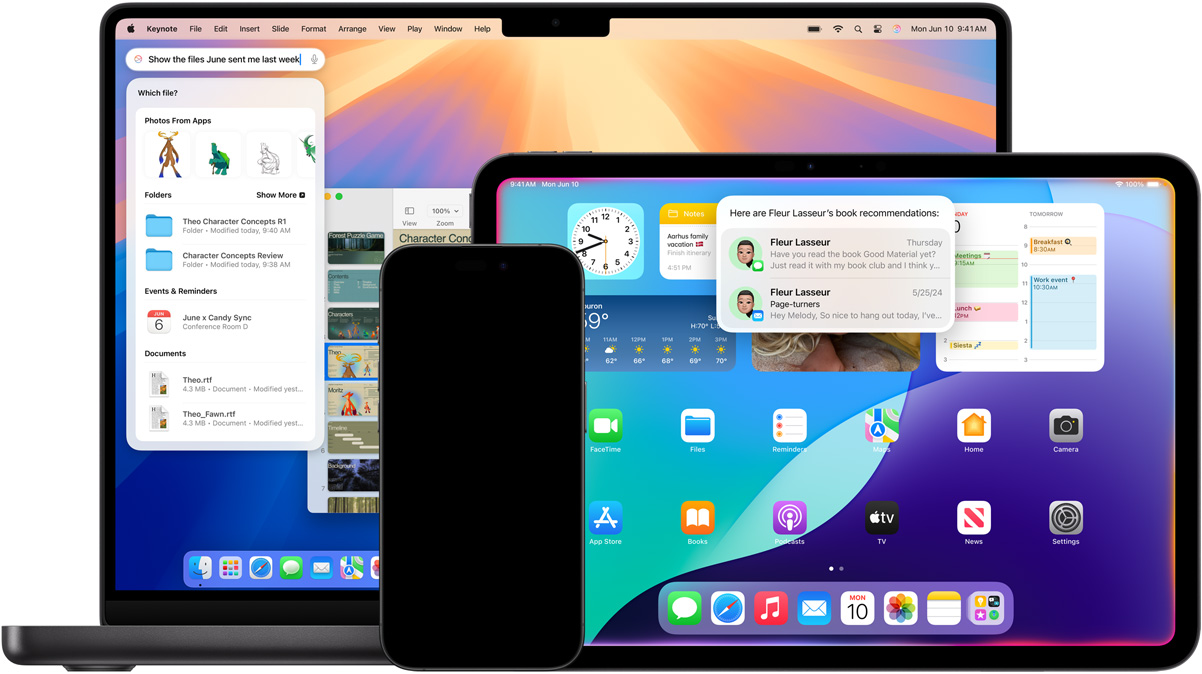
Discover an even more capable, integrated, personal Siri.

Siri has an all-new design that’s even more deeply integrated into the system experience, with an elegant, glowing light that wraps around the edge of your screen.

With a double tap on the bottom of your iPhone or iPad screen, you can type to Siri from anywhere in the system when you don’t want to speak out loud.
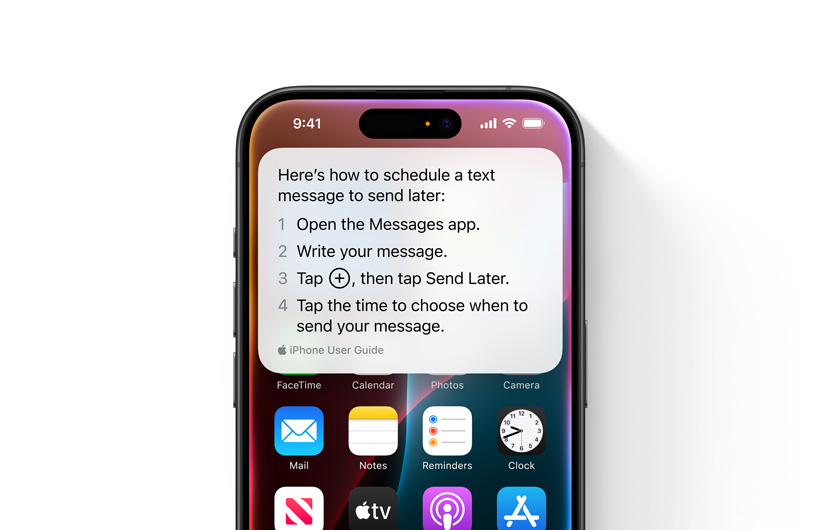
Tap into the expansive product knowledge Siri has about your devices’ features and settings. You can ask questions when you’re learning how to do something new on your iPhone, iPad, and Mac, and Siri can give you step-by-step directions in a flash.
Siri, set an alarm for — oh wait no, set a timer for 10 minutes. Actually, make that 5.
Richer language understanding and an enhanced voice make communicating with Siri even more natural. And when you refer to something you mentioned in a previous request, like the location of a calendar event you just created, and ask ”What will the weather be like there?” Siri knows what you’re talking about.
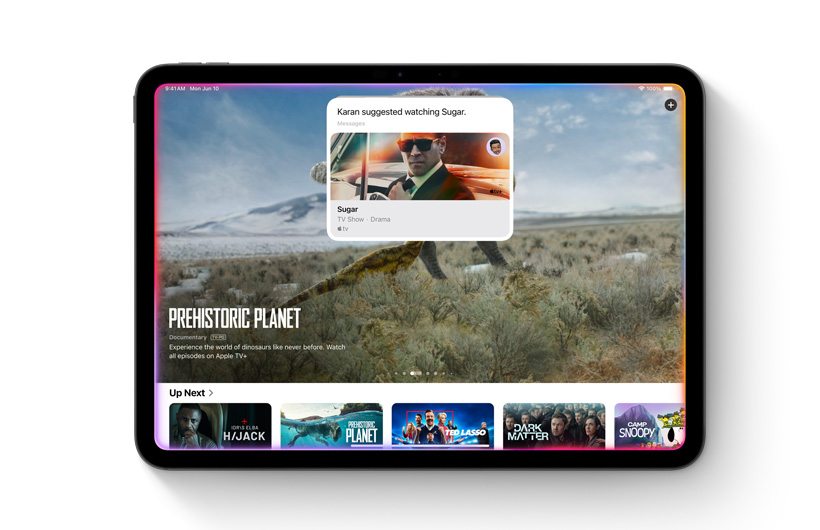
Apple Intelligence empowers Siri with onscreen awareness , so it can understand and take action with things on your screen. If a friend texts you their new address, you can say “Add this address to their contact card,” and Siri will take care of it.

Awareness of your personal context enables Siri to help you in ways that are unique to you. Can’t remember if a friend shared that recipe with you in a note, a text, or an email? Need your passport number while booking a flight? Siri can use its knowledge of the information on your device to help find what you’re looking for, without compromising your privacy.

Seamlessly take action in and across apps with Siri. You can make a request like “Send the email I drafted to April and Lilly” and Siri knows which email you’re referencing and which app it’s in. And Siri can take actions across apps, so after you ask Siri to enhance a photo for you by saying “Make this photo pop,” you can ask Siri to drop it in a specific note in the Notes app — without lifting a finger.
Great powers come with great privacy.
Apple Intelligence is designed to protect your privacy at every step. It’s integrated into the core of your iPhone, iPad, and Mac through on-device processing. So it’s aware of your personal information without collecting your personal information. And with groundbreaking Private Cloud Compute, Apple Intelligence can draw on larger server-based models, running on Apple silicon, to handle more complex requests for you while protecting your privacy.
Private Cloud Compute
- Your data is never stored
- Used only for your requests
- Verifiable privacy promise

ChatGPT, seamlessly integrated.
With ChatGPT from OpenAI integrated into Siri and Writing Tools, you get even more expertise when it might be helpful for you — no need to jump between tools. Siri can tap into ChatGPT for certain requests, including questions about photos or documents. And with Compose in Writing Tools, you can create and illustrate original content from scratch.
You control when ChatGPT is used and will be asked before any of your information is shared. Anyone can access ChatGPT for free, without creating an account. ChatGPT subscribers can connect accounts to access paid features within these experiences.
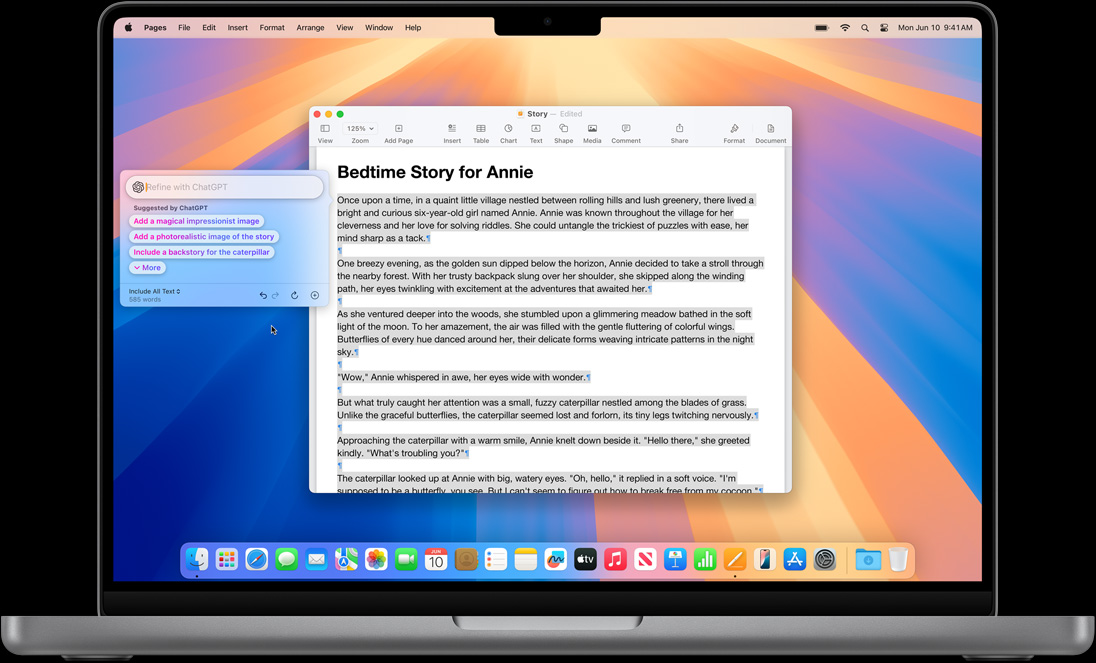
New possibilities for your favorite apps.
New App Intents, APIs, and frameworks make it incredibly easy for developers to integrate system-level features like Siri, Writing Tools, and Image Playground into your favorite apps.
Learn more about developing for Apple Intelligence
Apple Intelligence is compatible with these devices.
Apple Intelligence is free to use and will initially be available in U.S. English. Coming in beta this fall. *
- iPhone 15 Pro Max A17 Pro
- iPhone 15 Pro A17 Pro
- iPad Pro M1 and later
- iPad Air M1 and later
- MacBook Air M1 and later
- MacBook Pro M1 and later
- iMac M1 and later
- Mac mini M1 and later
- Mac Studio M1 Max and later
- Mac Pro M2 Ultra

COMMENTS
Authorea - Best for Alternative Publication and Exposure. Authorea is this writing tool is a one-stop-shop for you to a) create/upload, b) disseminate your research paper, and c) get published in top journals. Authorea is great for young researchers who want to publish their academic work.
That's it: 19 academic writing apps and scientific research tools to support your writing for free! However, the best academic writing software won't make you more productive if you don't rely on a streamlined writing process and if you aren't using your writing sessions effectively. If you want to get your hands on a template to write ...
In this post, we have pulled together 8 tools and resources that will help you work better and smarter when writing a research paper. Our downloadable comprehensive free guide: Writing your paper. Todoist: A to-do list to organize your work. Evernote: As a research notebook. Grammarly: Cloud based typing assistant.
Research management tools. Research management can be a complex and challenging process. Some tools address the various challenges that arise when referencing and managing papers. Zotero. Coined as a personal research assistant, Zotero is a tool that brings efficiency to the research process. Zotero helps researchers collect, organize, annotate ...
4. Grammar Checkers and Sentence Correction Tools. 1. Writing Tools and Software. Whether you are writing an article, research paper, essay, blog, and dissertation or PhD thesis, it is important to choose an appropriate writing software tool for your work. The choice of writing software comes down to your personal taste.
research assistant. Zotero is a free, easy-to-use tool to help you collect, organize, annotate, cite, and share research. Download. Available for Mac, Windows, Linux, and iOS. Just need to create a quick bibliography? Try ZoteroBib.
Welcome to the transformative world of AI-powered research tools! This blog post will dive deeper into these tools, providing a detailed review of how AI is revolutionizing academic research. ... AI tools for grant writing. In the challenging realm of science grant writing, two innovative AI tools are making waves: Granted AI and Grantable.
Create a research paper outline. Write a first draft of the research paper. Write the introduction. Write a compelling body of text. Write the conclusion. The second draft. The revision process. Research paper checklist. Free lecture slides.
Typeset. Typeset is a great tool when it comes to writing your own research papers. You can upload all your references for simple citations and check your work for spelling errors and plagiarism. Typeset also offers features to collaborate with your teammates and get the work done together. 2. Google Scholar.
Delivered to your inbox every two weeks, the Writing Toolbox features practical advice and tools you can use to prepare a research manuscript for submission success and build your scientific writing skillset. Discover how to navigate the peer review and publishing process, beyond writing your article.
Our Commitment: Academic Honesty. Jenni AI is committed to upholding academic integrity. Our tool is designed to assist, not replace, your effort in research and writing. We strongly discourage any unethical use. We're dedicated to helping you excel in a responsible and ethical manner.
6. Scrivener. Scrivener is another great tool for research writing and keeping your notes organized. Used by researchers, screenwriters, novelists, non-fiction writers, students, journalists, academics, lawyers, translators, and more, Scrivener is a tool made for long writing projects.
These tools will streamline your research process, help you stay organized, and provide you with easy access to the information you need. ... The range of things academic writing tools can do for you is astonishing - language editing, abstract writing, plagiarism checking and so much more! While there are a number of online tools for ...
4. Elicit.org. Elicit.org is an AI-powered tool designed to streamline the research process by assisting in conducting comprehensive literature reviews and extracting relevant data from various sources. It is one of the top AI writing tools for academic research that has been embraced by researchers worldwide.
Andy Tay. Credit: gmast3r/Getty Images. Writing tools powered by artificial intelligence (AI) have the potential to reduce manuscript preparation time to a few days, or hours. Deep-learning ...
Paperpal is the perfect AI academic writing tool for researchers that enhances and speeds up the academic writing process. Create Publish-ready papers with AI for research paper writing solutions. Get instant grammar check and subject-specific suggestions to make your research paper submission ready. Paperpal is trusted by top global publishers and authors across 125 countries.
Research methods are specific procedures for collecting and analyzing data. Developing your research methods is an integral part of your research design. When planning your methods, there are two key decisions you will make. First, decide how you will collect data. Your methods depend on what type of data you need to answer your research question:
1. SciSpace Literature Review. SciSpace's Literature Review tool is designed for researchers to conduct systematic literature reviews efficiently. This AI research tool helps you compare and contrast scientific papers, and extract key information, themes, patterns, and concepts of numerous research papers in minutes, all in one single workspace.
Petal is the world's first and only AI-powered reference manager. Using OpenAI's GPT-3 language model (same engine as chatGPT), Petal enables direct and dynamic interaction with your research library. Automatic metadata extraction. Drag & drop, import existing reference lists (BibTeX), and create collections to stay organized.
Write with confidence, powered by AI. Get perfect spelling, grammar, and punctuation. Sound fluent, professional, and natural. Fine-tune your writing with word and sentence alternatives. Choose a writing style and tone that fits your audience. DeepL Write is a tool that helps you perfect your writing. Write clearly, precisely, with ease, and ...
5. Milanote. Cost: Free for basic plan or $12.50/month for premium. Milanote is an easy-to-use creative writing app to organize your research, ideas, characters and outline in one place. The vast majority of novelist-oriented writing software is organized around the idea of a linear document.
This research and writing tool automatically completes sentences, creates tone and style, cites in multiple styles, paraphrases and rewrites. PaperPal This tool offers real-time, subject specific language suggestions to help you write better and faster.
There are online research tools that create lists of the most cited scientific articles. 🌐. Google Scholar. The same company that produced the world's top search engine also offers the world's top scholarly search engine. Google Scholar works just like Google.
In the database, we found 131 AI tools useful for literature reviews, summaries or writing. As many as 146 AI tools are useful for data collection or analysis, and 108 are useful for research ...
Enhance your academic writing with our free writing assistant, a generative AI-powered academic writing tool. Key features - AI Language suggestions, academic translation, grammar checker, english language check, paraphraser, free essay checker and text reducer tool. Try our online AI academic writing tool that checks language errors and provides instant, in-depth suggestions to help you ...
Write Blogs - the AI can write long blog posts. For best results, I recommend that you first ask it to create a blog outline. Then, ask it to write the article based on that outline. If you need more apps, all you need to do is click on EXPLORE GPTs. You will see so many 3 rd-party apps for writing, productivity, research, analysis, and many ...
Try using these generative AI tools to write cover letters, business reports, job descriptions, and more. Just enter some instructions and get compelling, mistake-free AI writing that's tailored to your goals.
Currently, there is a lack of comprehensive reviews on the available AI-powered writing assistance tools and their pedagogical implications. Existing reviews that are related to the use of writing assistance tools have focused either on the use of individual tools in their early versions prior to AI integration, or on a specific type of writing assistance tools.
Cuppa is an AI writing tool designed for SEO professionals. Its main differentiator from other AI writing tools is that it is a Bring Your Own Keys (BYOK) platform, allowing users to use their own API keys from OpenAI. Therefore, you only pay the price charged by OpenAI, and as OpenAI becomes cheaper, you realize those savings.
Apple Intelligence powers new Writing Tools, which help you find just the right words virtually everywhere you write. With enhanced language capabilities, you can summarize an entire lecture in seconds, get the short version of a long group thread, and minimize unnecessary distractions with prioritized notifications.